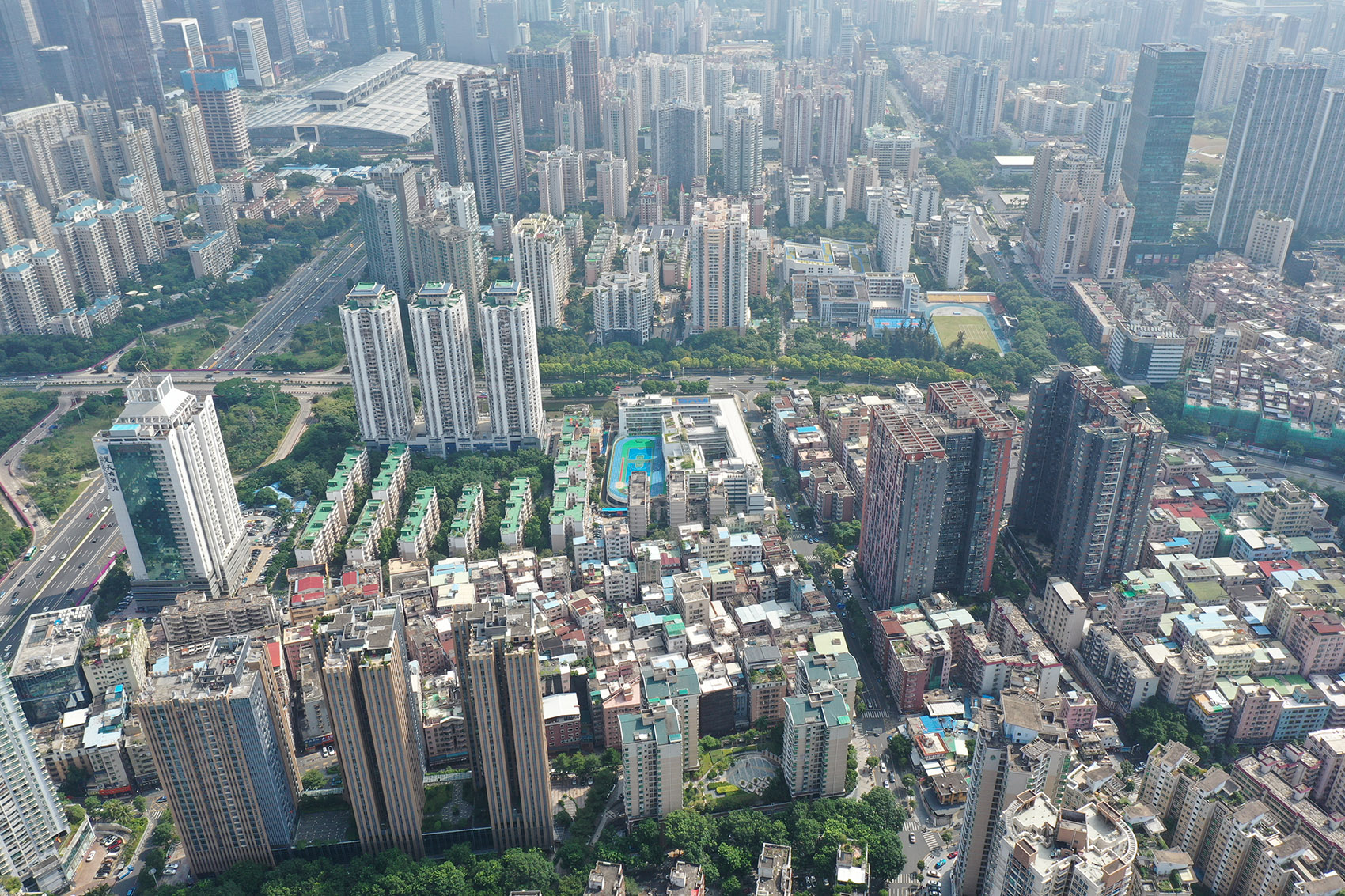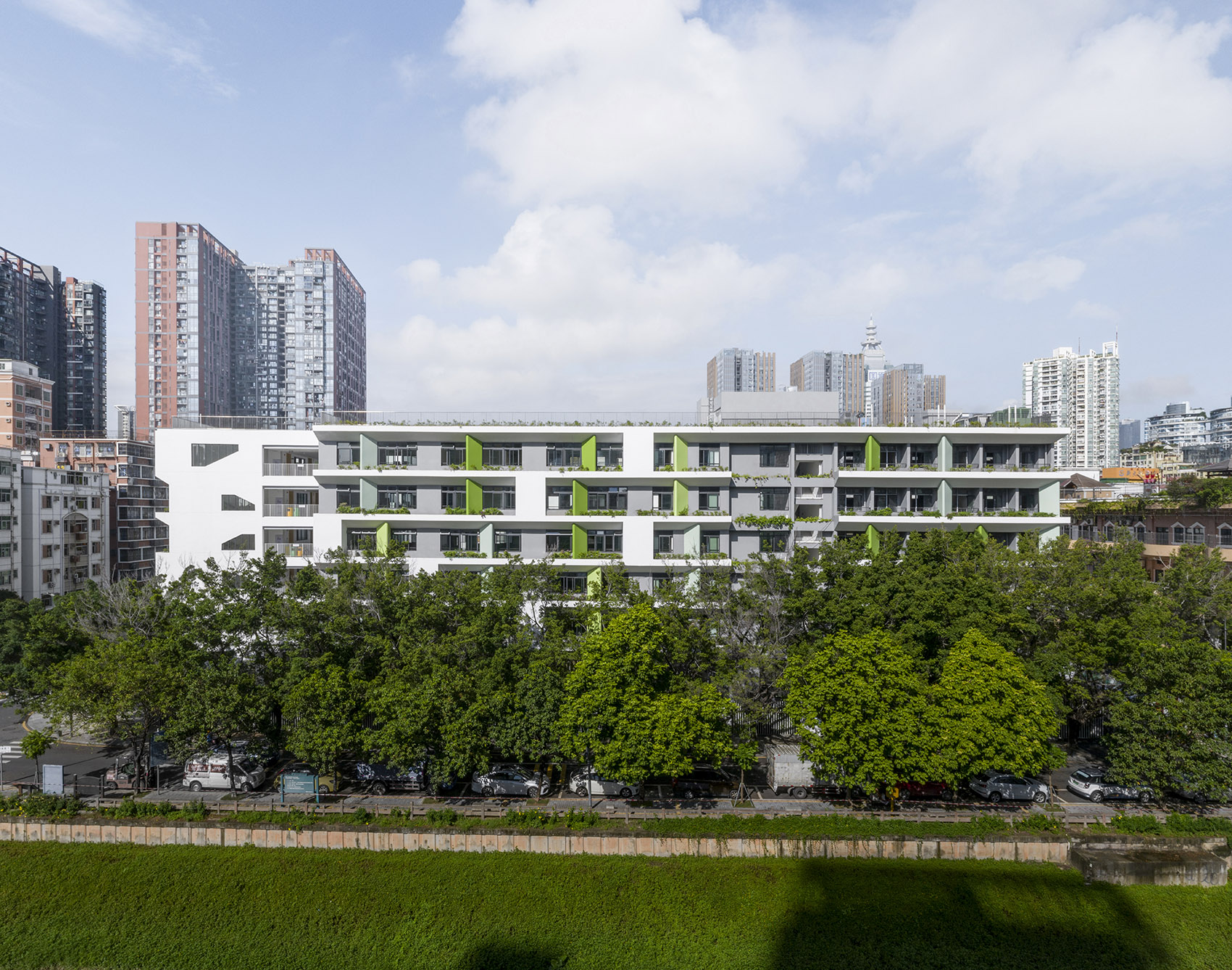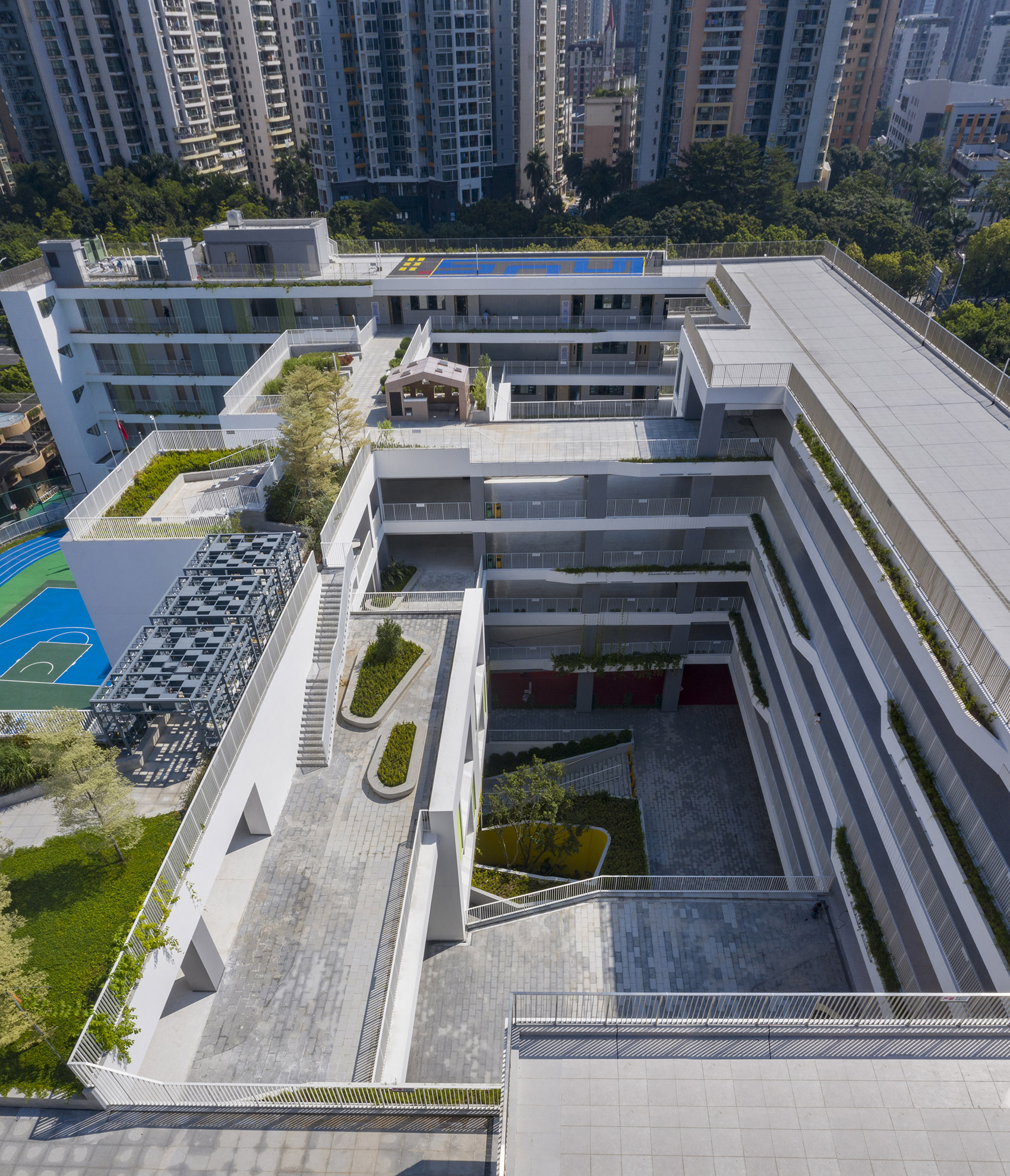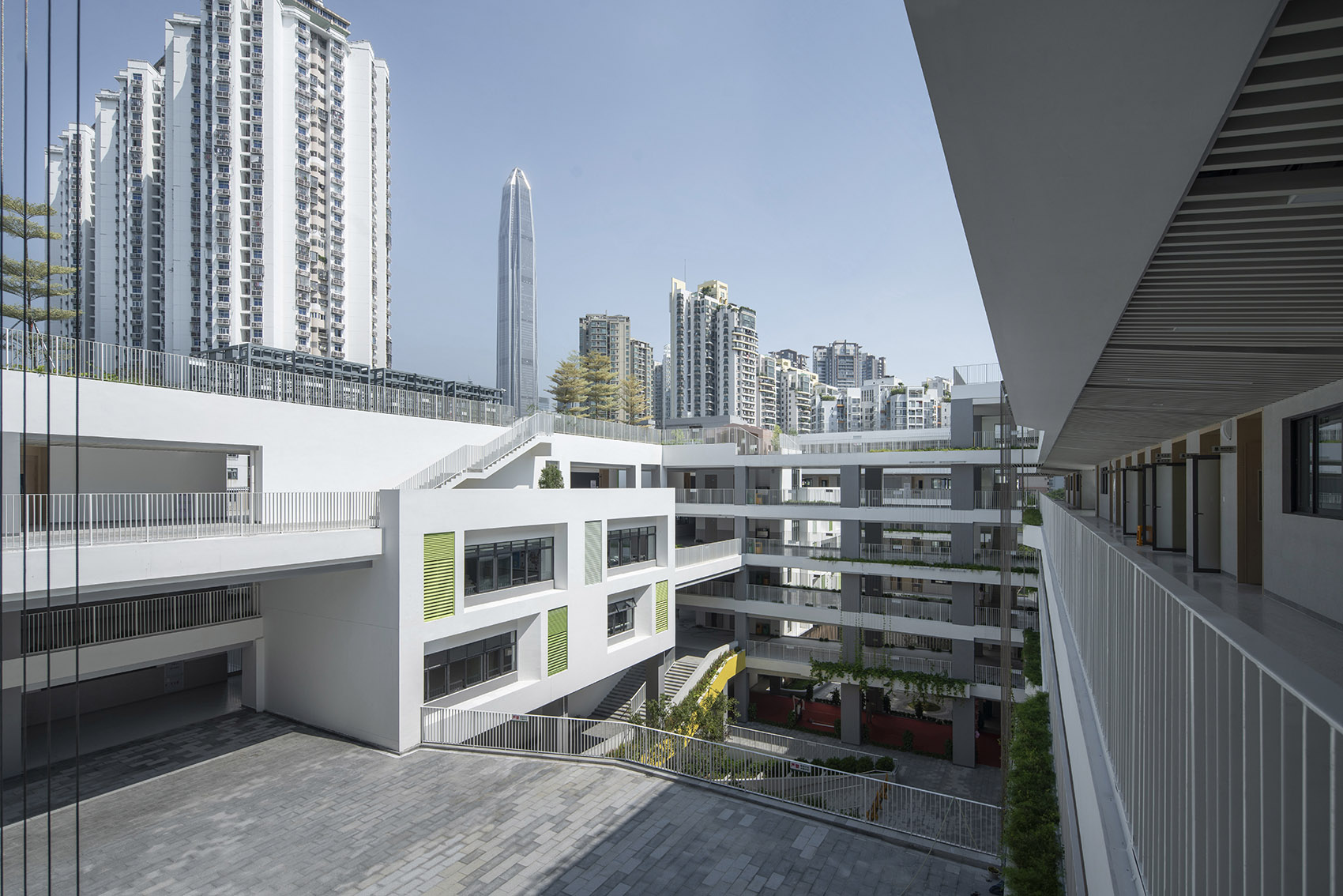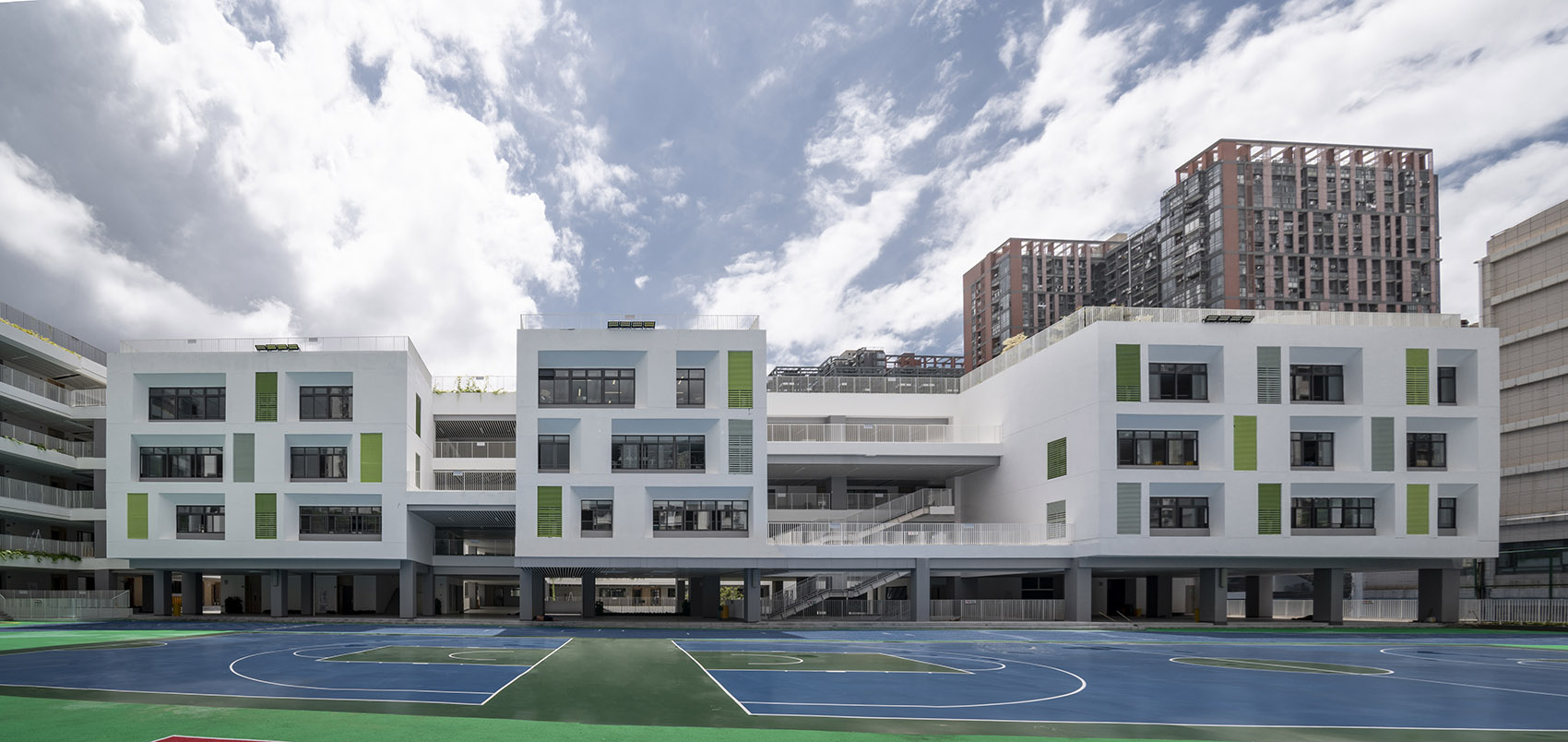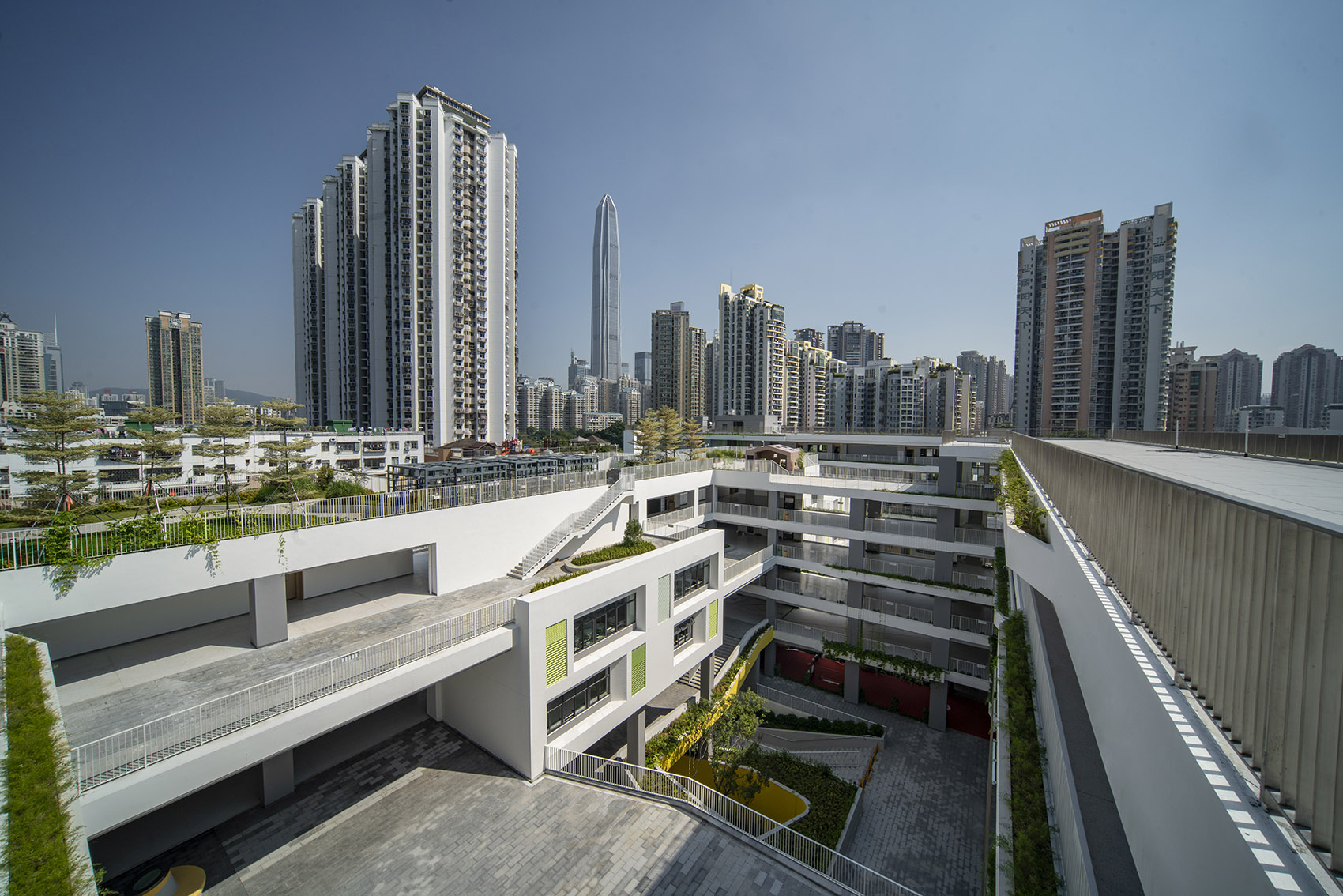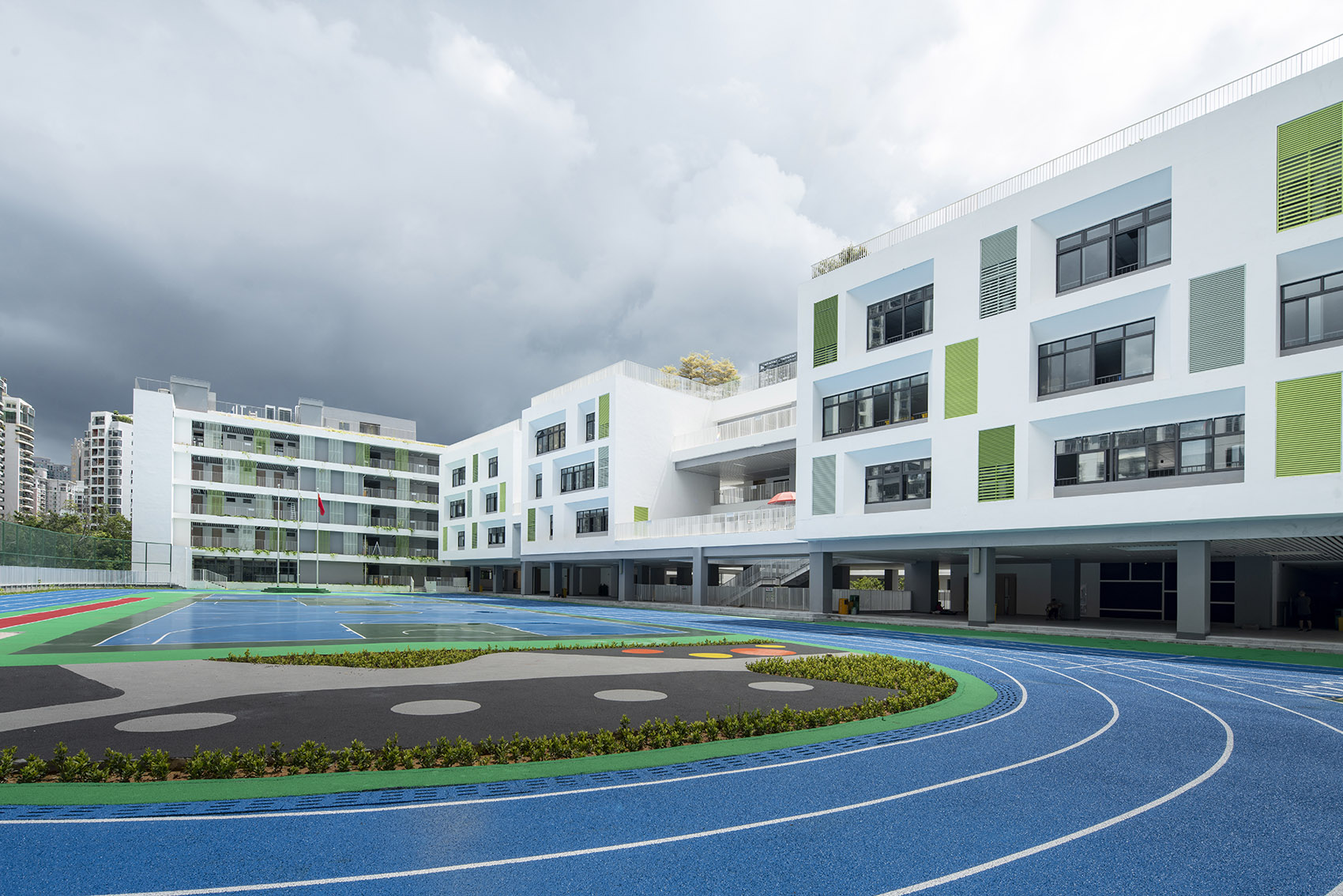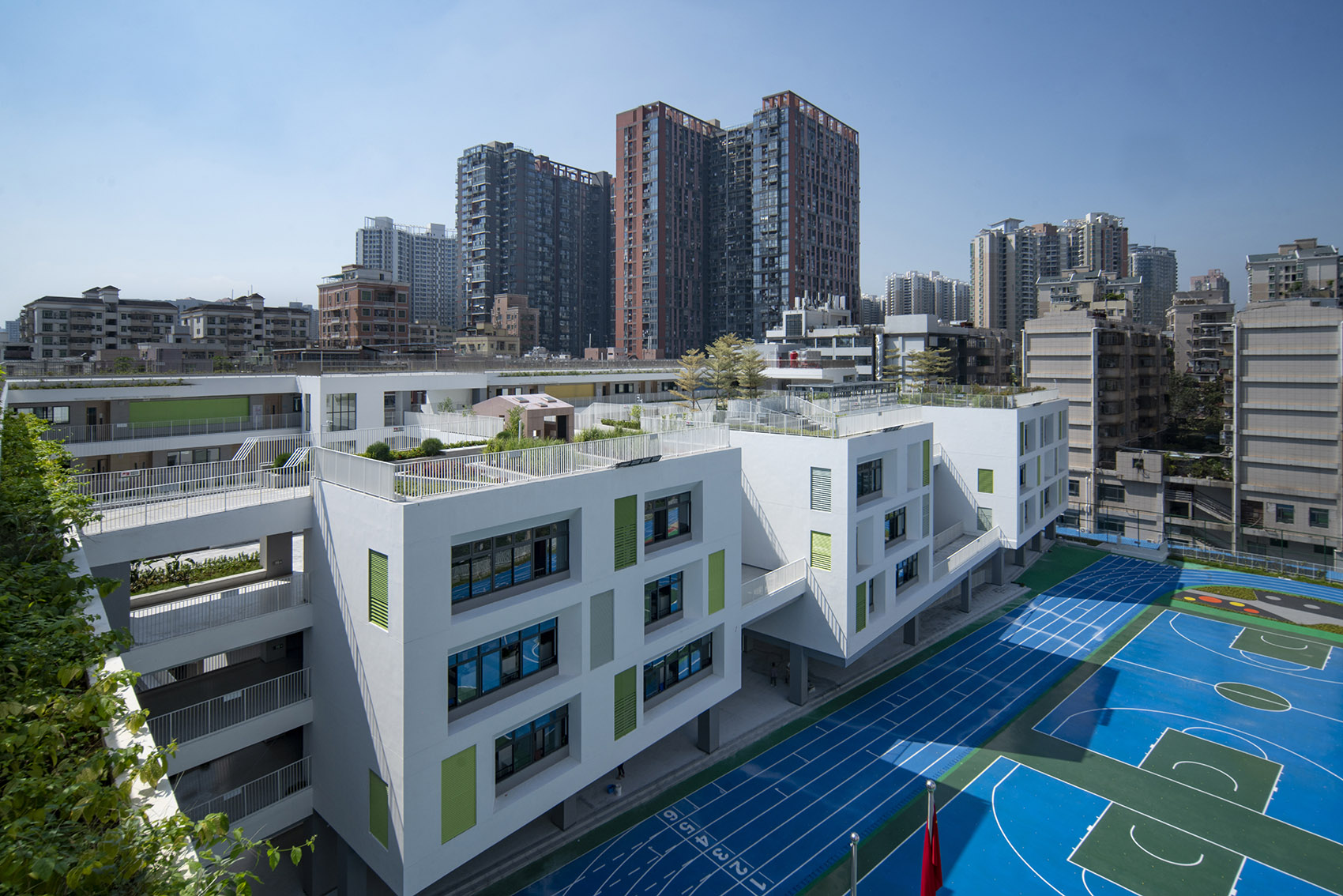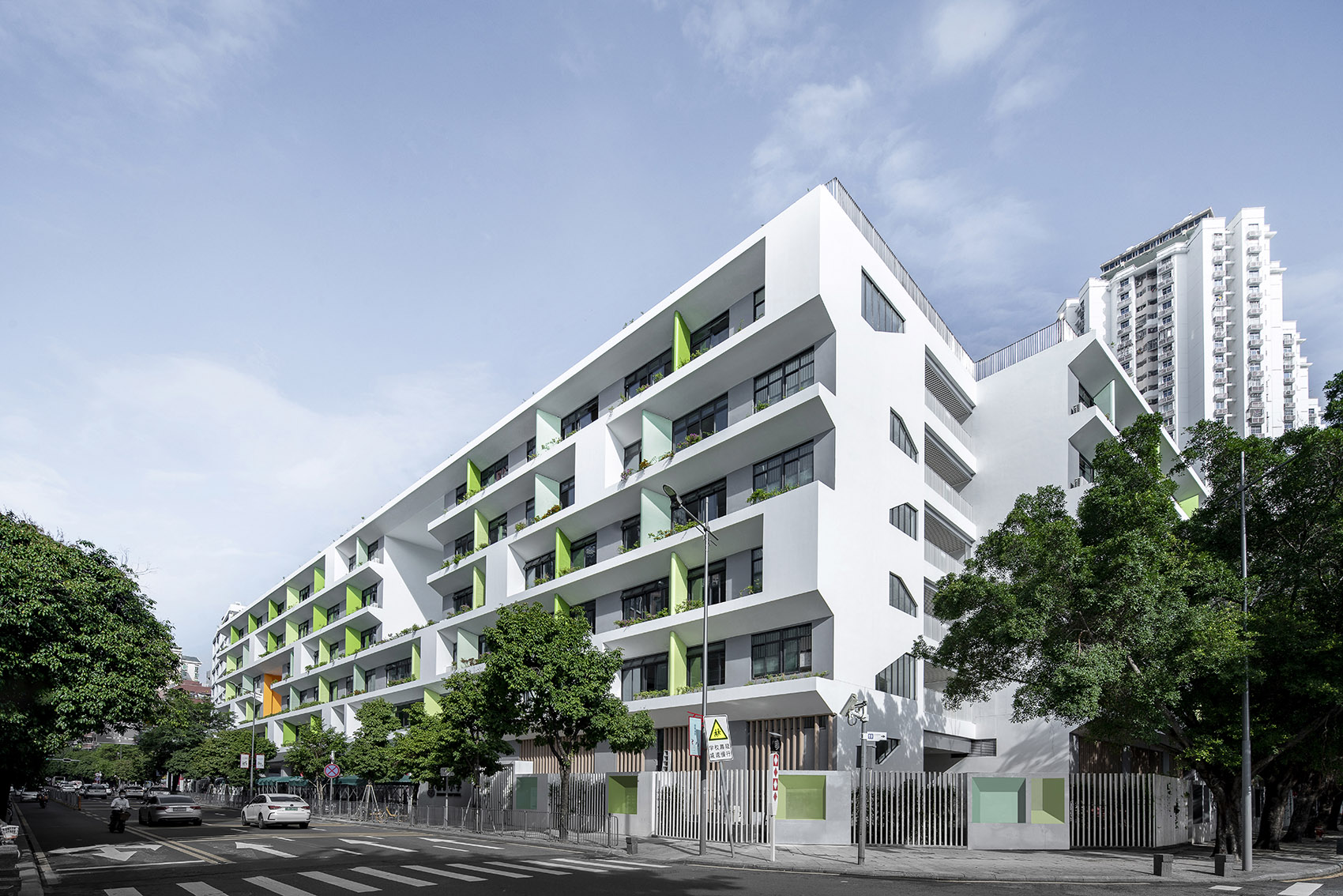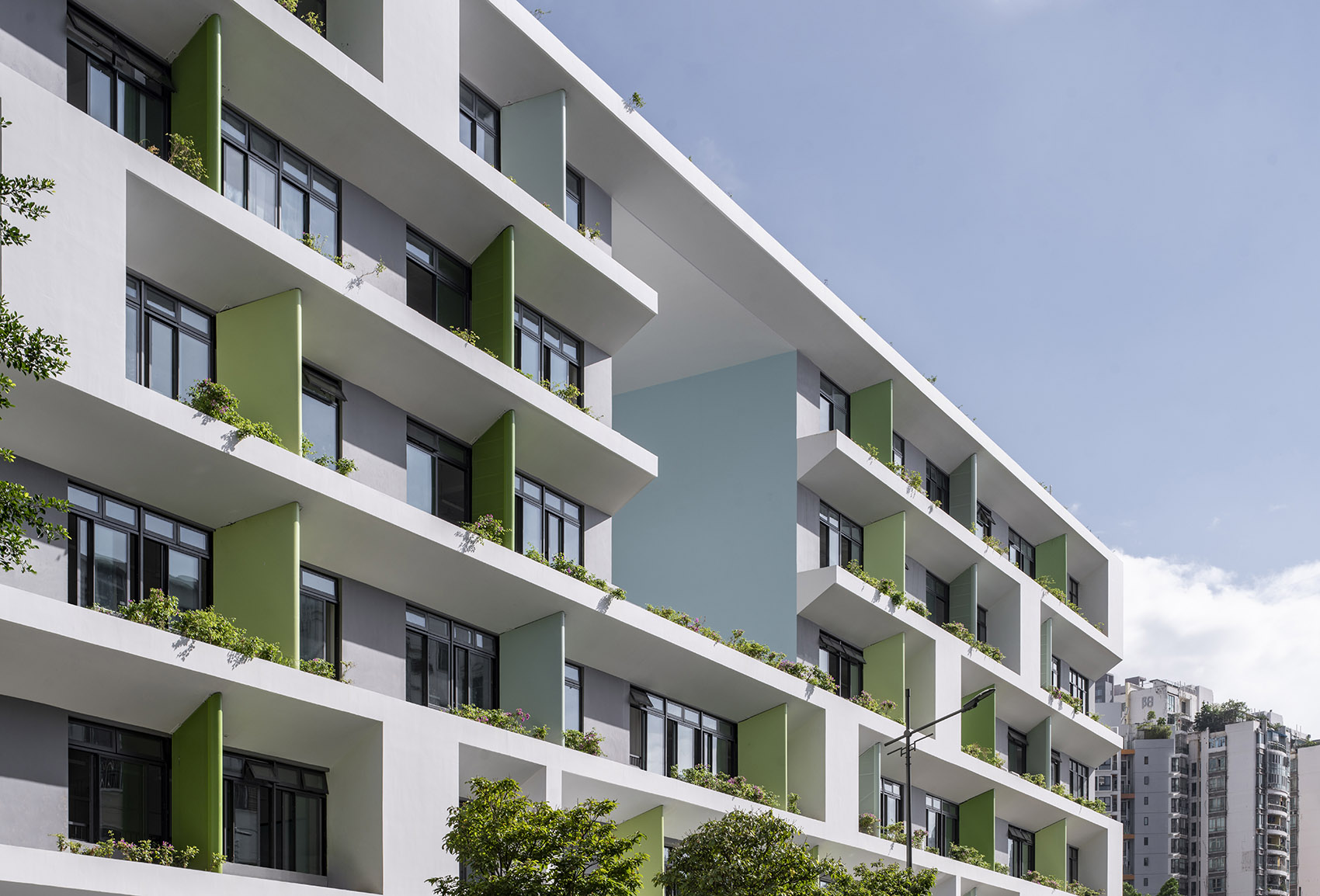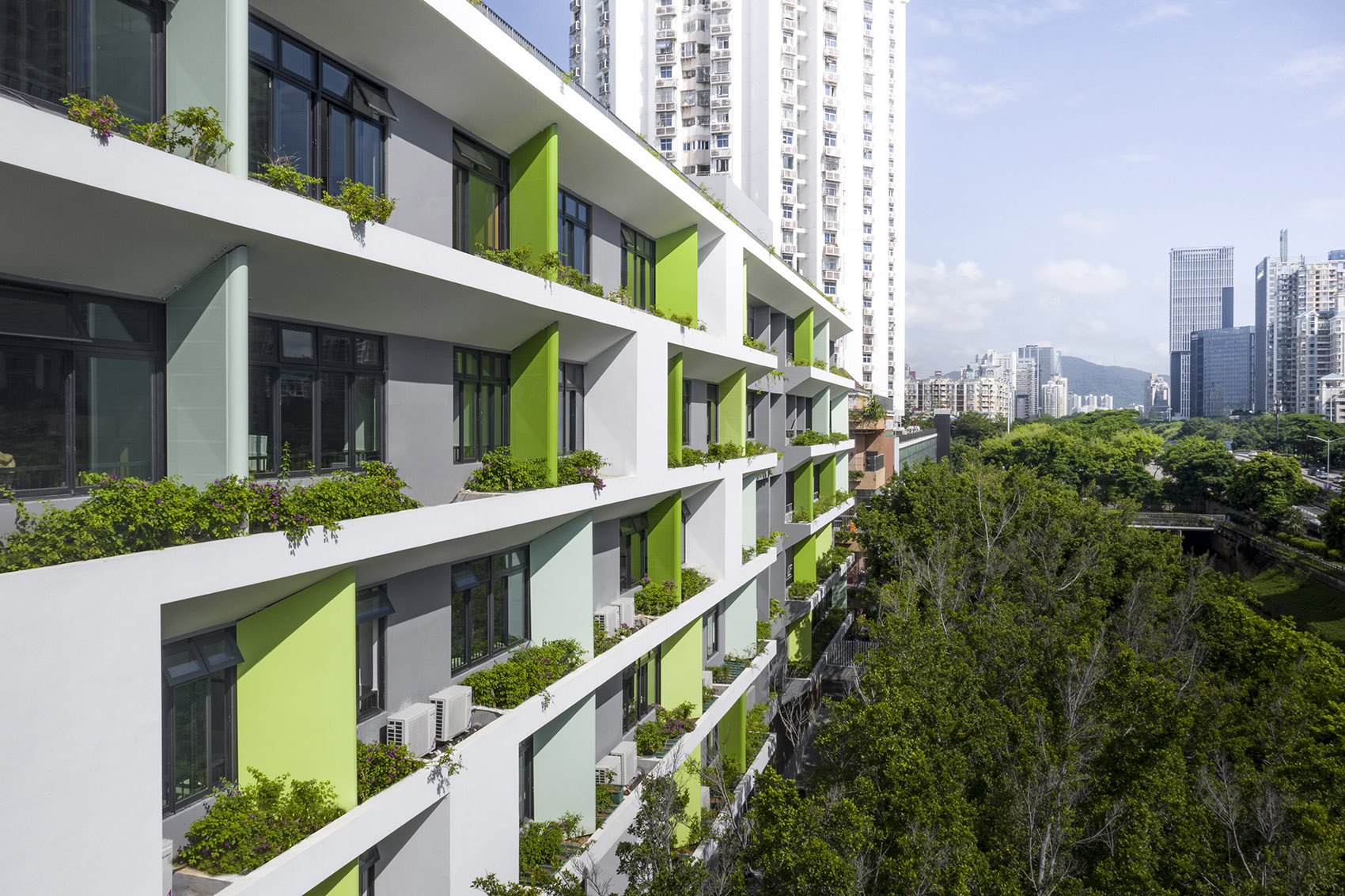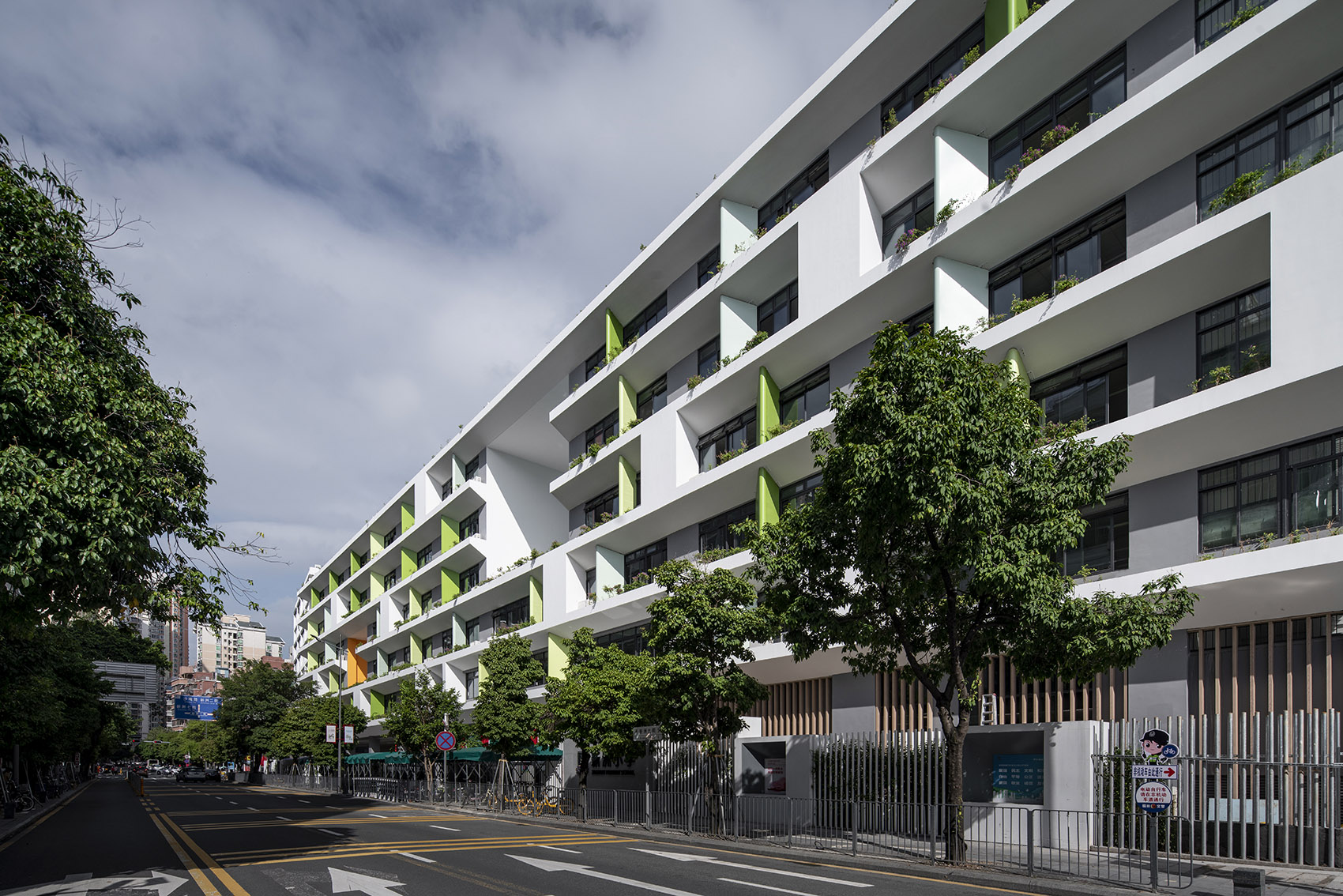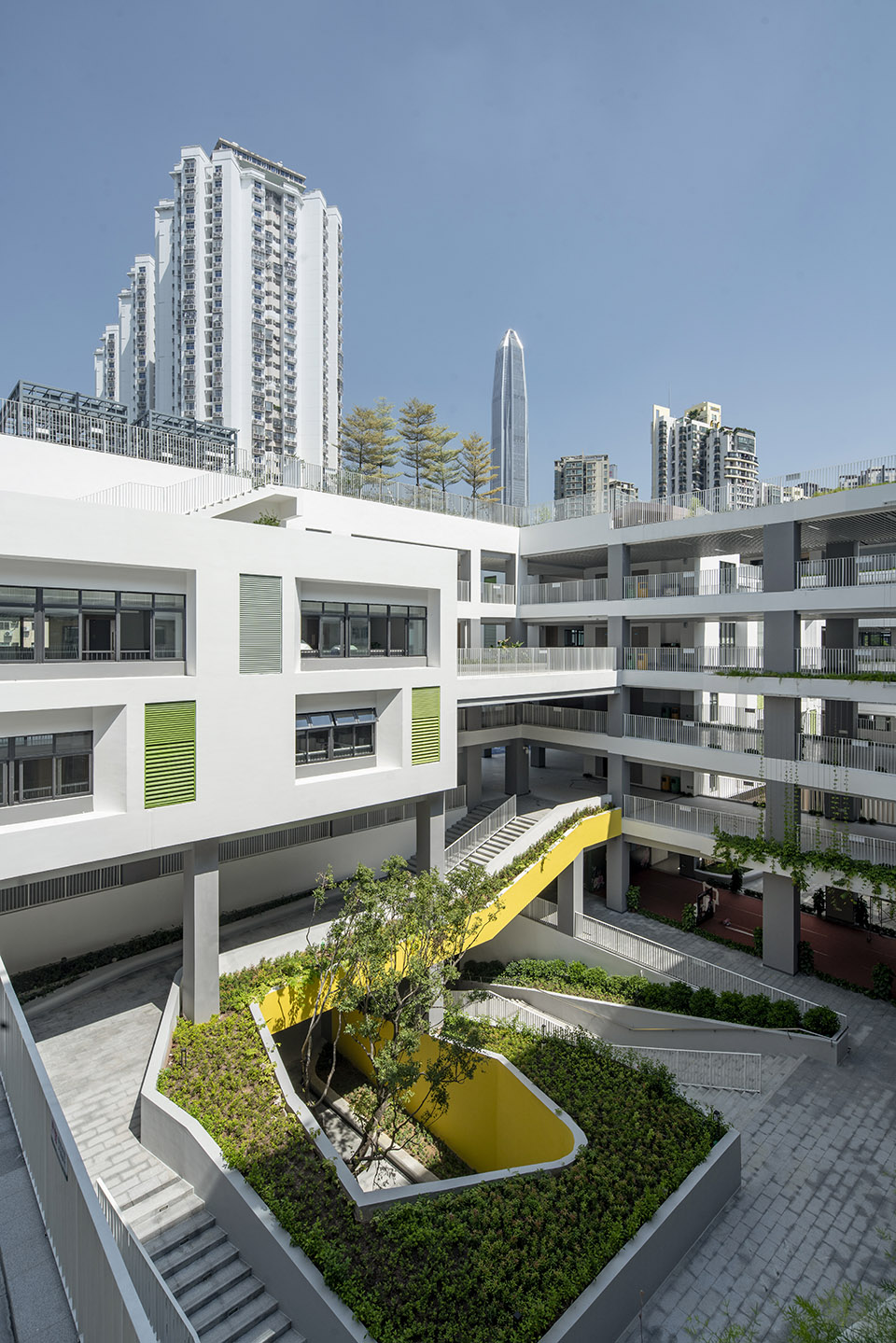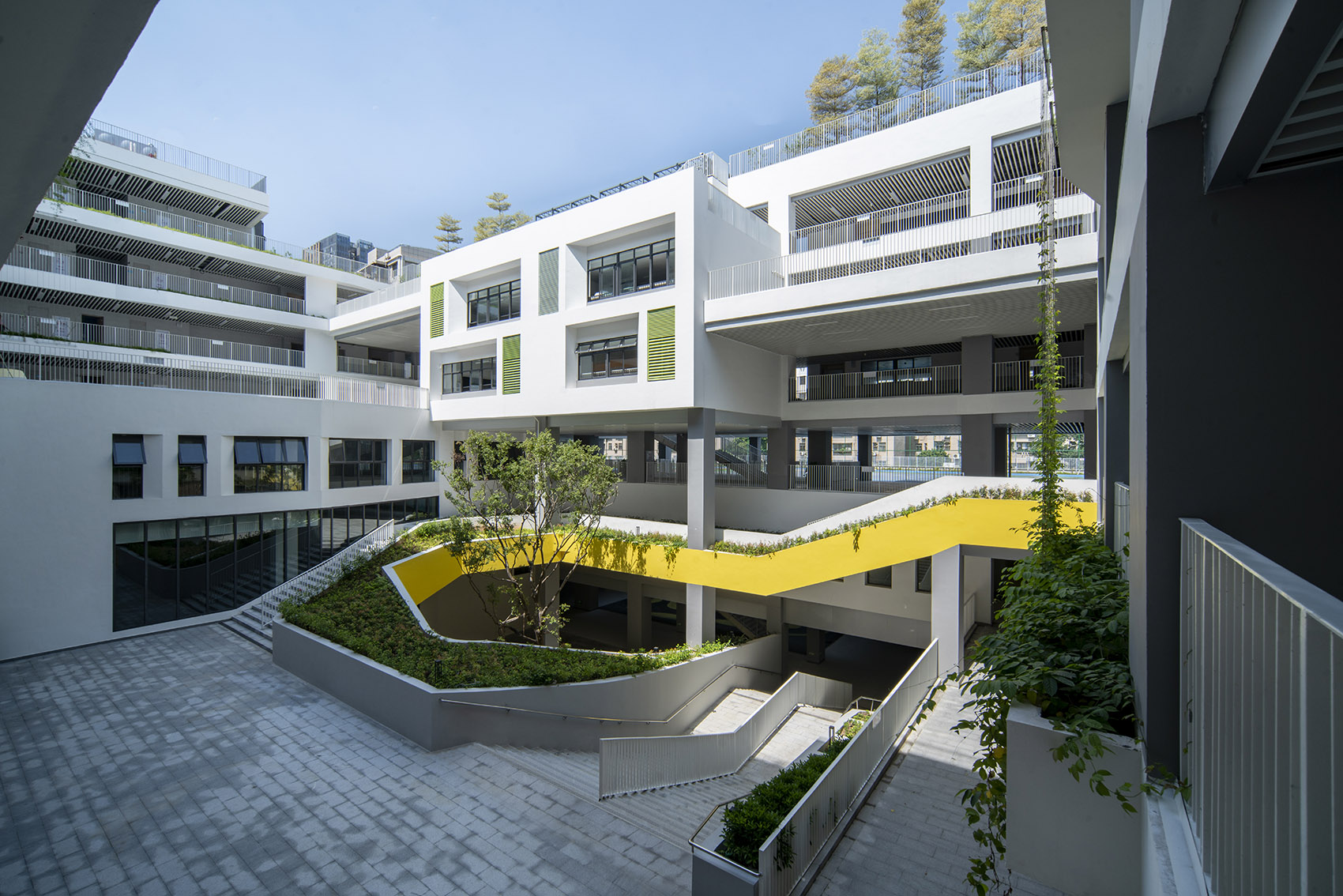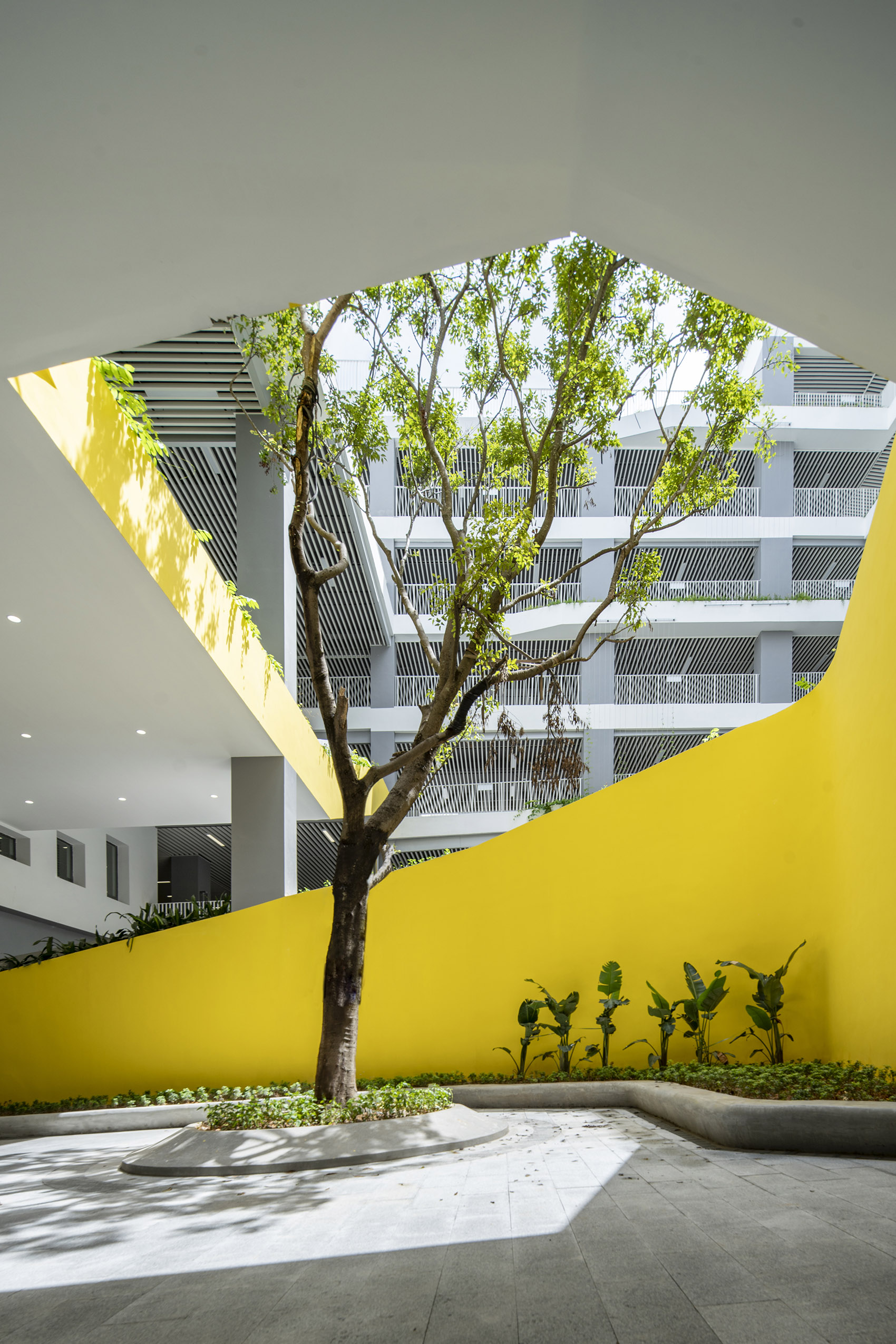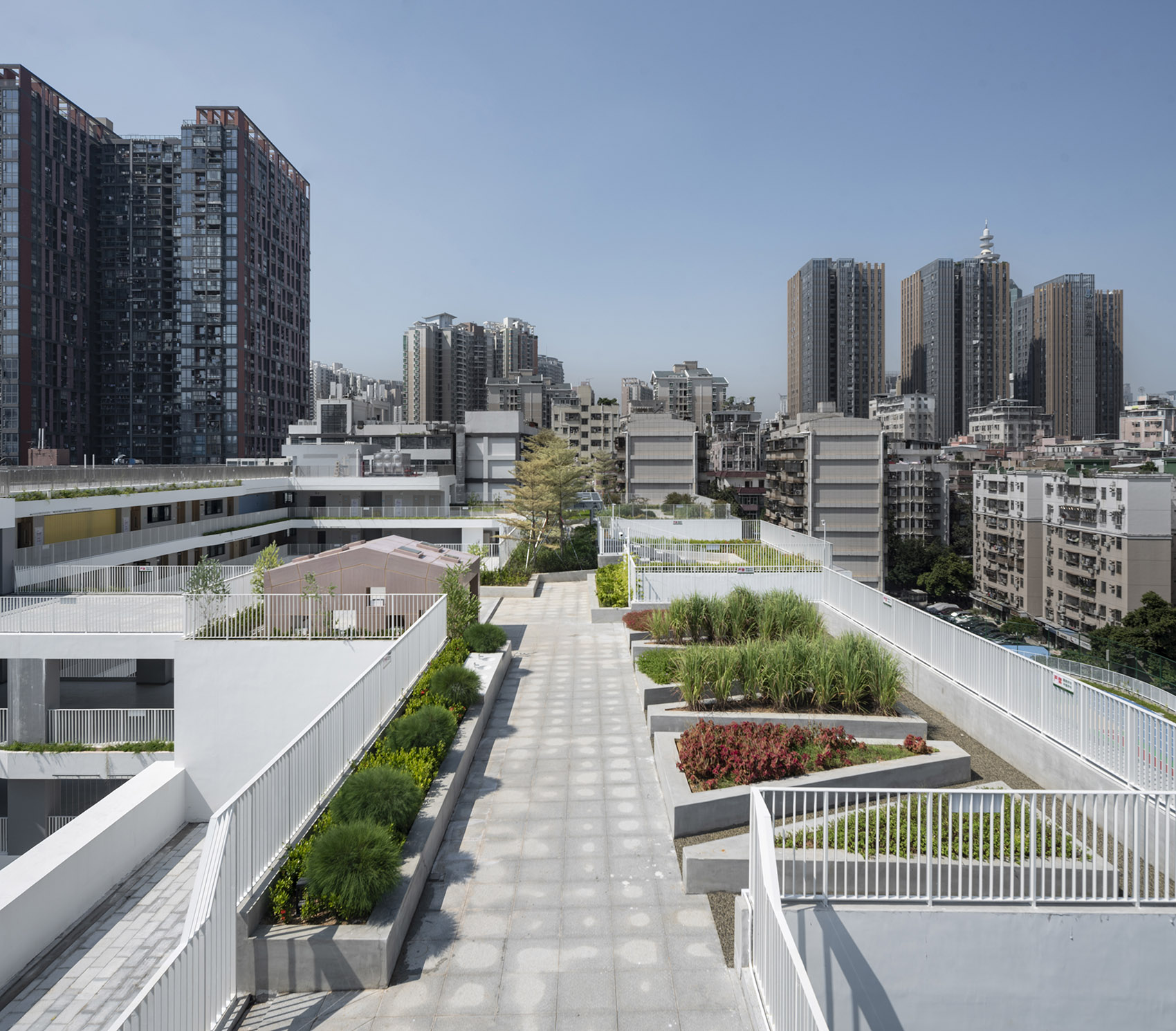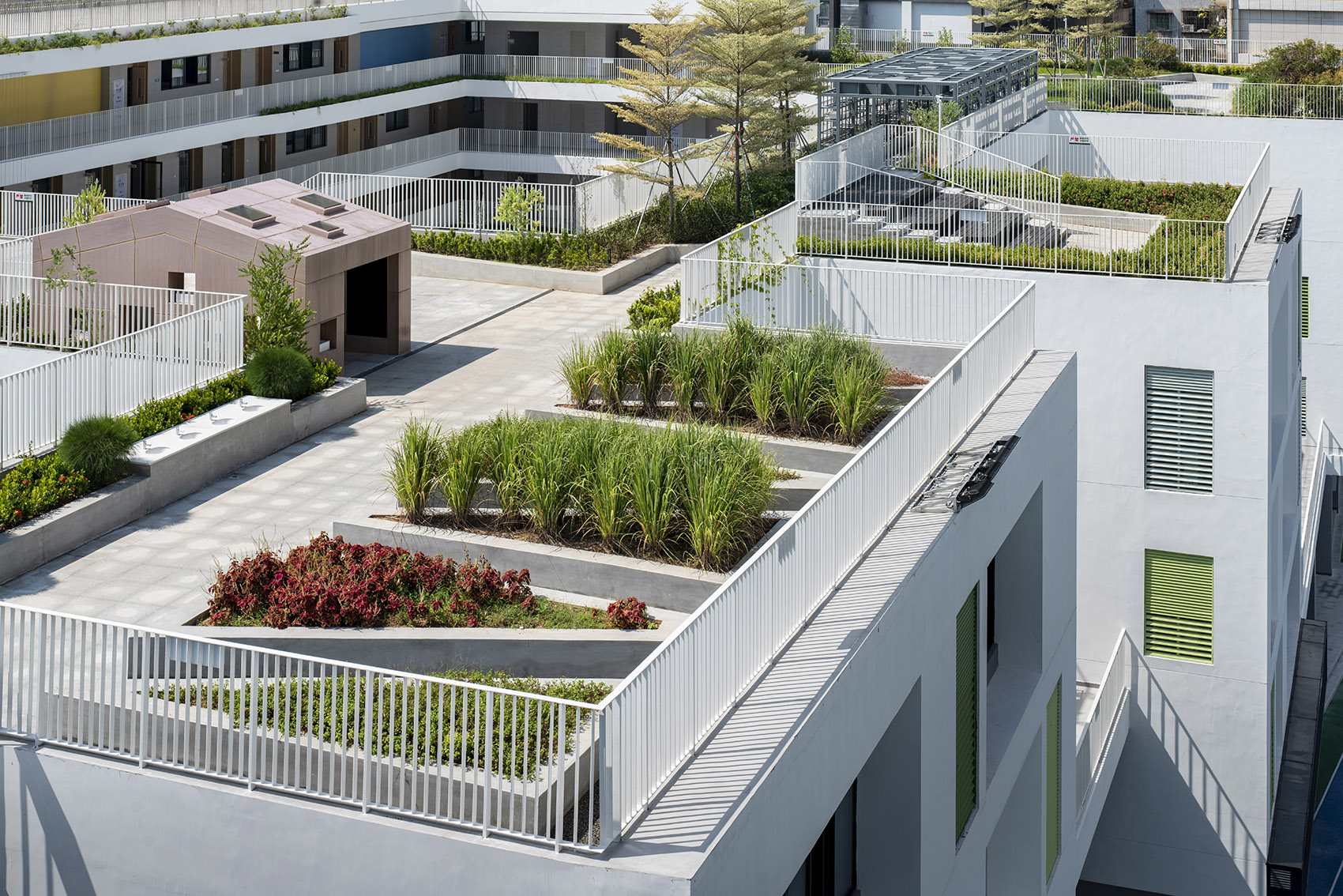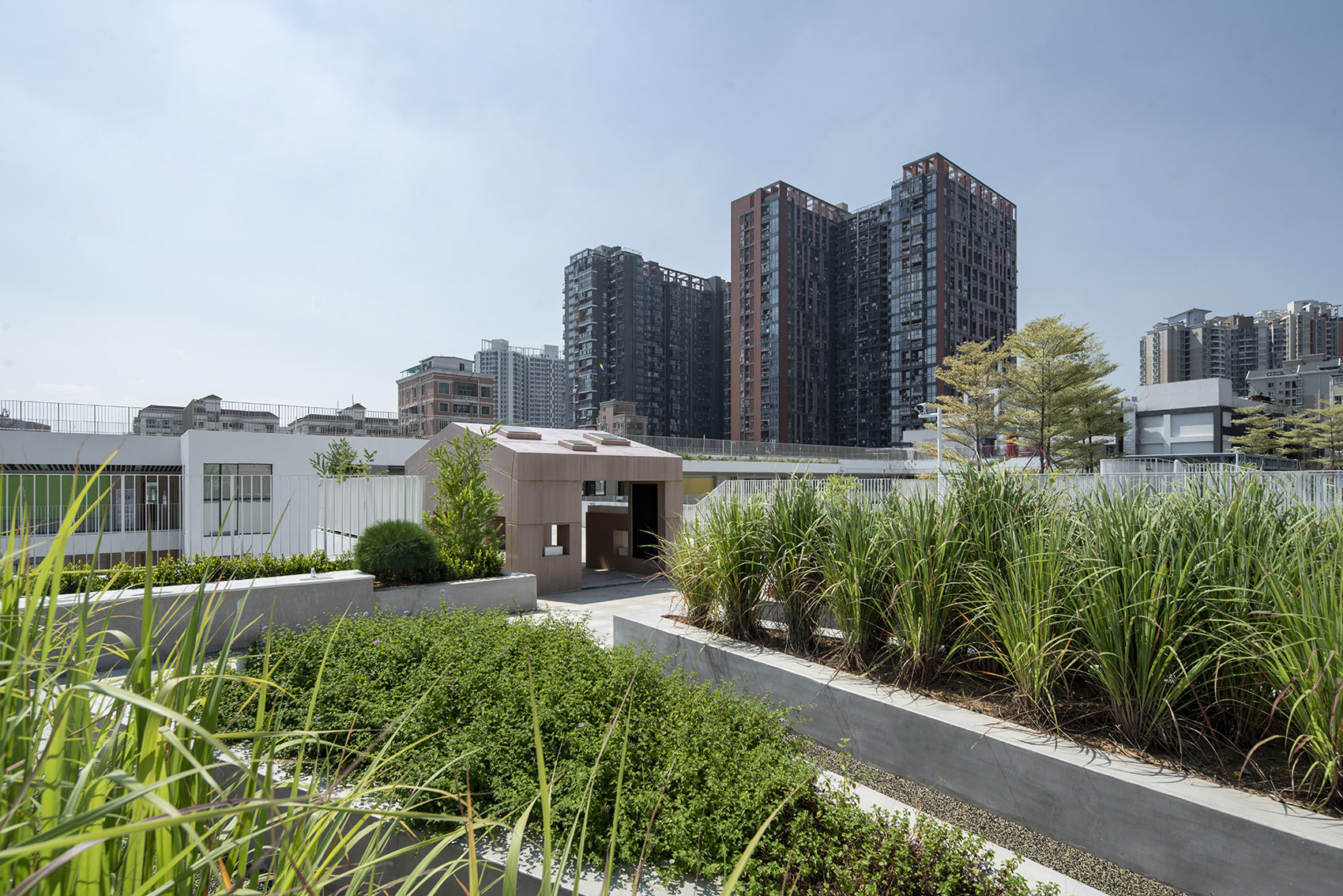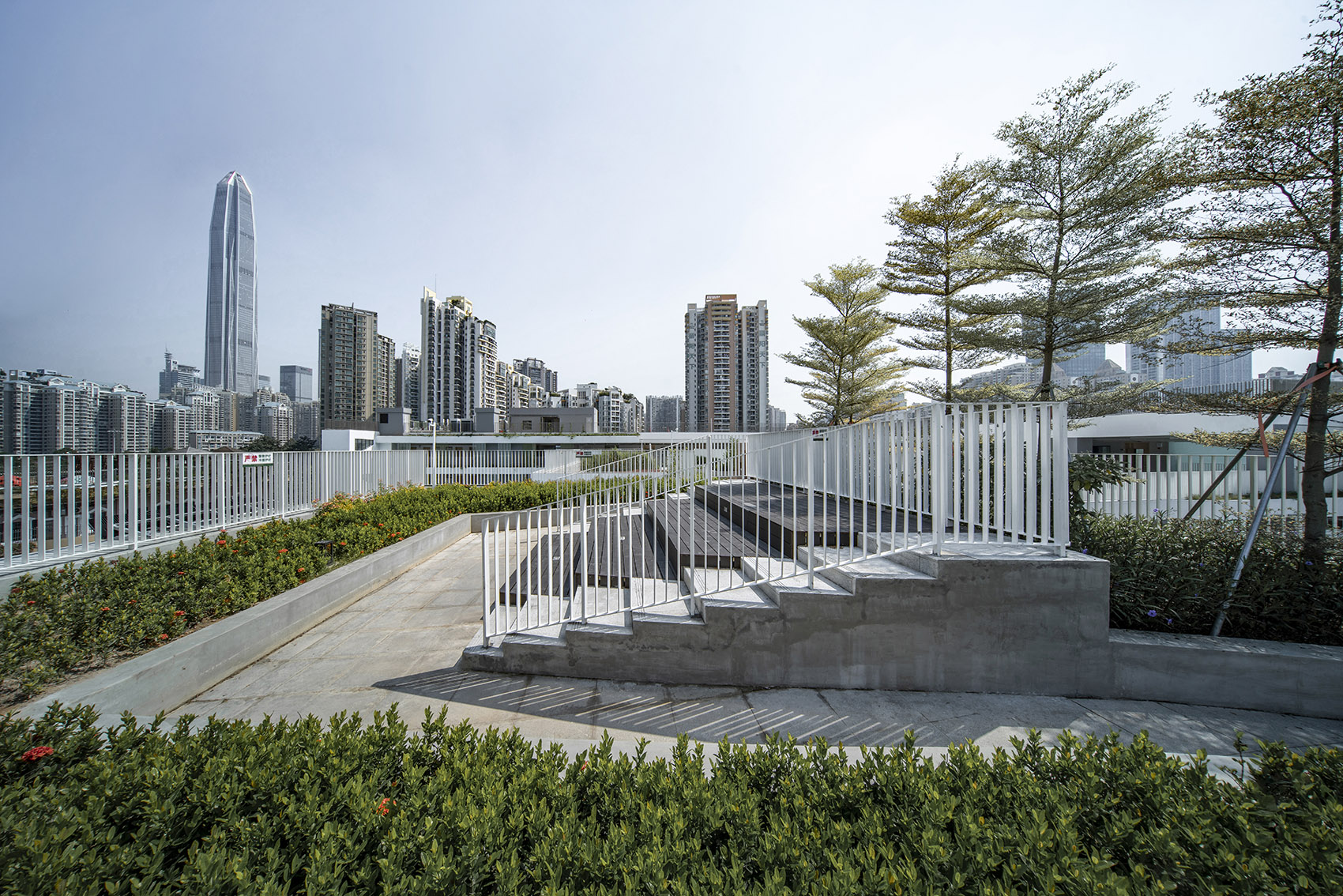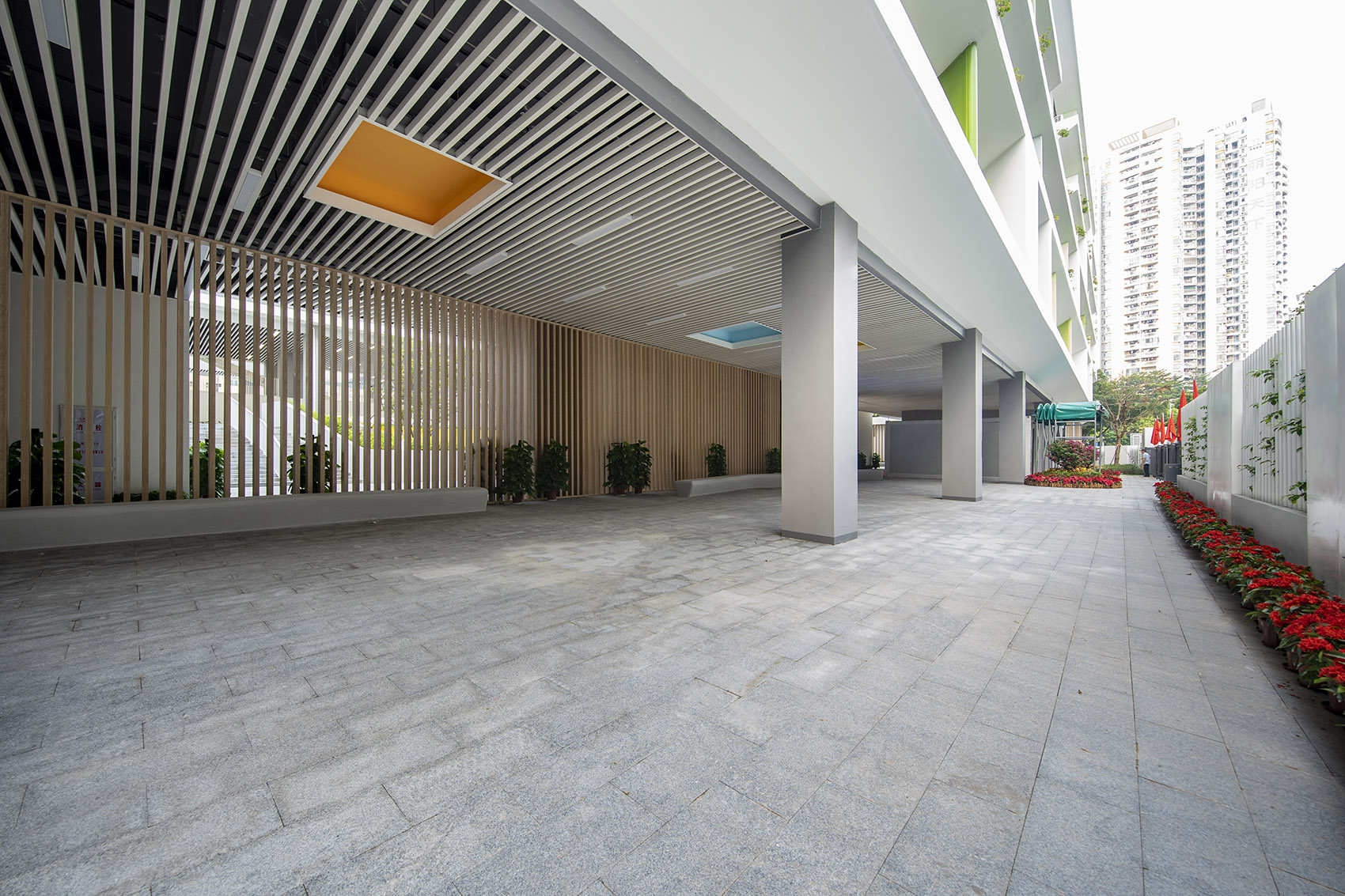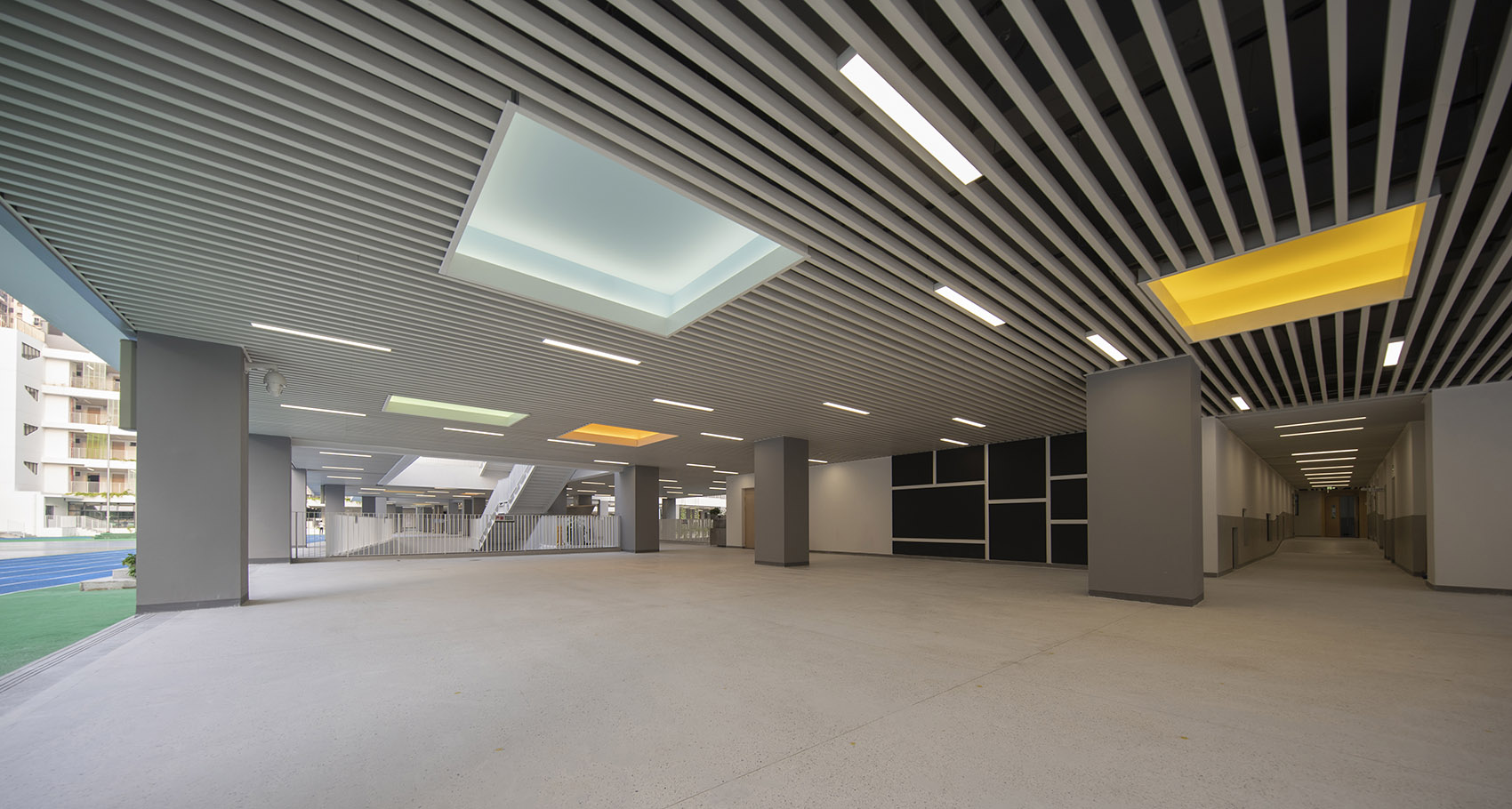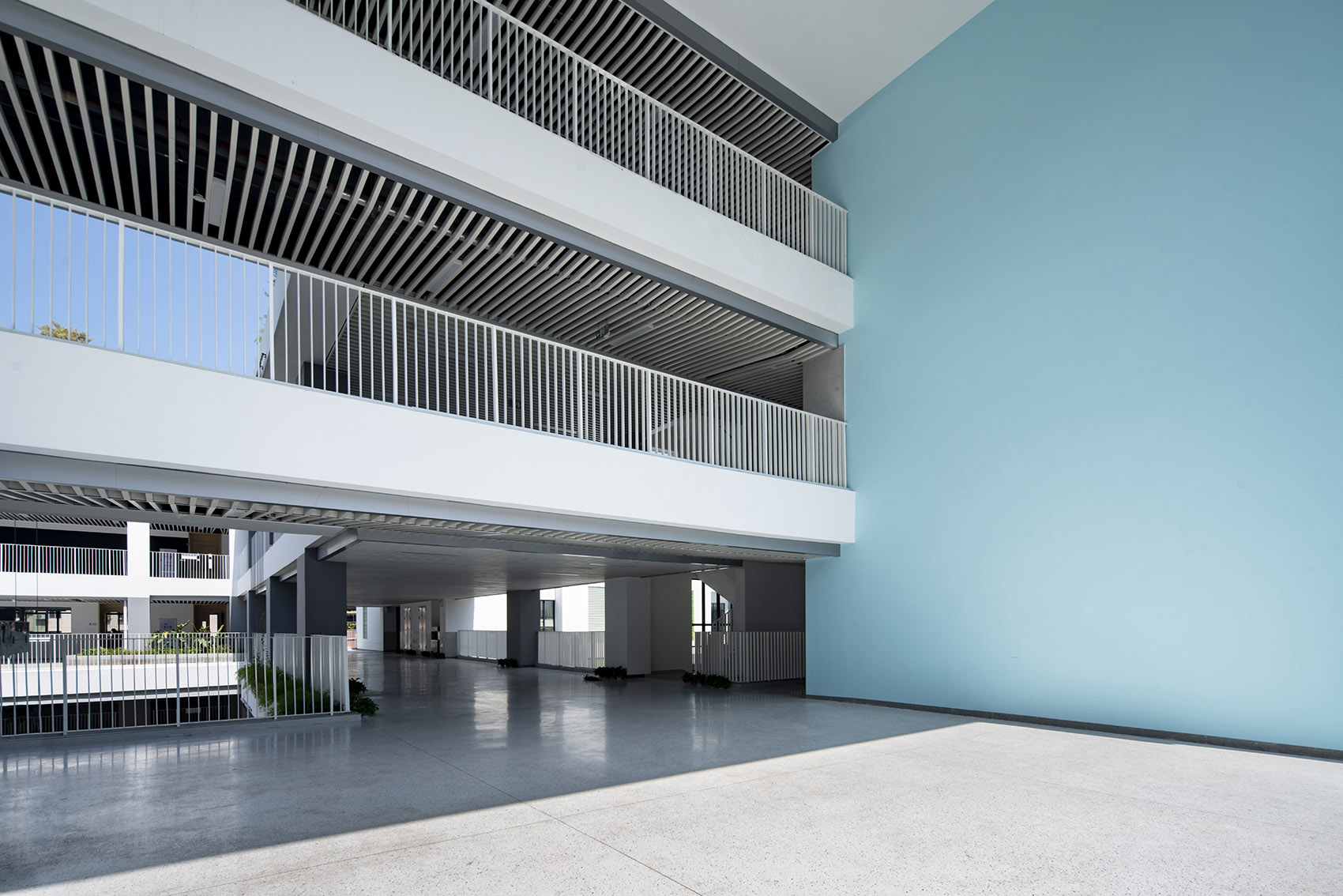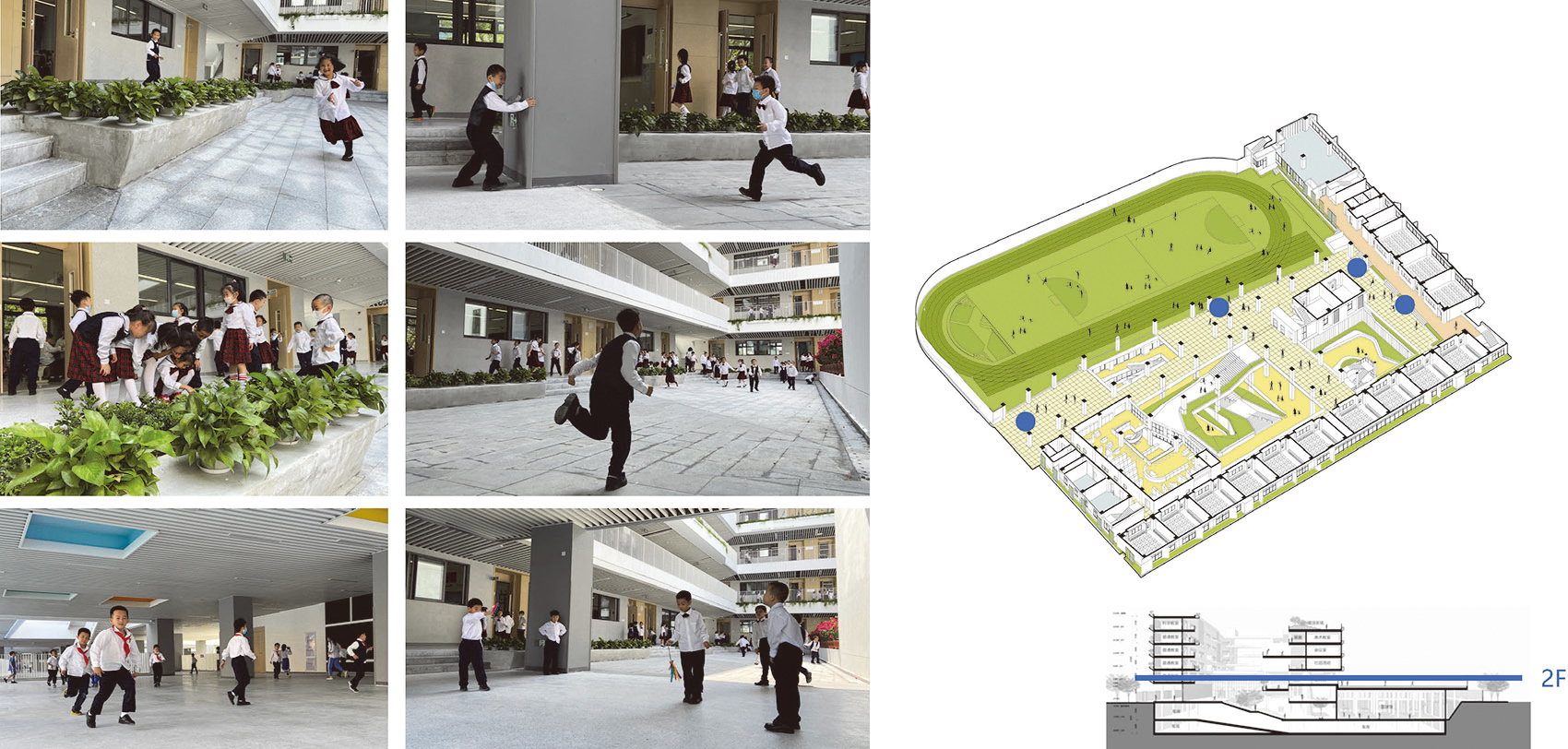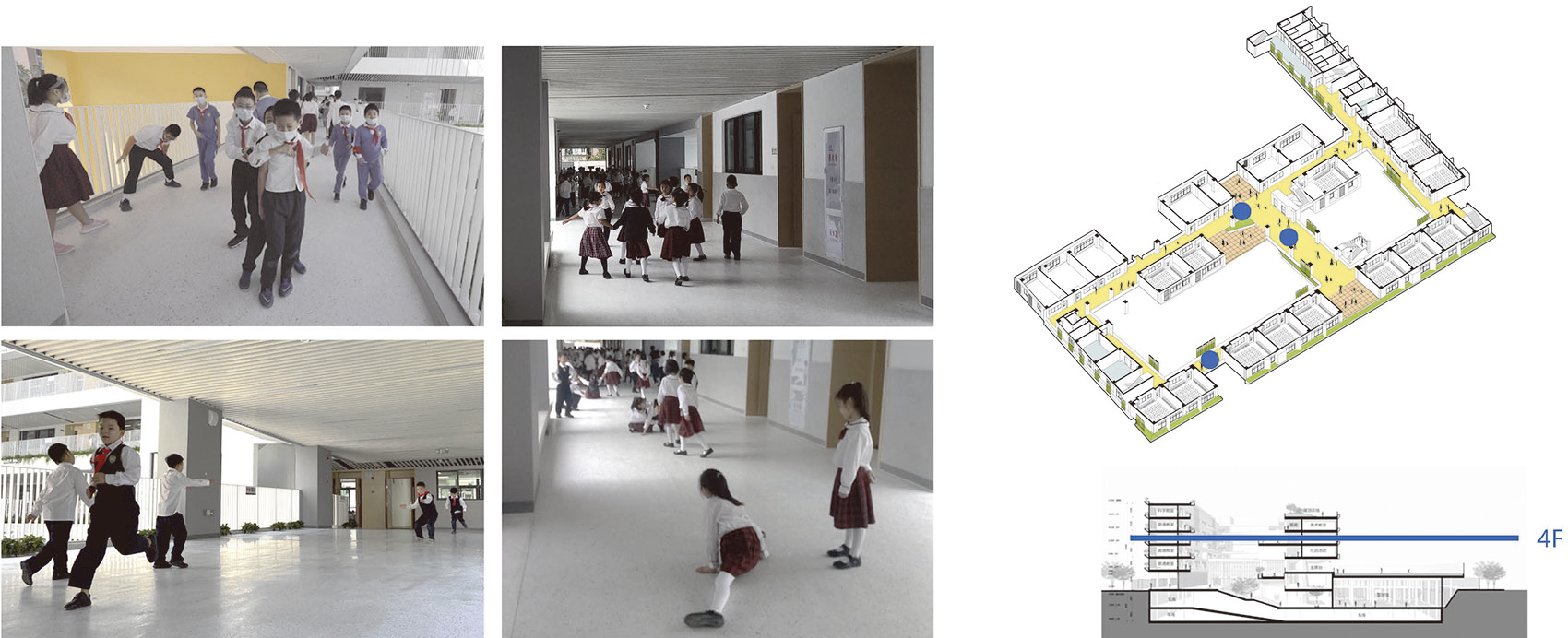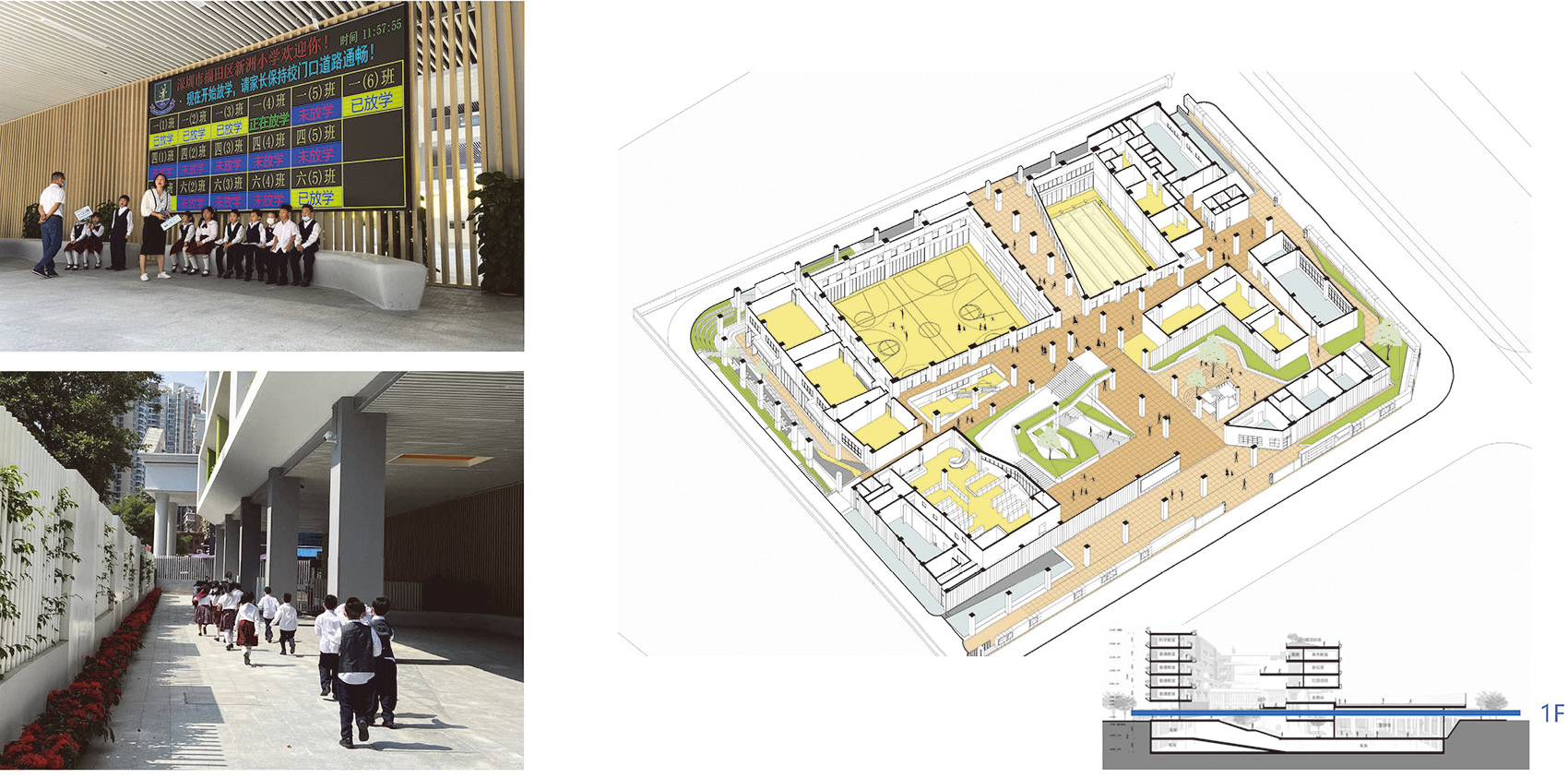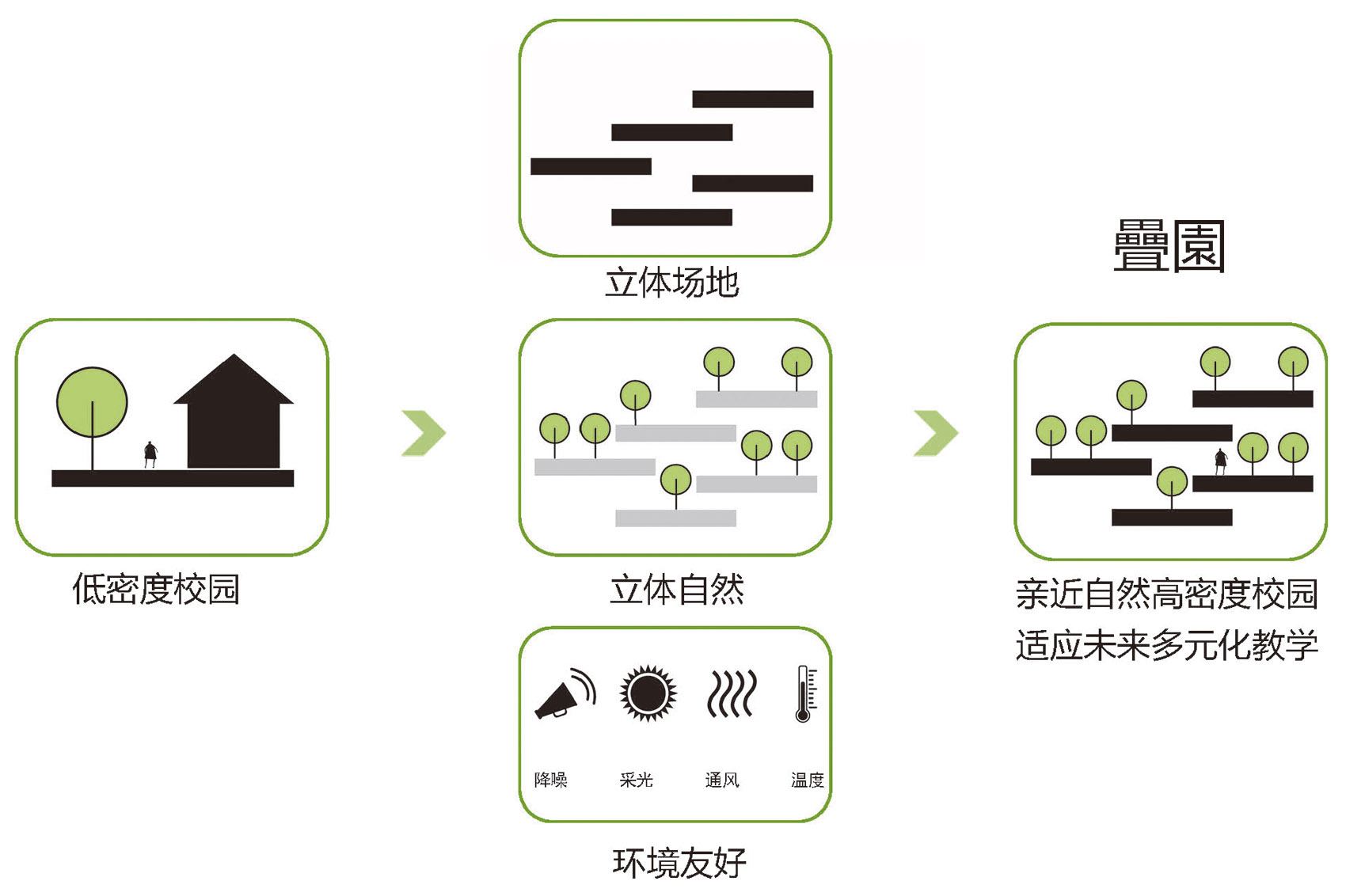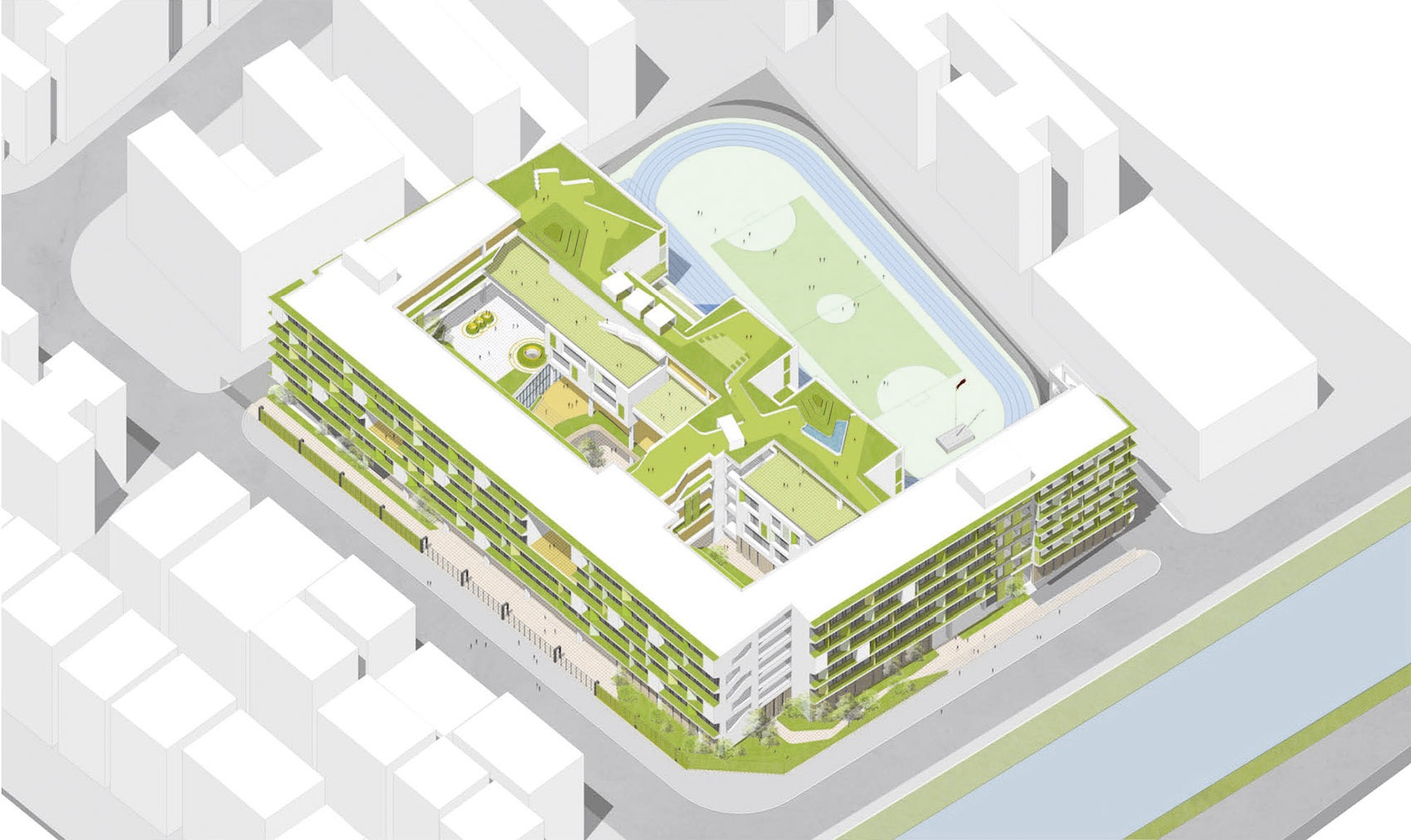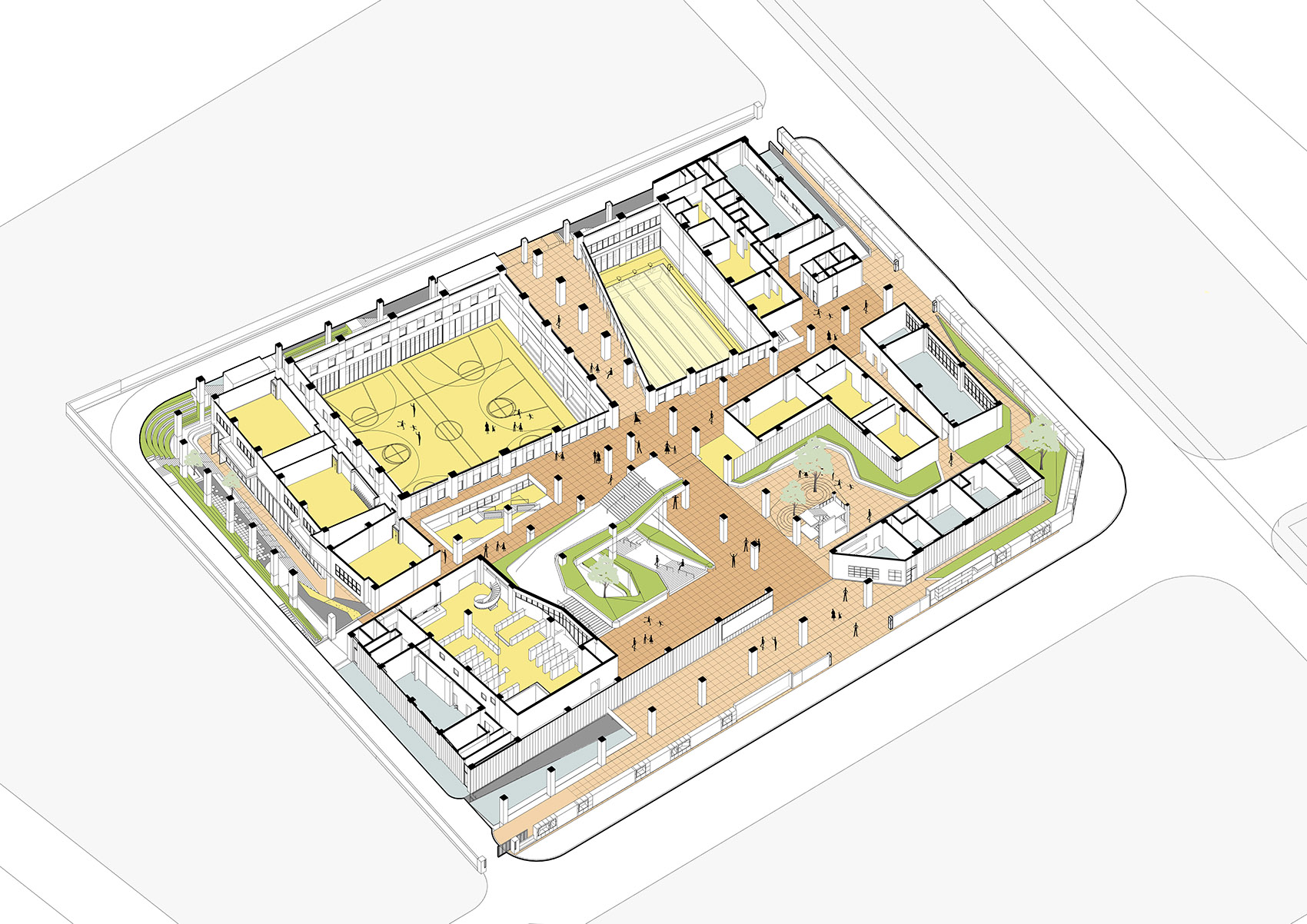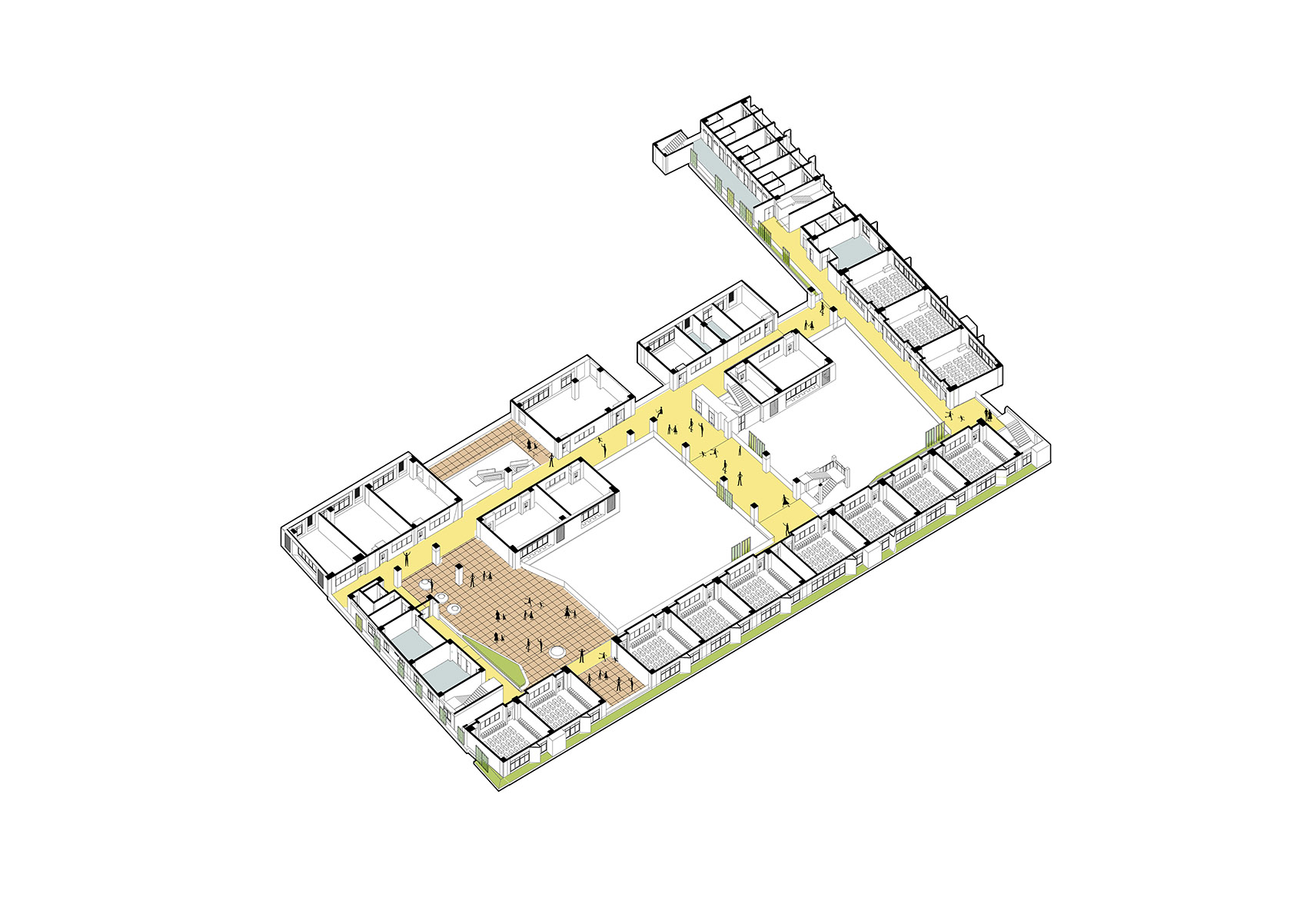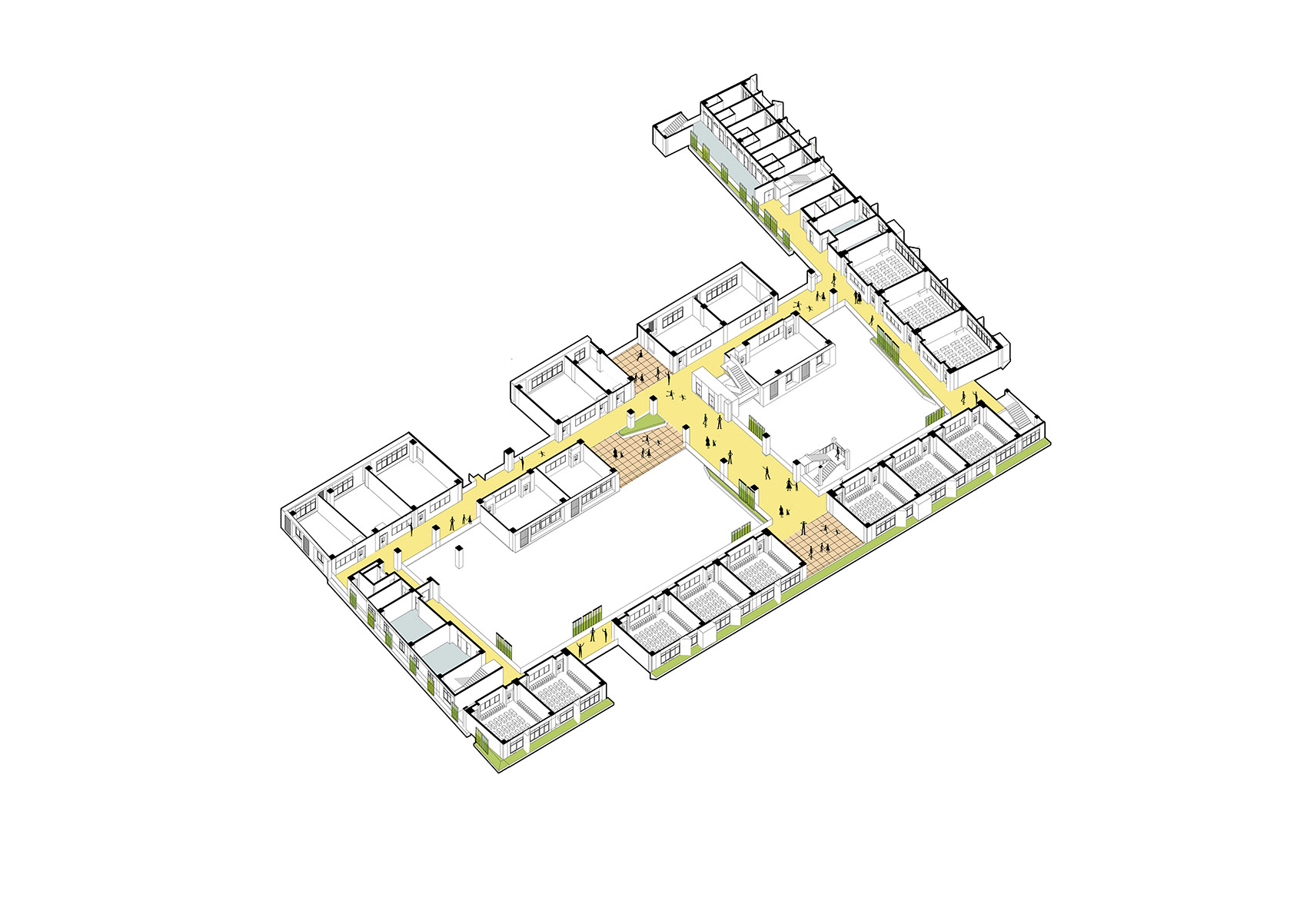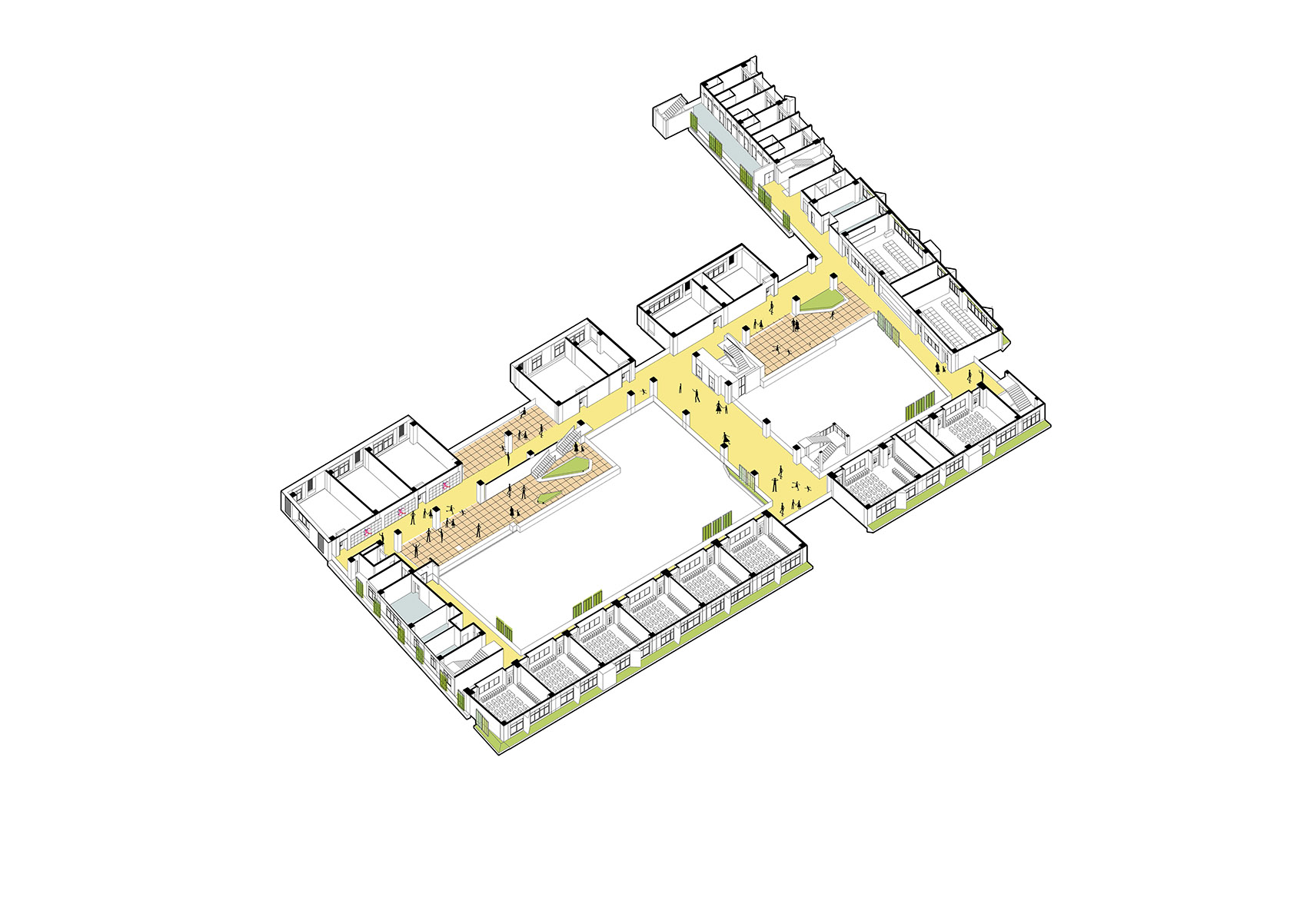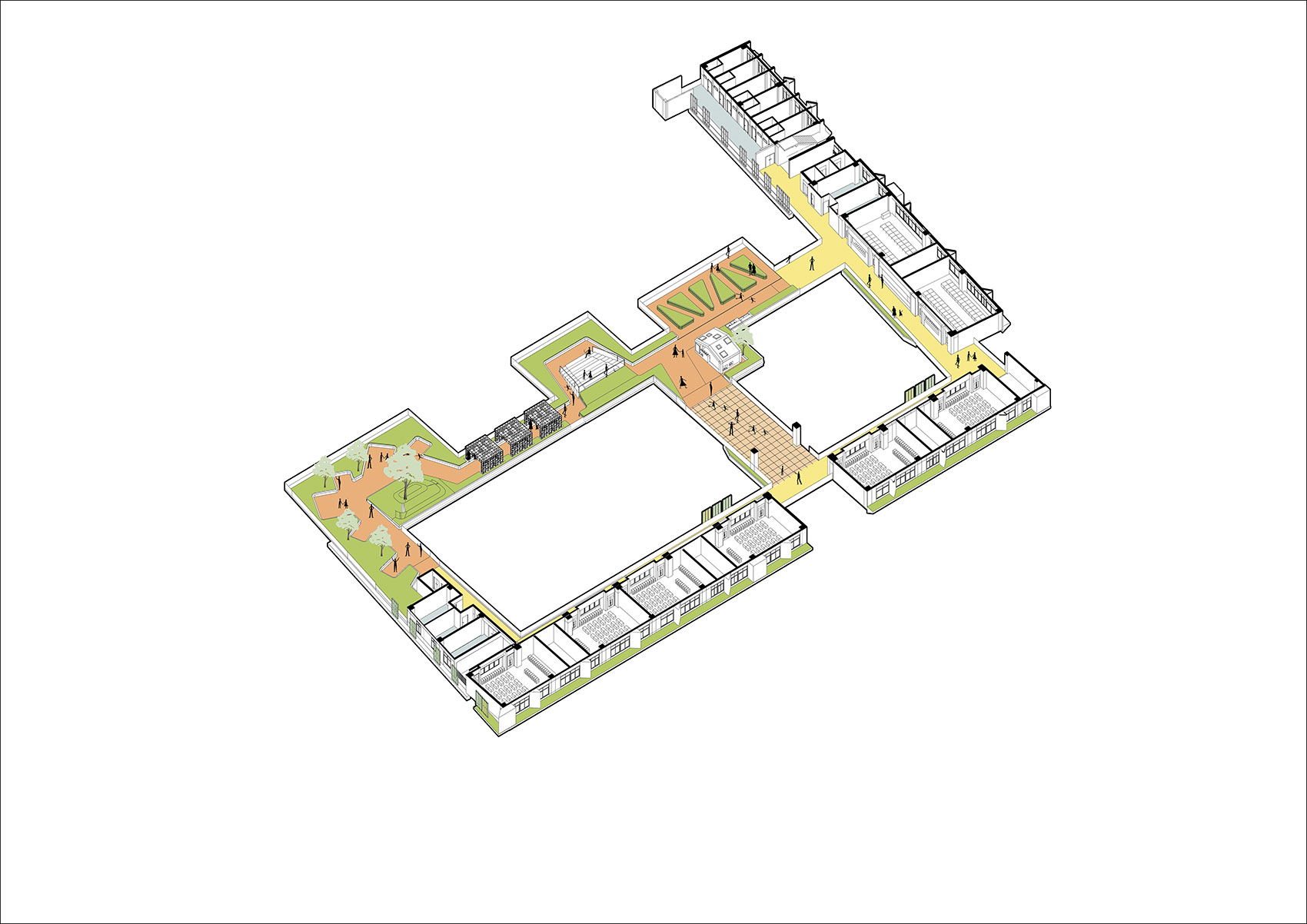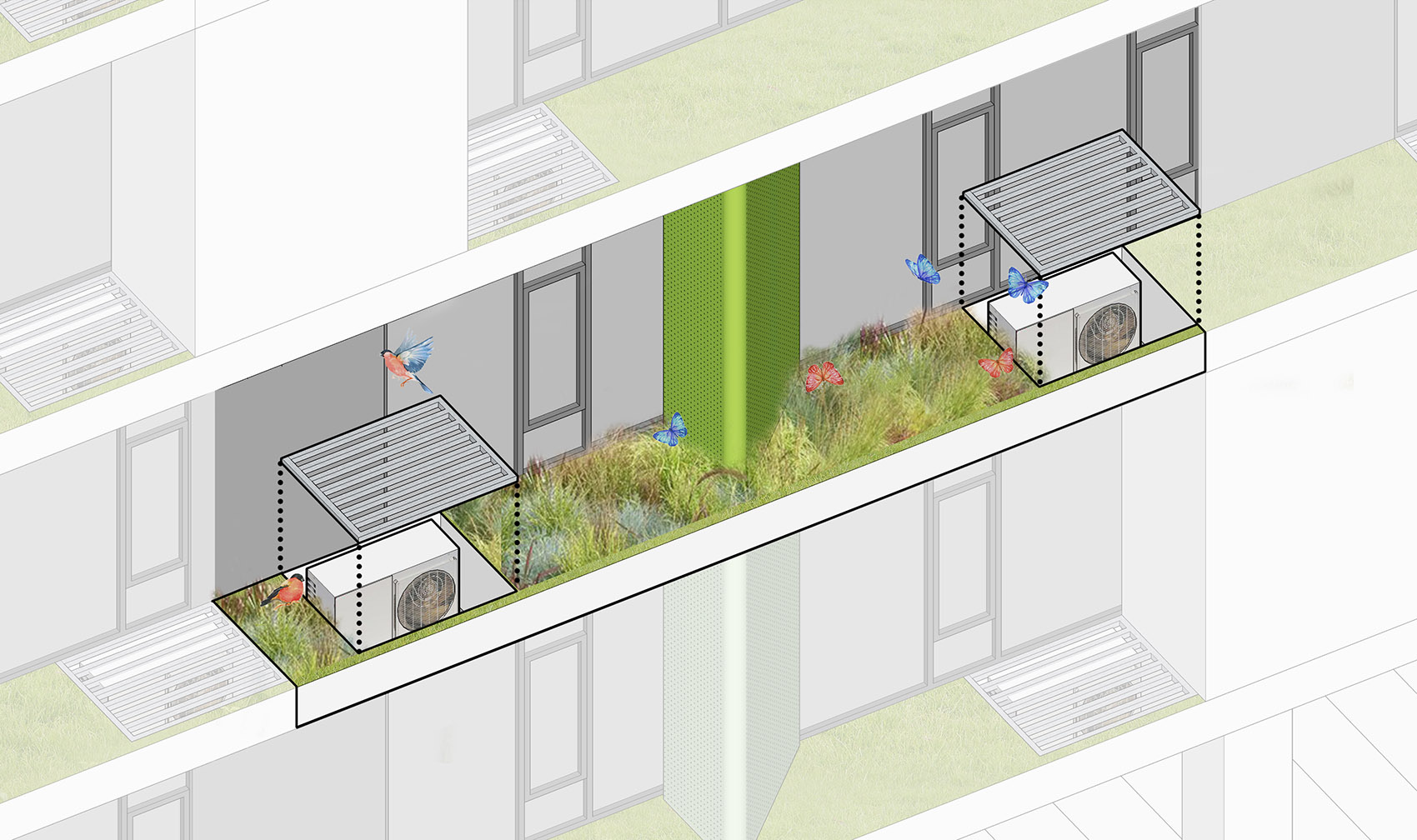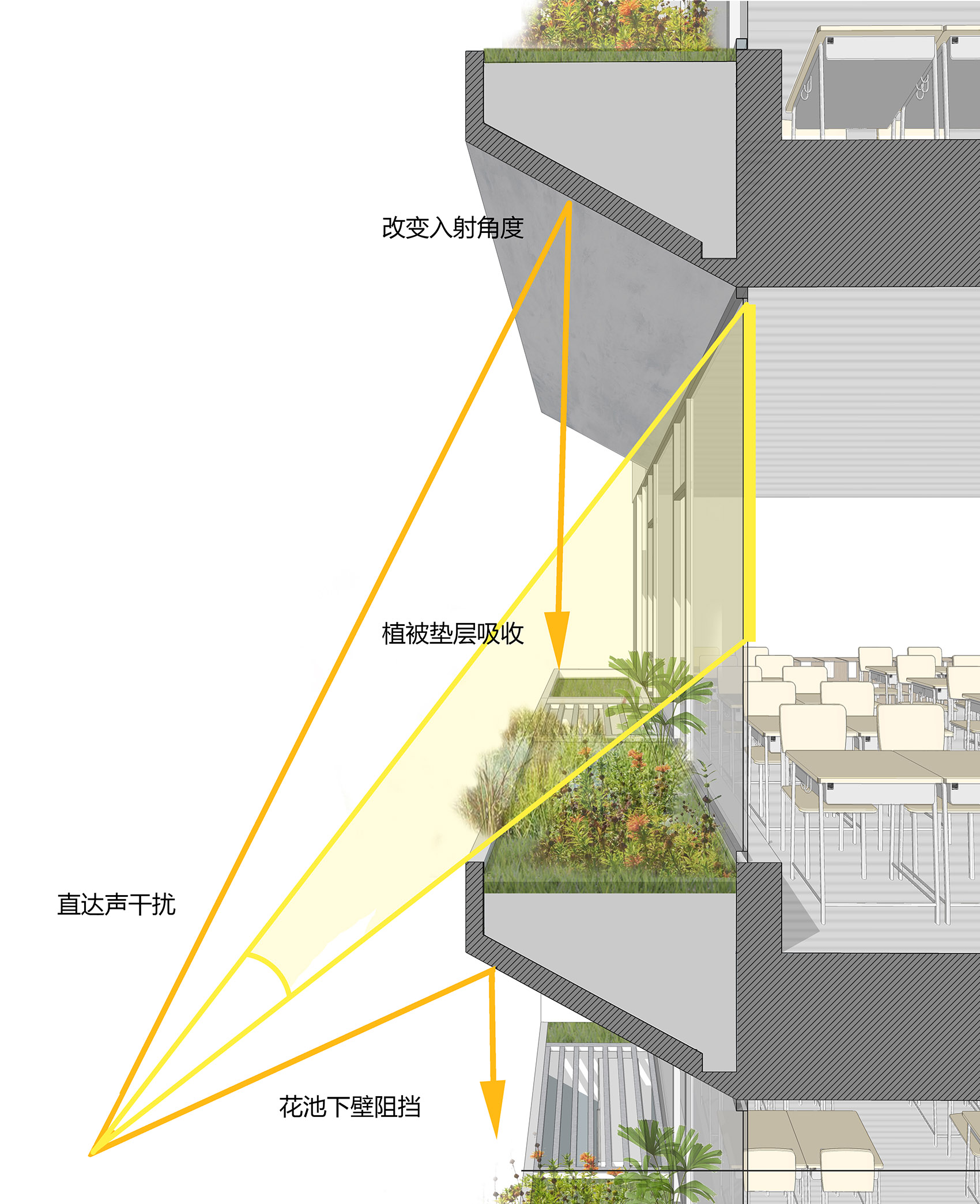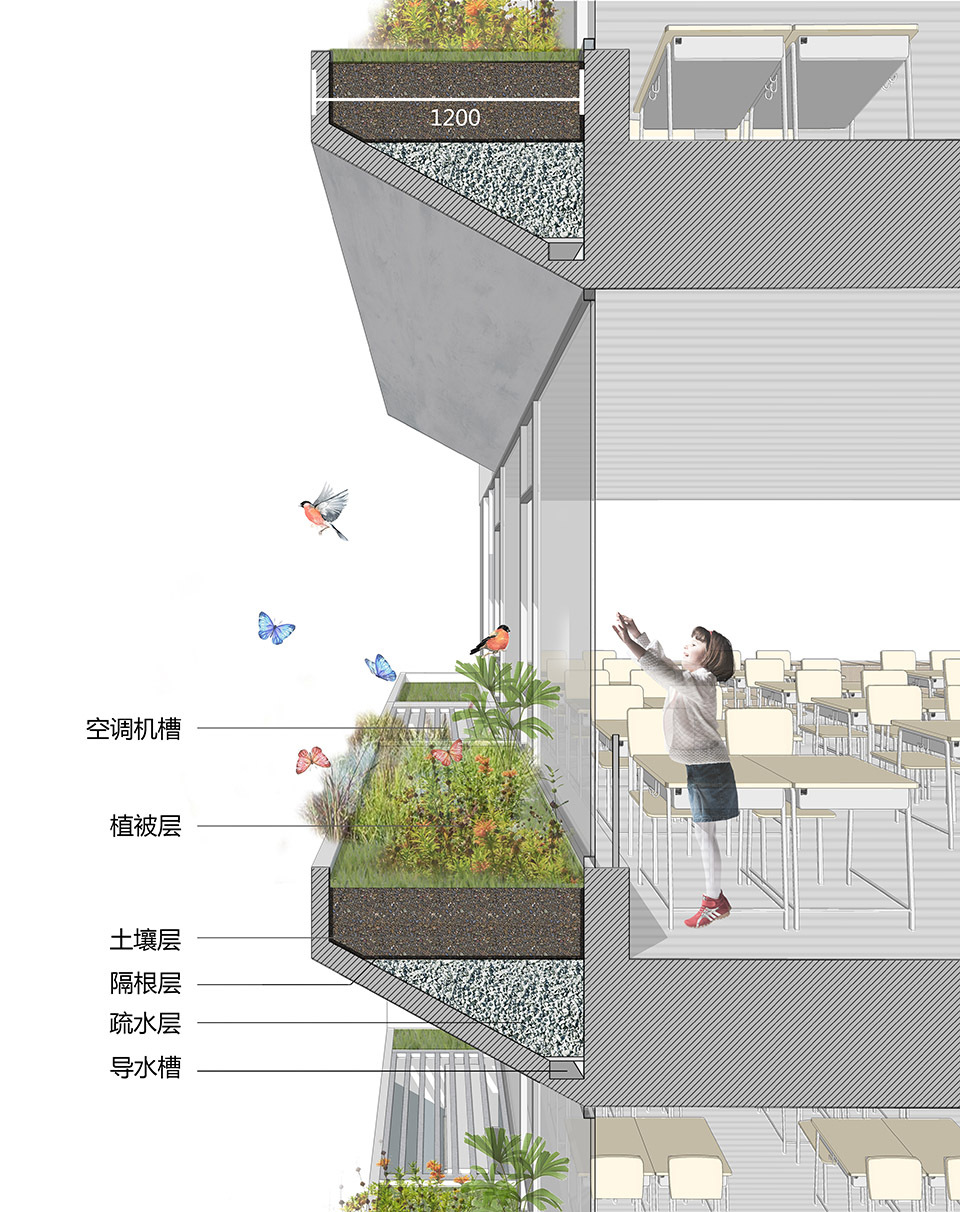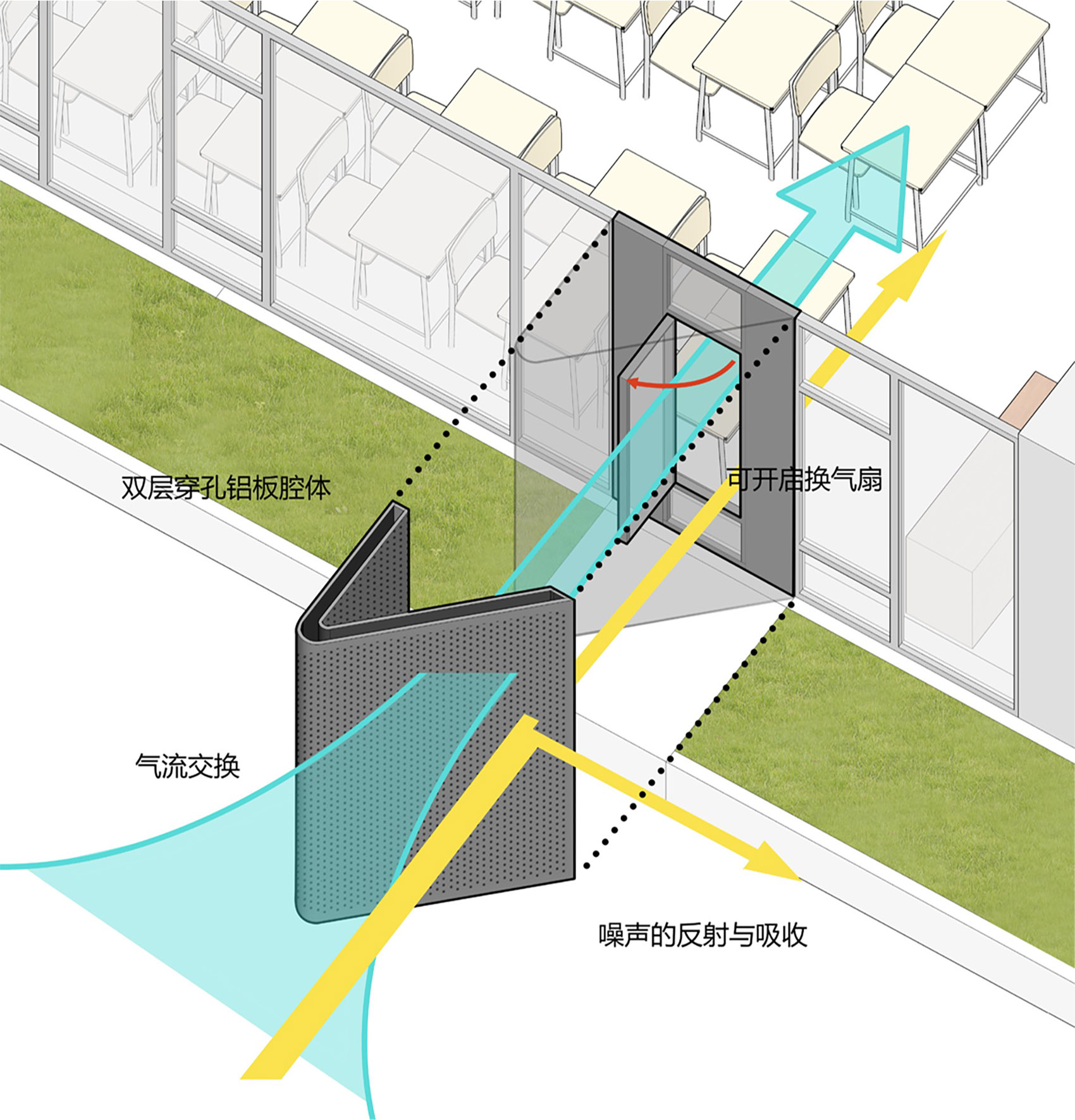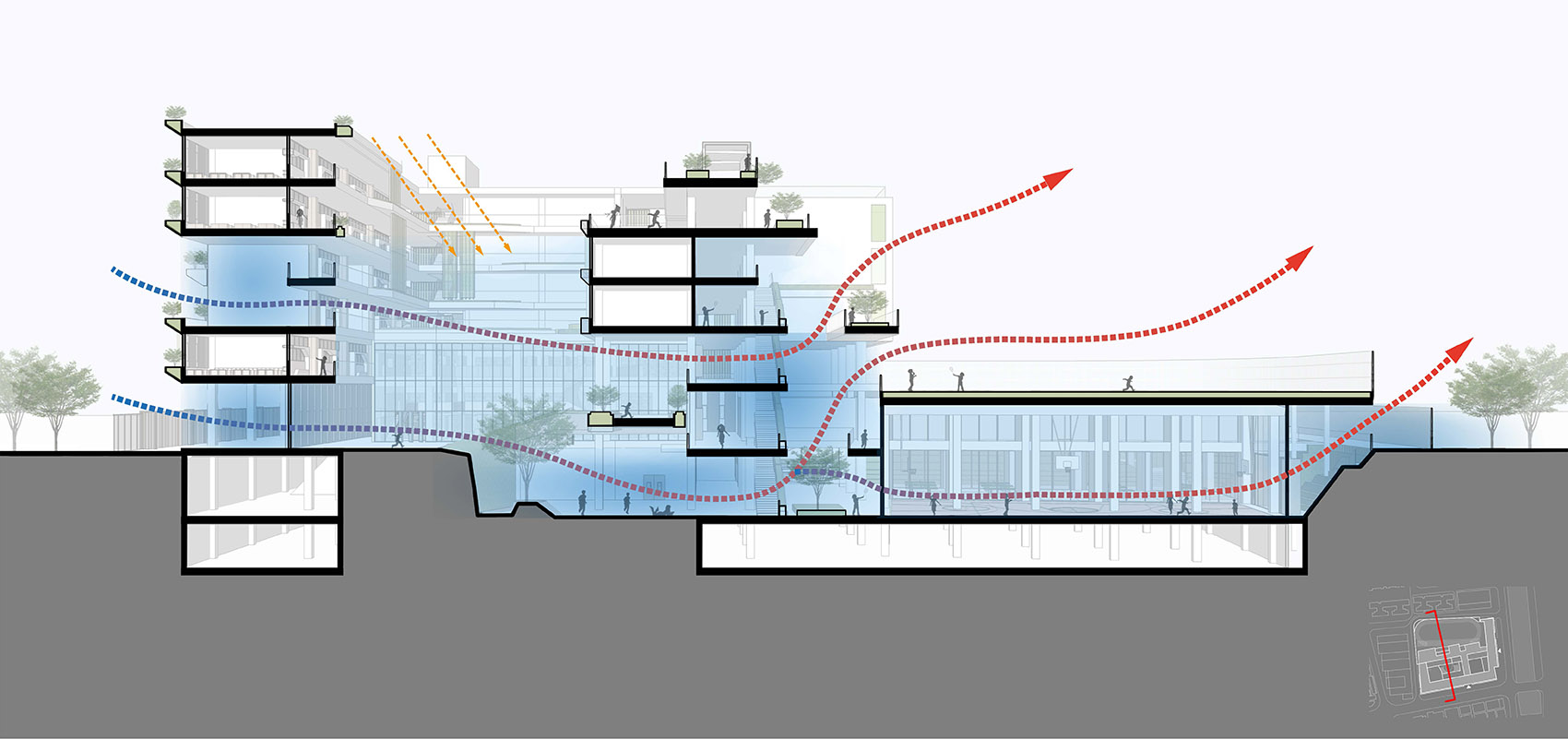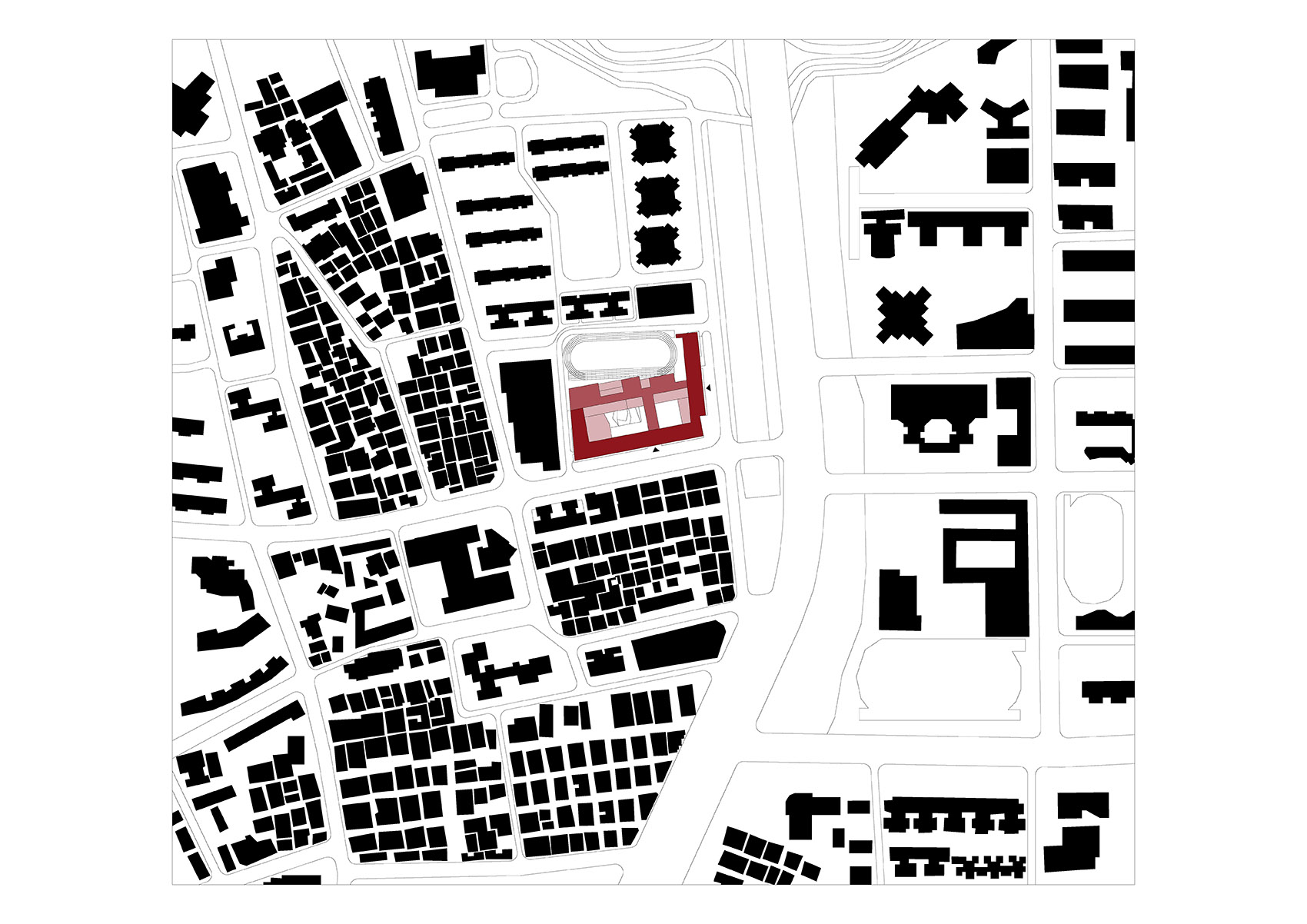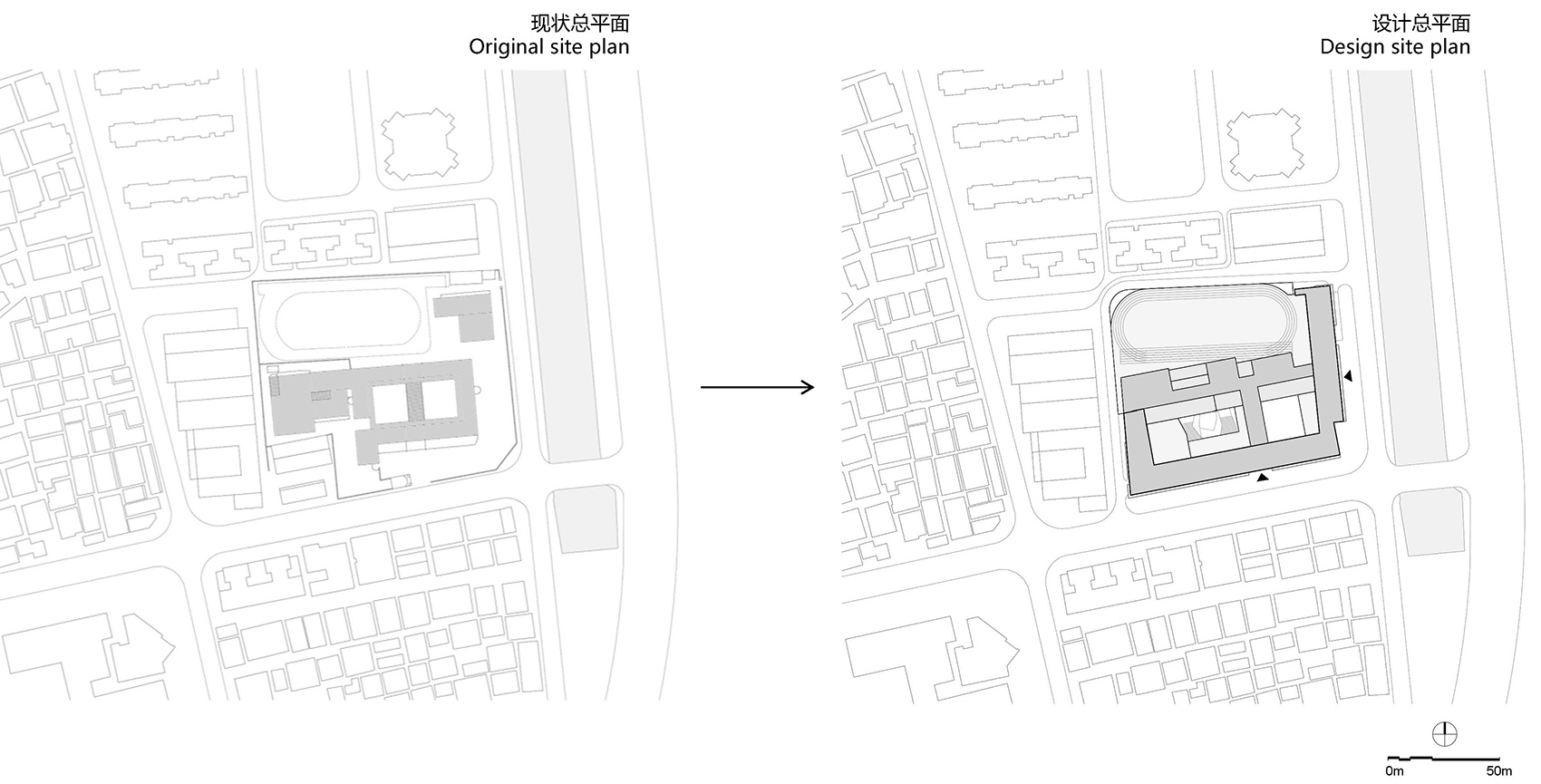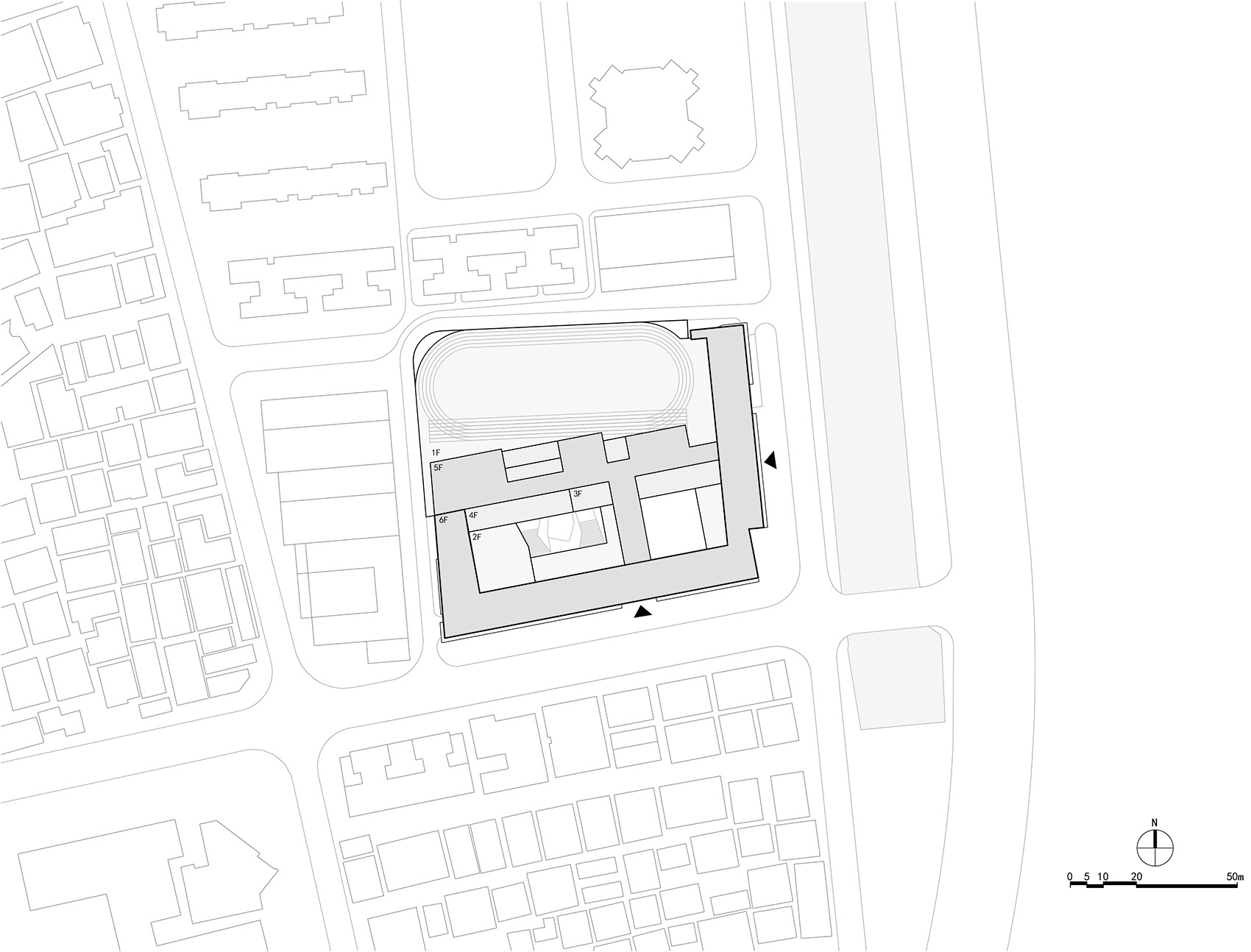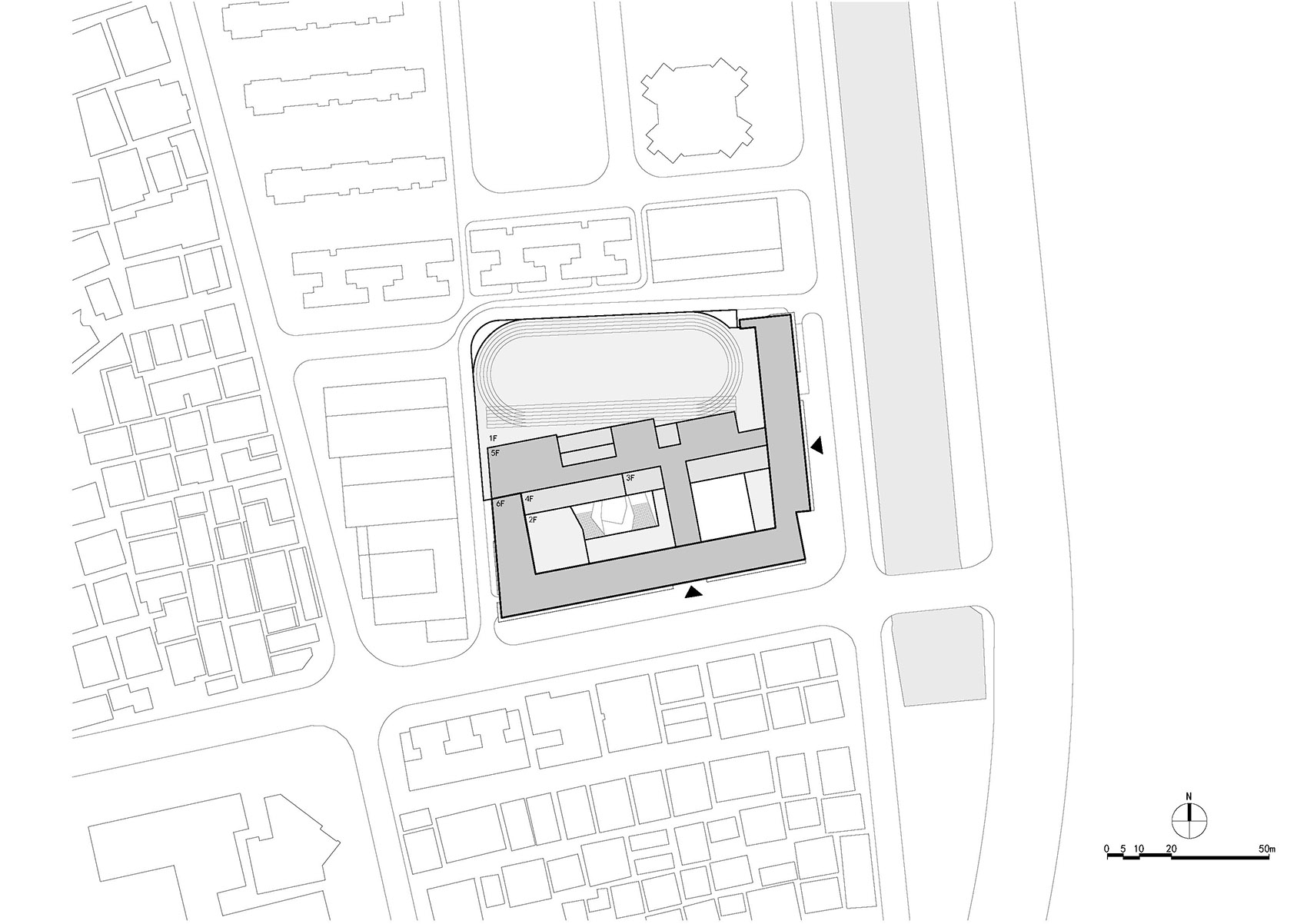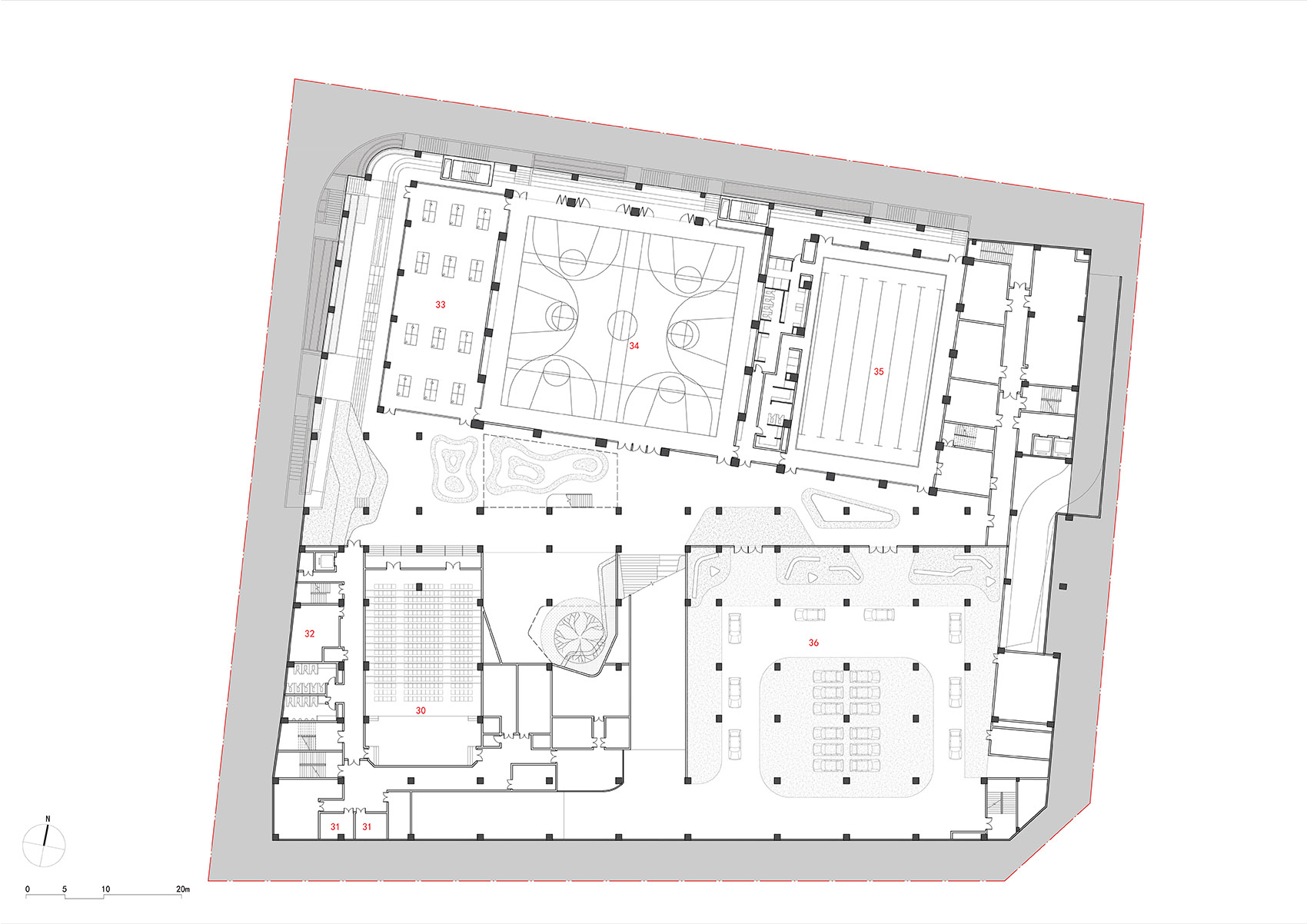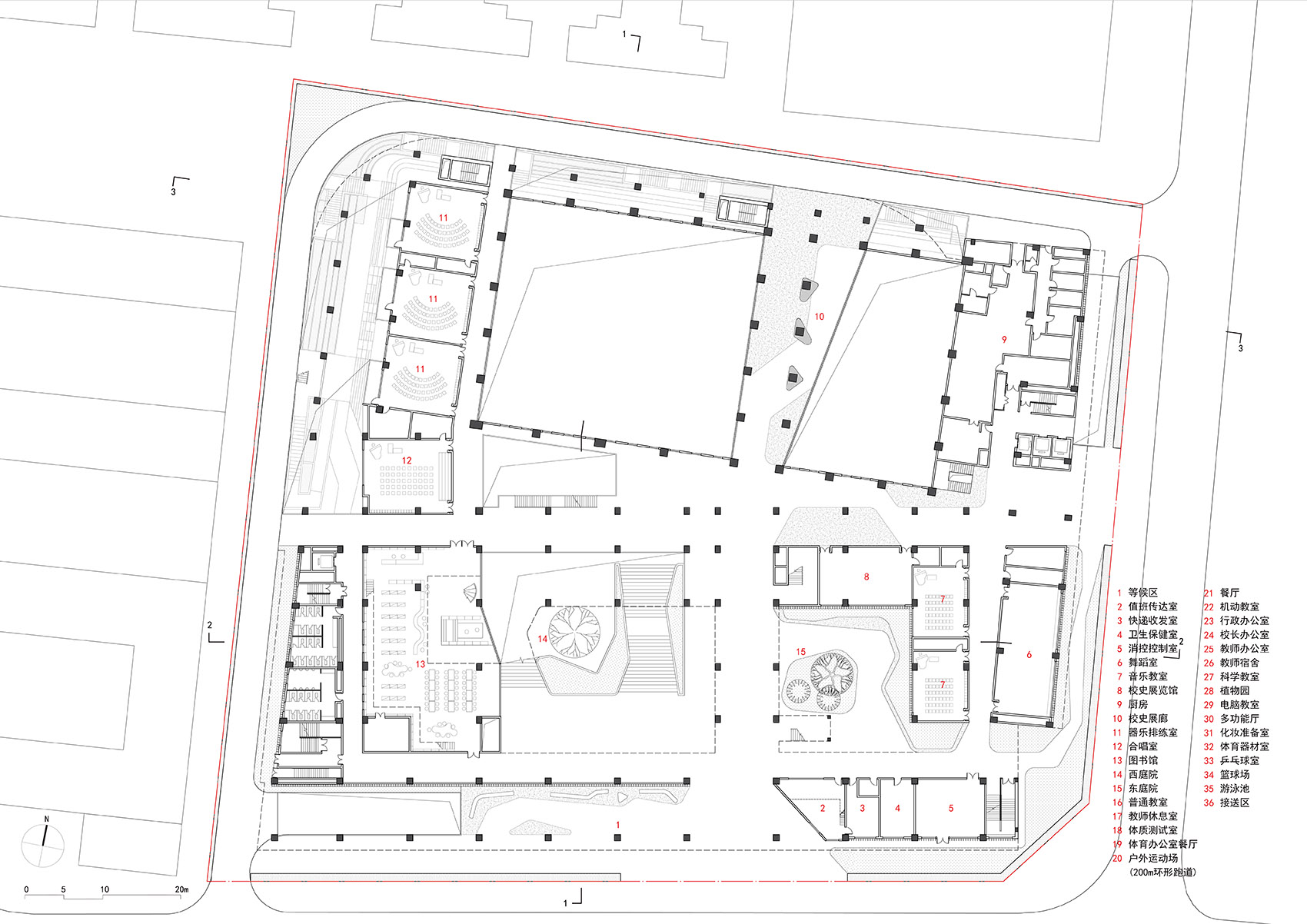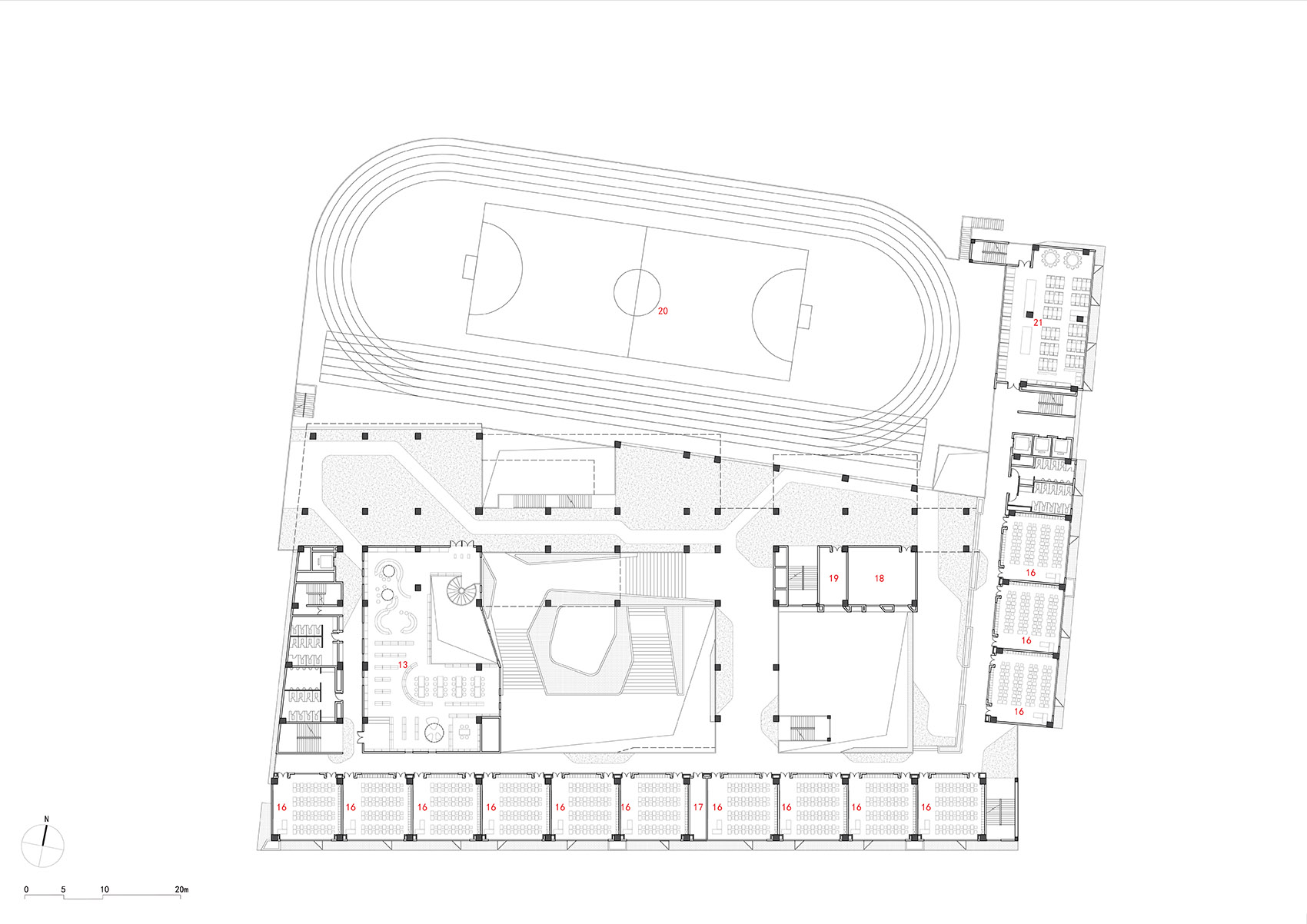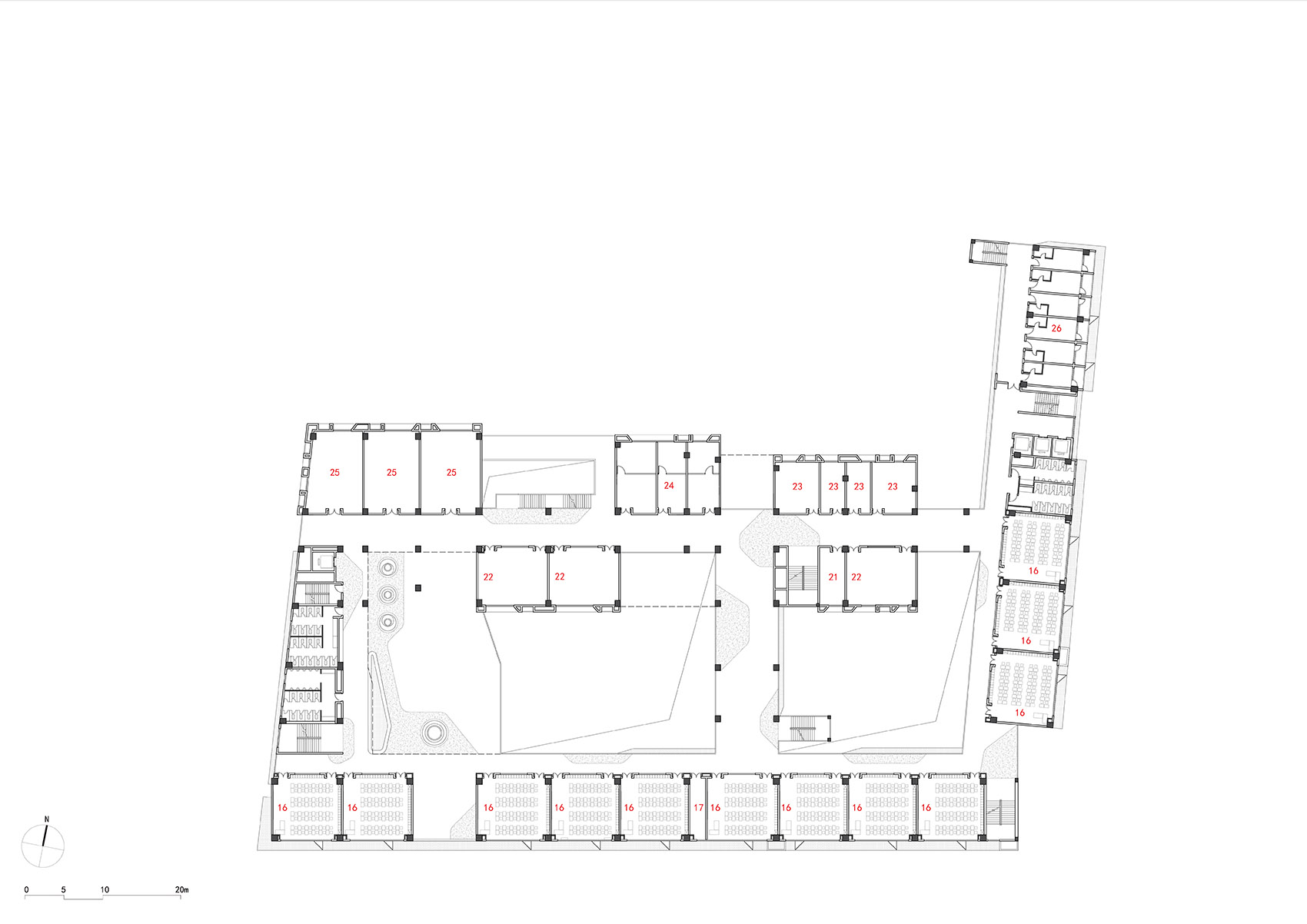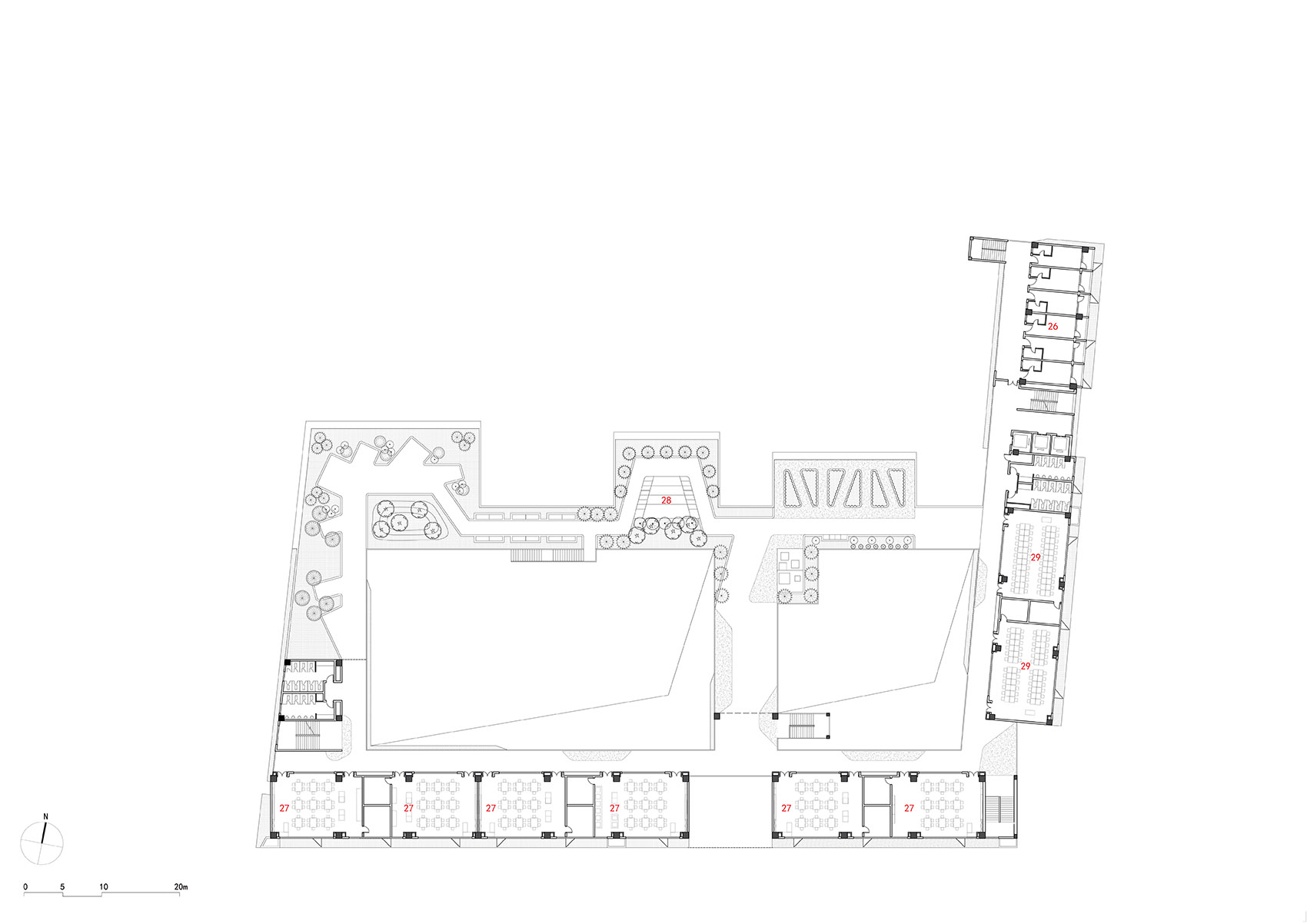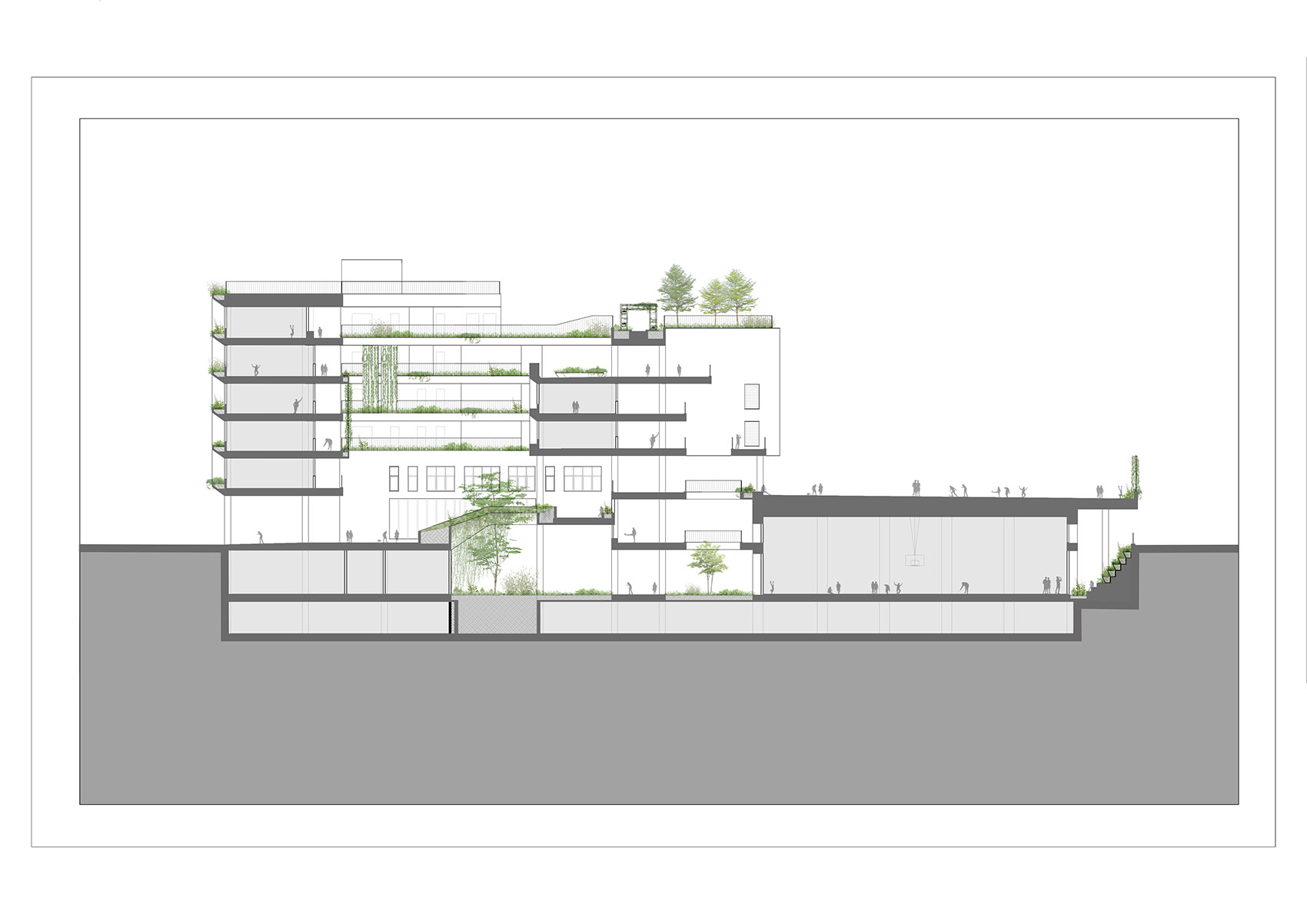拆旧建新的新洲小学是深圳新校园行动计划的“8+1”建筑联展项目之一。新校舍规模为36班,建筑面积由原来的14800M2增至38000M2,容积率达到2.7。
高密度城区的环境关系、高浓度校园的儿童活动空间,以及密集建成区中的环境品质等问题成为设计思考的重点:尊重建成环境,关注成熟社区邻里关系、社区共享和场所记忆;回归真实的“人”,关注核心使用者“小学生”,通过空间设计思考教育模式与儿童健康成长;面对噪音、风热等物理环境挑战,从建筑形态到立面细节设计寻求解决策略等。由此提出的“叠园”概念,旨在创造亲近自然的高密度校园,探索在高密度城市建成区内的高容量学校新模式。
The demolished-and-rebuilt Xinzhou Primary School is one of the “8+1” Architectural Collective Exhibition projects of the New School Initiative in Shenzhen. With a capacity of 36 classes, total GFA was increased from 14,800 M2 to 38,000 M2, and a plot ratio of 2.7.
The design priorities are the environmental relation with high-density urban areas, children activity space in a highly condensed campus, and the environmental quality in a densely built-up community: acknowledging the built-up community, attention to the relation with the established neighborhood, sharing with the community and preserving collective memory of the school venue; human centricity to focus on the core users – pupils, incorporating education models and healthy development of children into spatial design; seeking solutions to address noise, wind, heat and other physical challenges through building morphology and façade details. The concept of a “stacked campus” is thus proposed to create a highly condensed campus with nature affinity, in an attempt to explore a new model of high-capacity schools in a high-density built-up urban community.
▼项目概览,general view ©陈维忠(绿风建筑摄影)
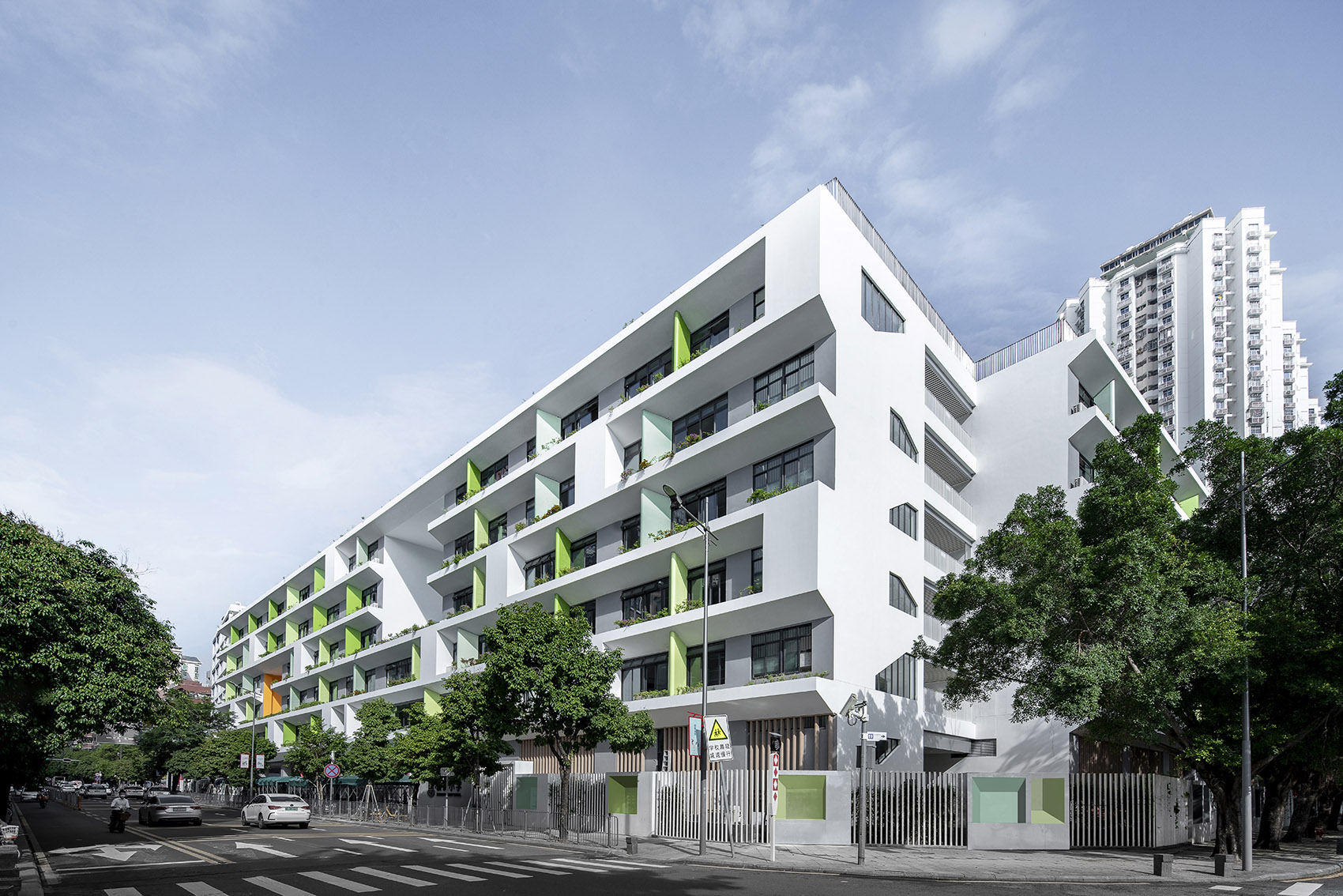
建于上世纪90年代初的原有校园,拥有由中间连廊隔开的两个绿意盎然的庭院,近三十年的场所记忆值得尊重。
The original campus built in the 1990s was characterized by two green courtyards separated by a central corridor, leaving a collective memory of 30 years that is worth preserving.
▼原新洲小学校园环境,双庭院与中廊的布局 ©东意建筑 Campus environment, dual courtyards and central corridor of the original Xinzhou Primary School
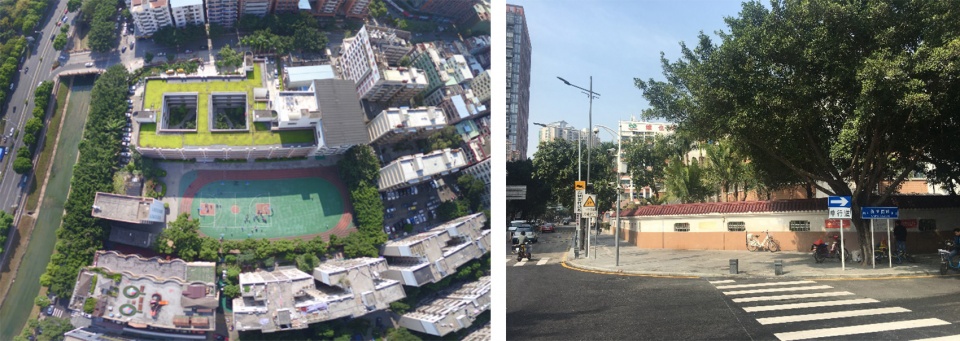
▼现状总平面&设计总平面,original site plan & design site plan ©东意建筑
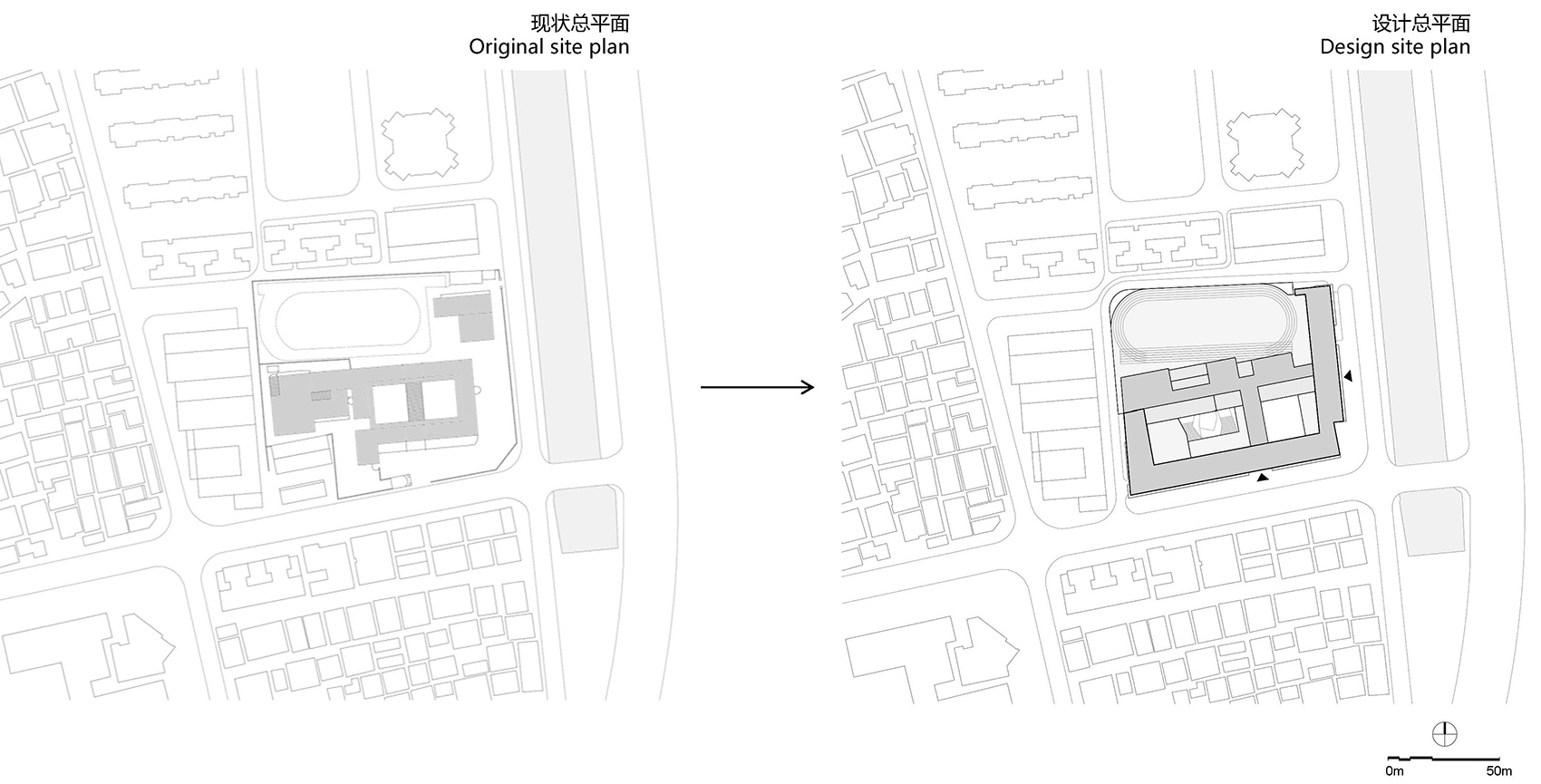
新建校园延续旧校园的空间特征,宽大的活动联廊划分出东西两个开合有致的庭院。基于城市设计立场,校园建筑在东西两侧贴线街道,南侧紧贴街道以南住宅的噪声退让线,完善城市空间形态与关系。
The new campus retains the spatial characteristics of the former site, presenting two well-placed courtyards in east and west divided by a broad activity corridor. In an urban design setting, the school buildings are aligned to the streets to the east and west, and closely matches the noise concession line of residential buildings to the south of street, in an effort to refine the urban spatial forms and relations.
▼延续原校园空间布局与城市形态的总平面关系,A continuation of the original spatial layout and relation with the urban forms ©陈维忠(绿风建筑摄影)
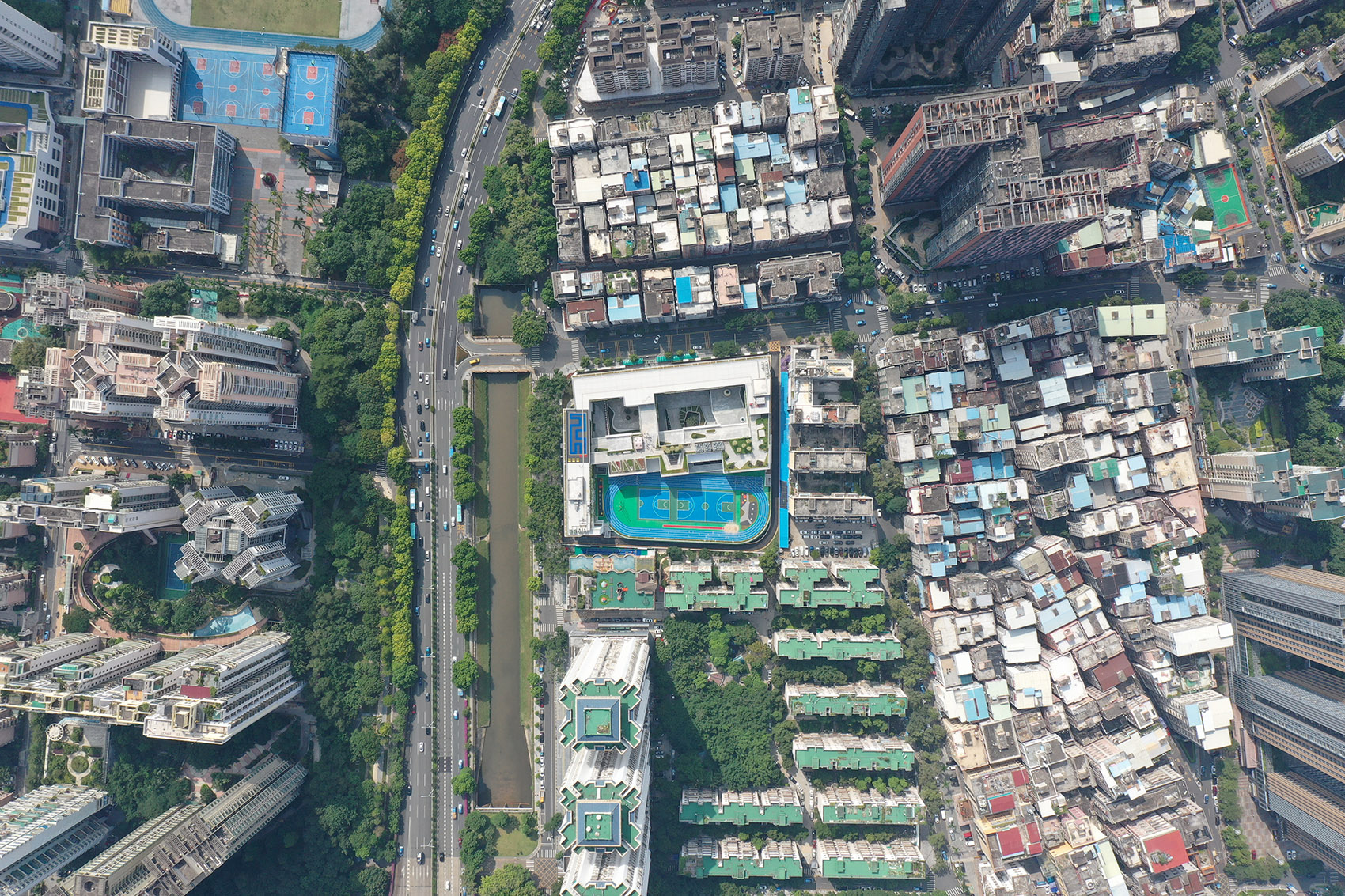
▼高密度城市环境,A high-density urban environment ©陈维忠(绿风建筑摄影)

▼校园与周边的高密度城市环境,The campus and the surrounding high-density urban environment ©陈维忠(绿风建筑摄影)
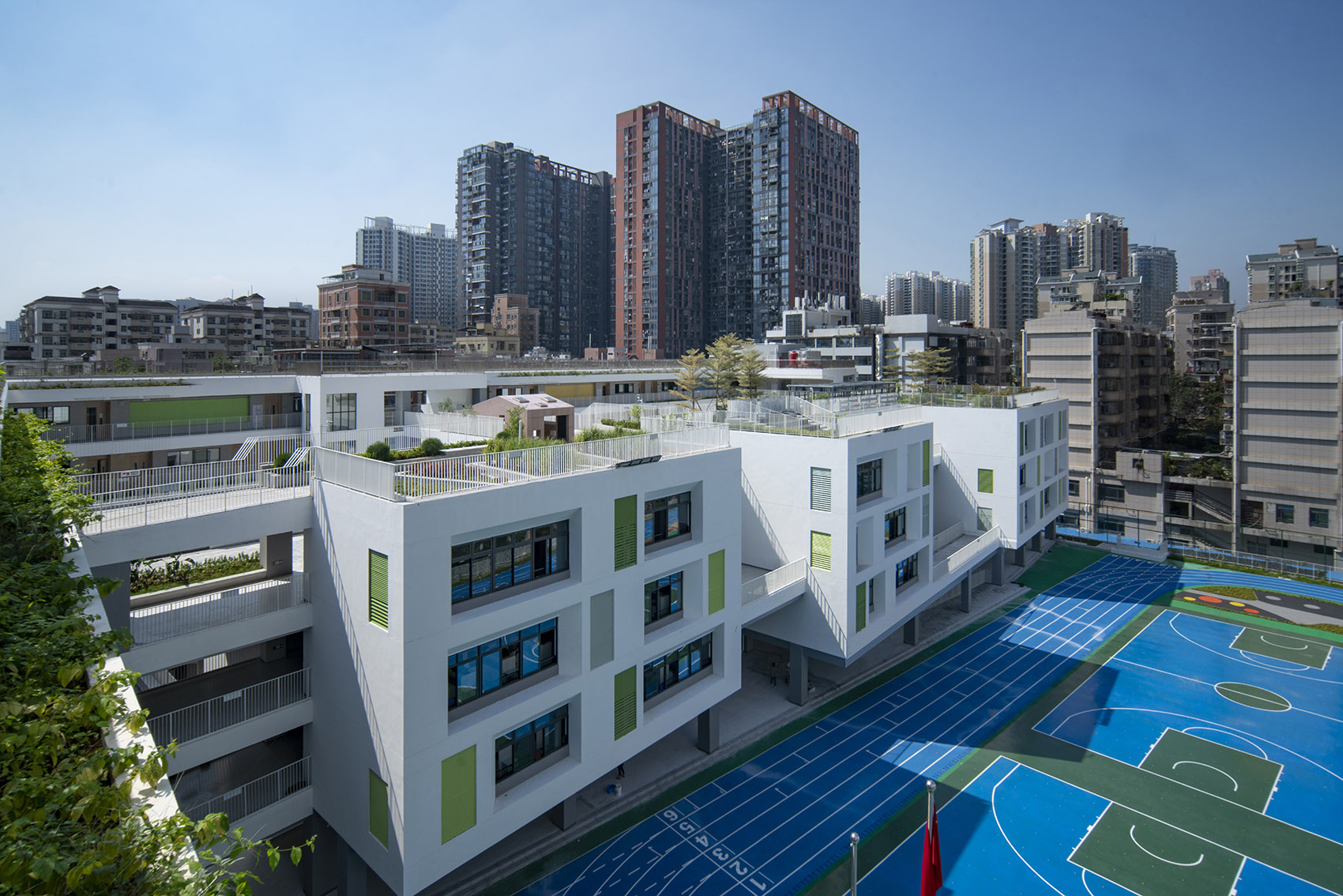
▼庭院空间,Courtyard space ©陈维忠(绿风建筑摄影)
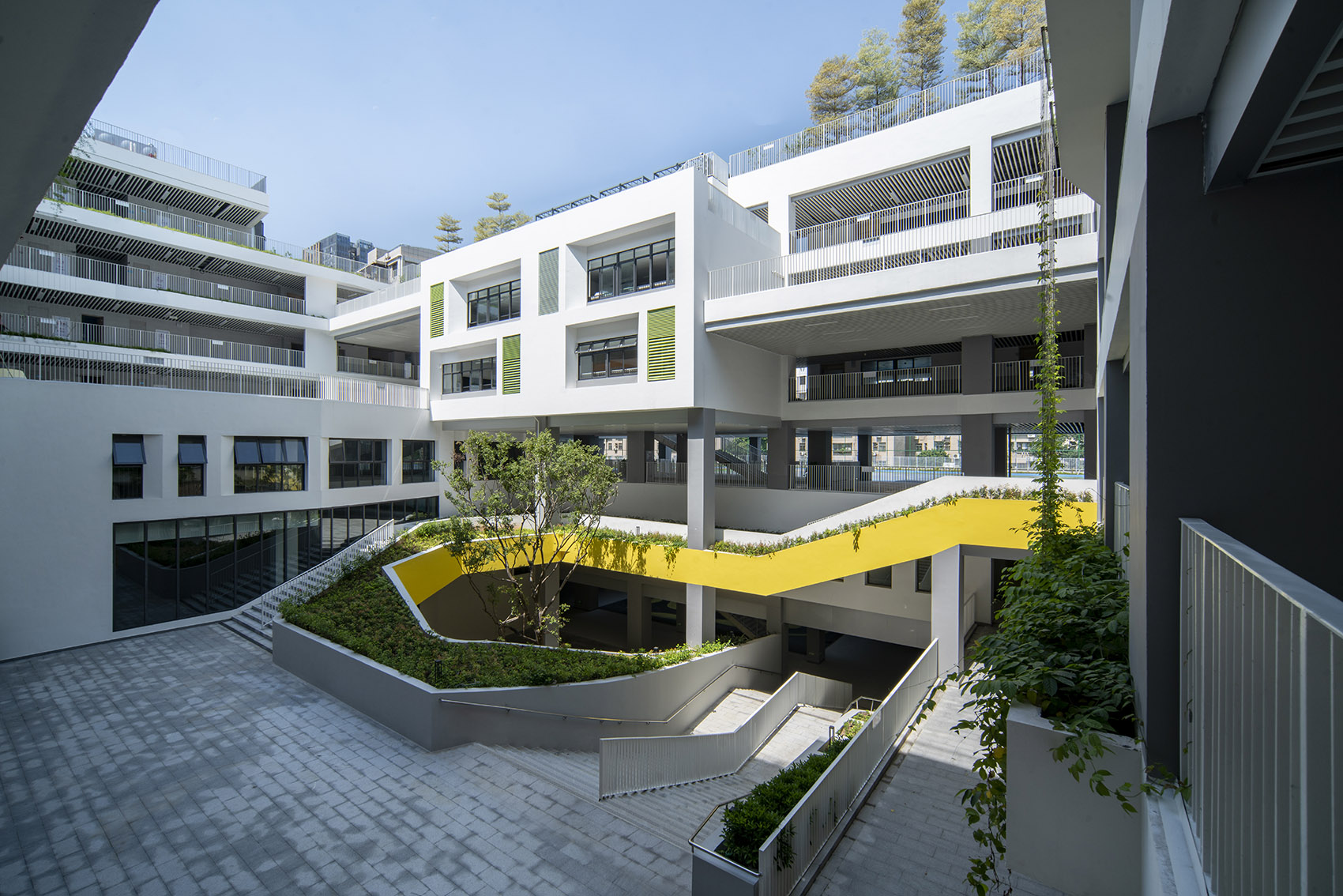
▼庭院空间鸟瞰,Courtyard space aerial view ©陈维忠(绿风建筑摄影)
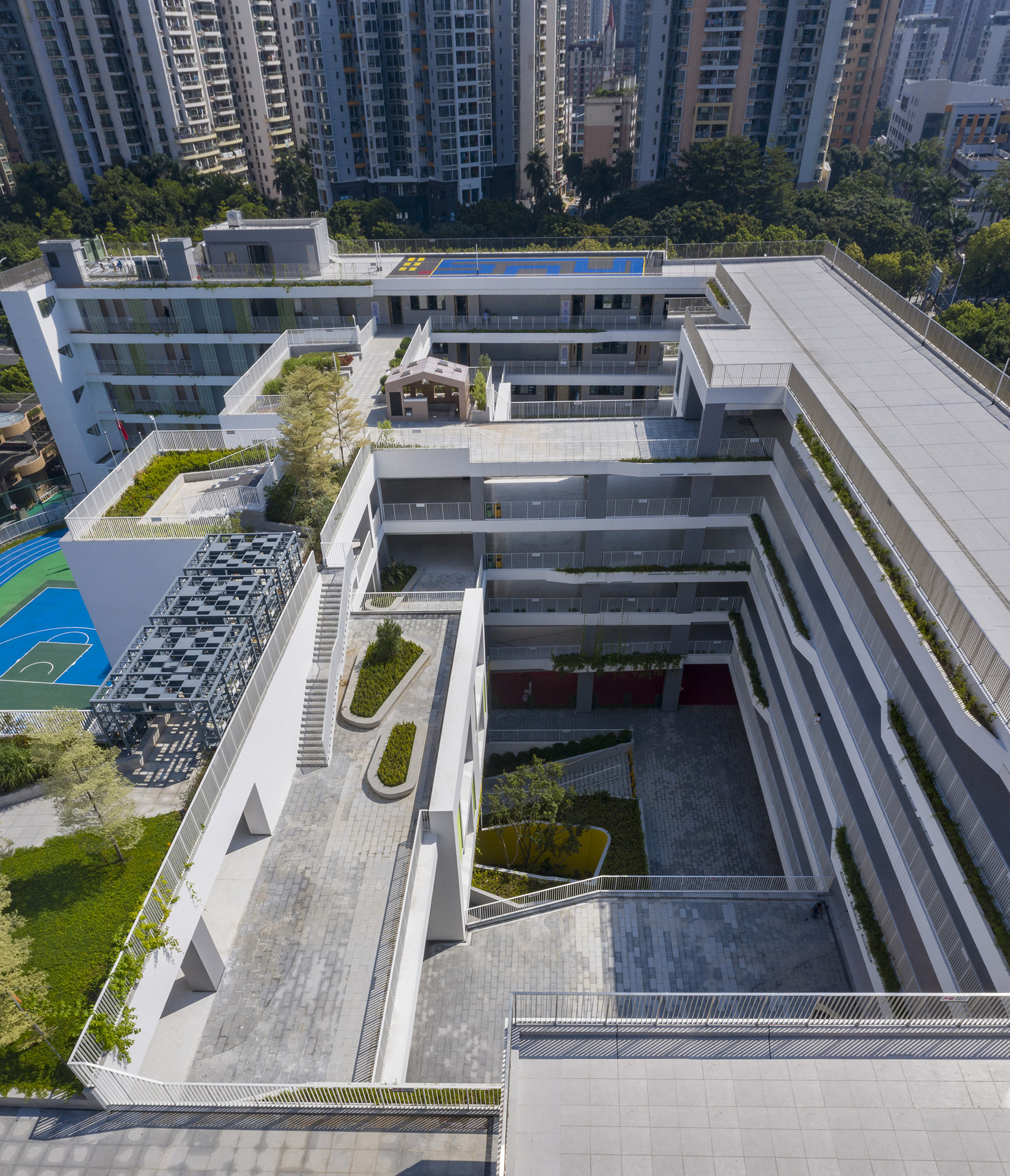
设计之初设想为无围墙校园,可在课后和休息日向社区适度开放;面向社区幼儿园空间放大,设置可的游戏设施;供社区共享的文体功能布置在首层和负一层,包括体育馆、游泳馆、音乐舞蹈教室、图书馆以及运动场等;南侧主入口采用架空处理形成宽大的校园前区,容纳家长接送。
在最终实施时,基于主管部门安全管理要求还是设置了校园围墙,但布局意图得以保留。和绿化相结合的通透围栏,将校园活动渗透到街道,为未来的开放校园预留了可能性。
The initial design envisioned a campus without walls to facilitate appropriate sharing with the community after school and during holidays; the section facing the community kindergarten is enlarged to accommodate playground facilities that can be shared; cultural and sports facilities, available for sharing with the community, are deployed in the ground floor and basement, including the stadium, swimming pool, music and dance room, the library and sports ground; the main entrance on the south is elevated and expanded into a wide and open anteroom for parents’ drop-off and pickups.
Due to safety regulations by the competent authorities, walls are erected in the final implementation. However, the design intent is preserved: a see-through fence incorporated with green landscaping projects the campus activities into the streets, preserving the option of an open campus in the future.
▼南侧校园主入口的开放架空区,家长接送空间,Elevated open area of the main entrance to the south for parents’ drop-off and pickup ©陈维忠(绿风建筑摄影)
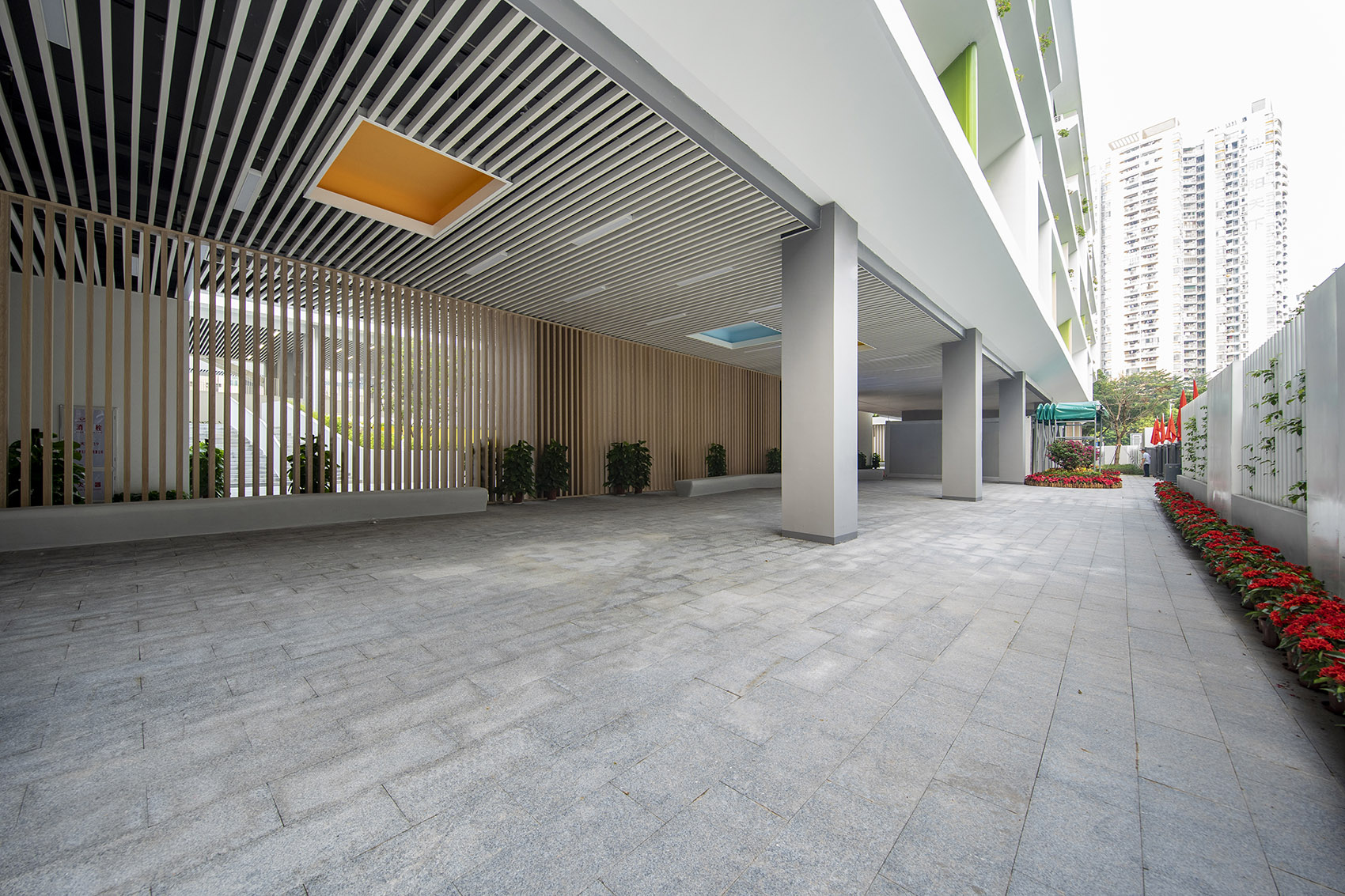
▼根据管理需求设置的通透绿化与围栏,为未来开放校园预留可能性 ©陈维忠(绿风建筑摄影) See-through, greenery fences as required by safety regulation, preserving the possibilities of open campus in the future
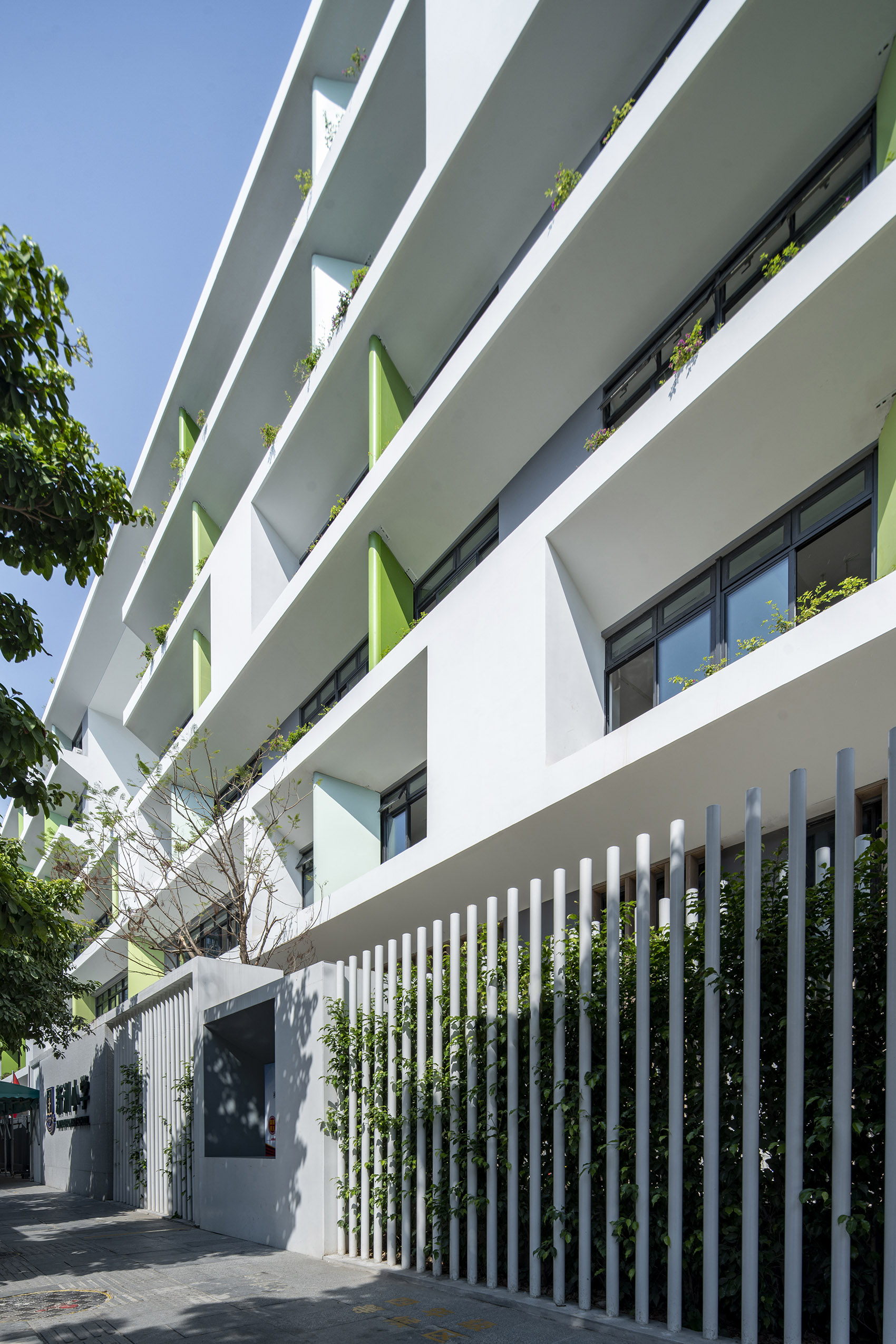
▼负一层的下沉庭院,Sunken courtyard in basement ©陈维忠(绿风建筑摄影)
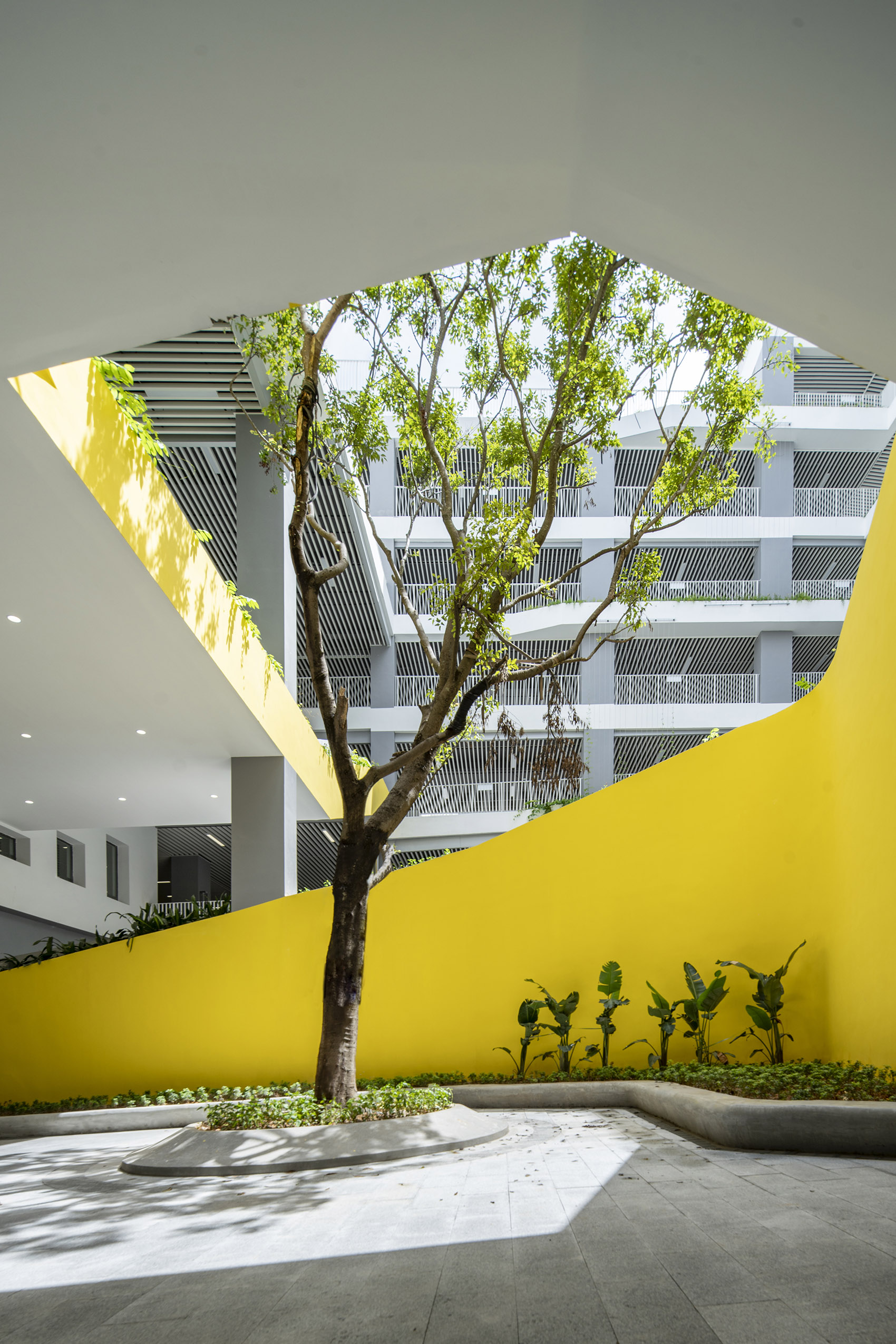
▼抬升至二层的体育场,下部架空空间与周边街区环境相衔接 ©陈维忠(绿风建筑摄影) Sports ground elevated to second floor, the vacated space underneath connecting to the neighboring community
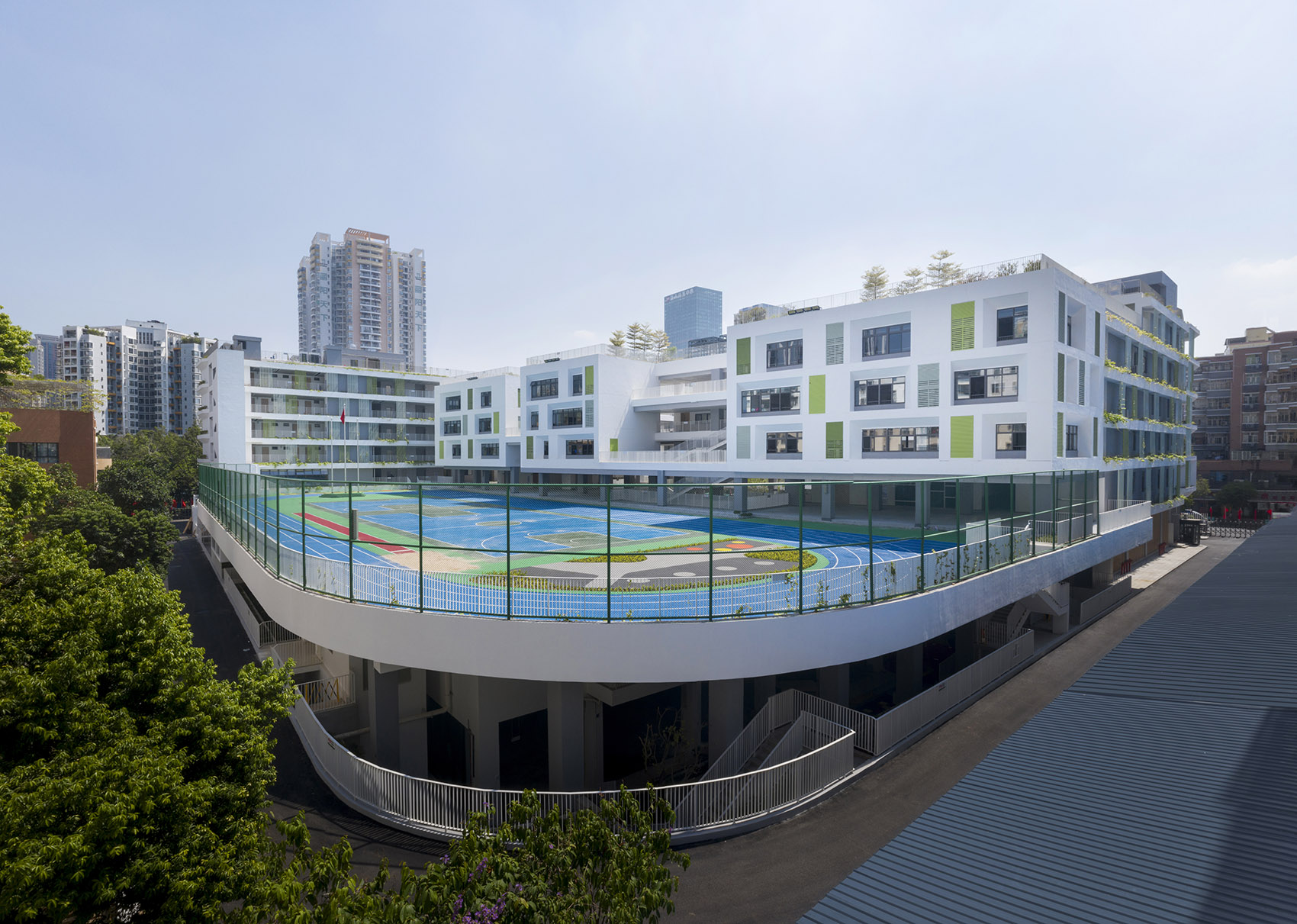
▼二层体育场与建筑架空、开放空间,Sports ground on second floor and the elevated and vacated open space ©陈维忠(绿风建筑摄影)
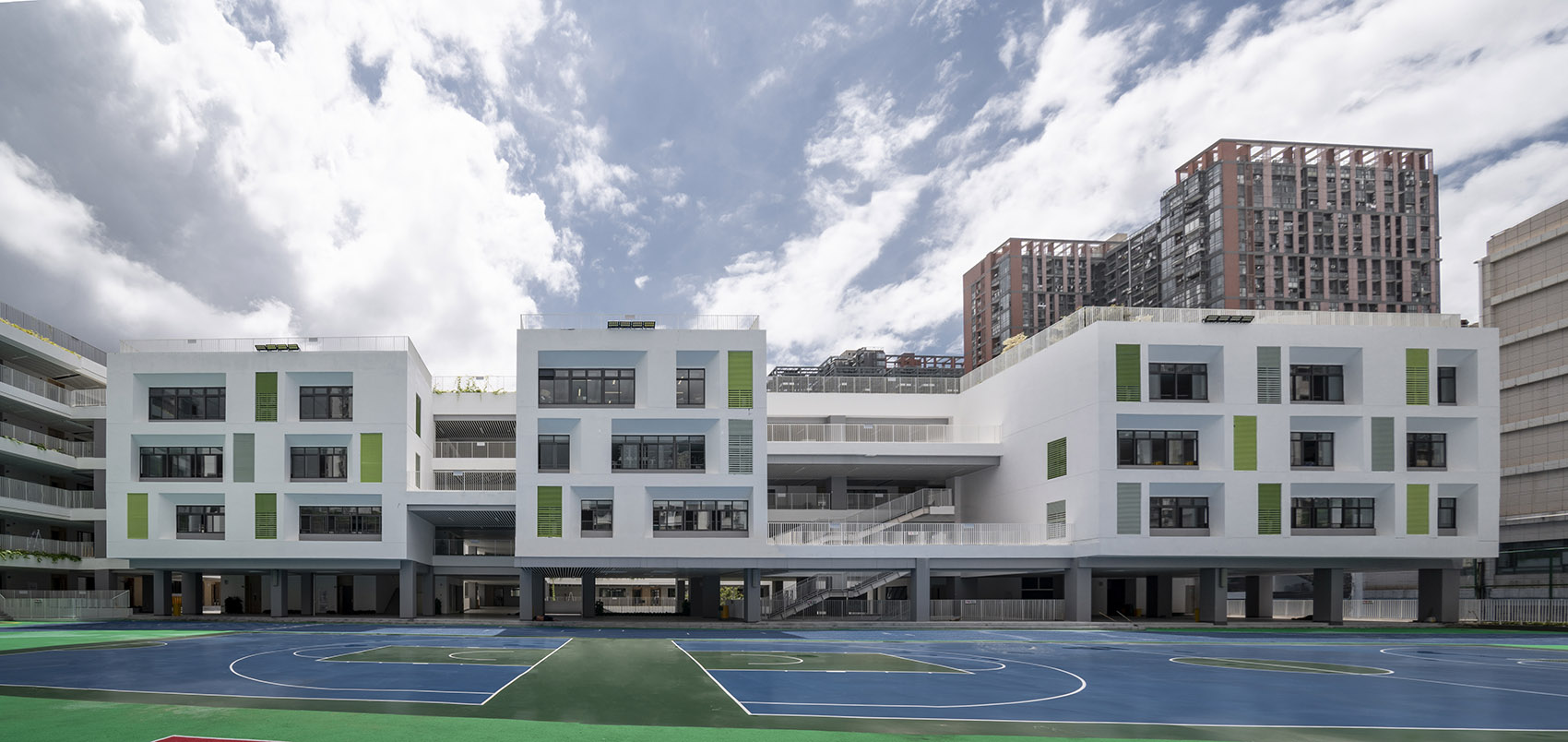
▼体育场下方架空运动区的休息与绿化空间,Space for rest and greenery in the vacated activities area underneath the sports ground ©陈维忠(绿风建筑摄影)
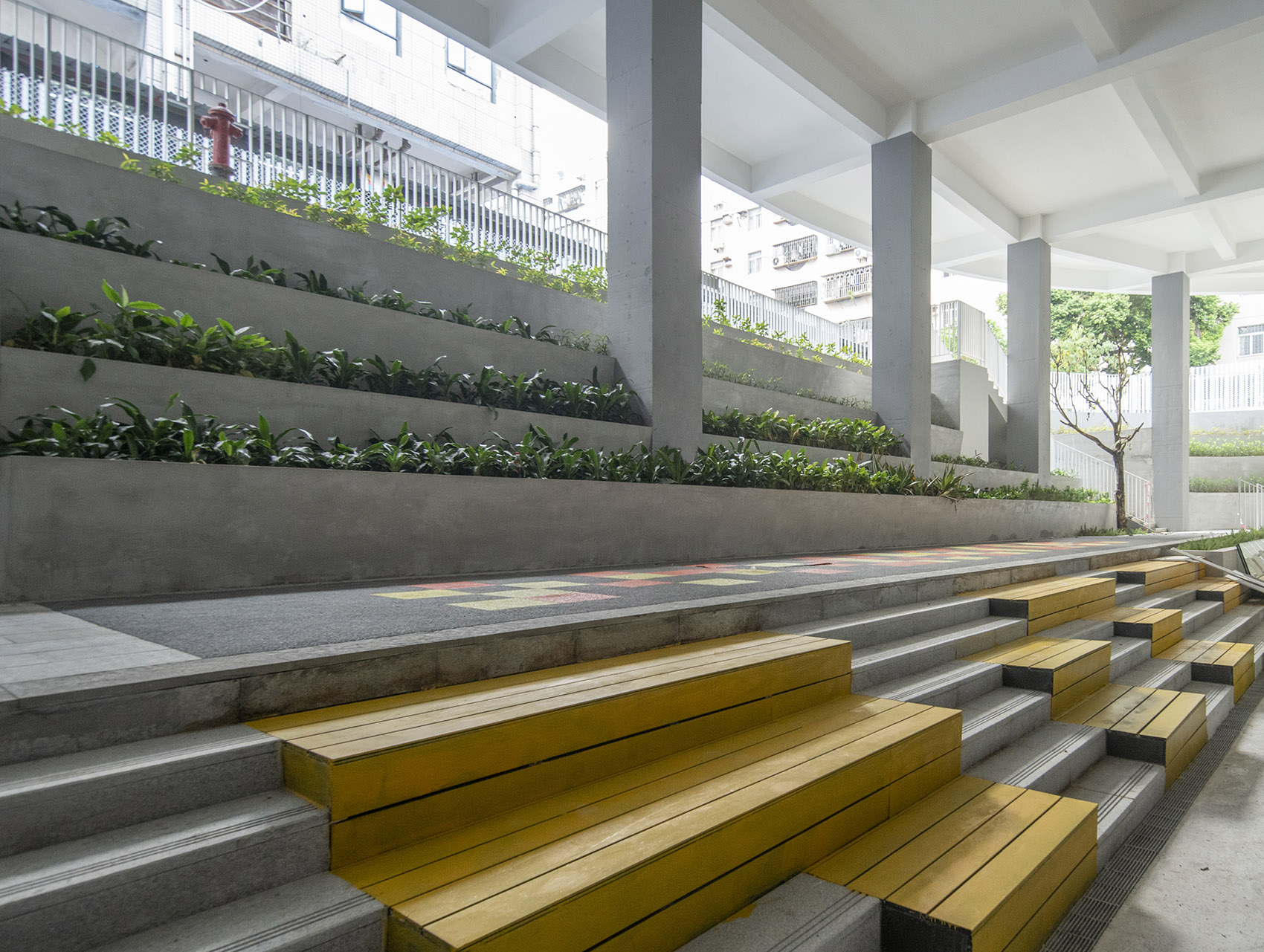
小学生在校自由时间有限,课间十分钟的总和仅40-50分钟。课间活动是儿童社会交往、环境学习、运动放松的重要途径。如何将“自由时间”转化为“自由空间”,应该成为校园空间设计的重要议题。同层活动空间的设计将影响课间活动的质量和内容。此外,小学涵盖了儿童成长变化显著的7至12岁阶段,不同年龄的活动特点差异性也需加以回应。
Pupils have very limited free time in school, the 10-minute breaktime adding up to only 40-50 minutes in a day. As breaks are important ways for children to socialize, learn from environment, play and relax, it is therefore an important subject of spatial design of a school to effectively convert the “free time” into “free space”. The design of space on a floor will have impact on the quality and contents of breaktime activities. In addition, as primary schooling spans from 7- to 12-year-olds when children experience significant growth and changes, it is necessary to address the activity differences at different ages.
▼疉园设计概念,Design concept of “stacked campus” ©东意建筑
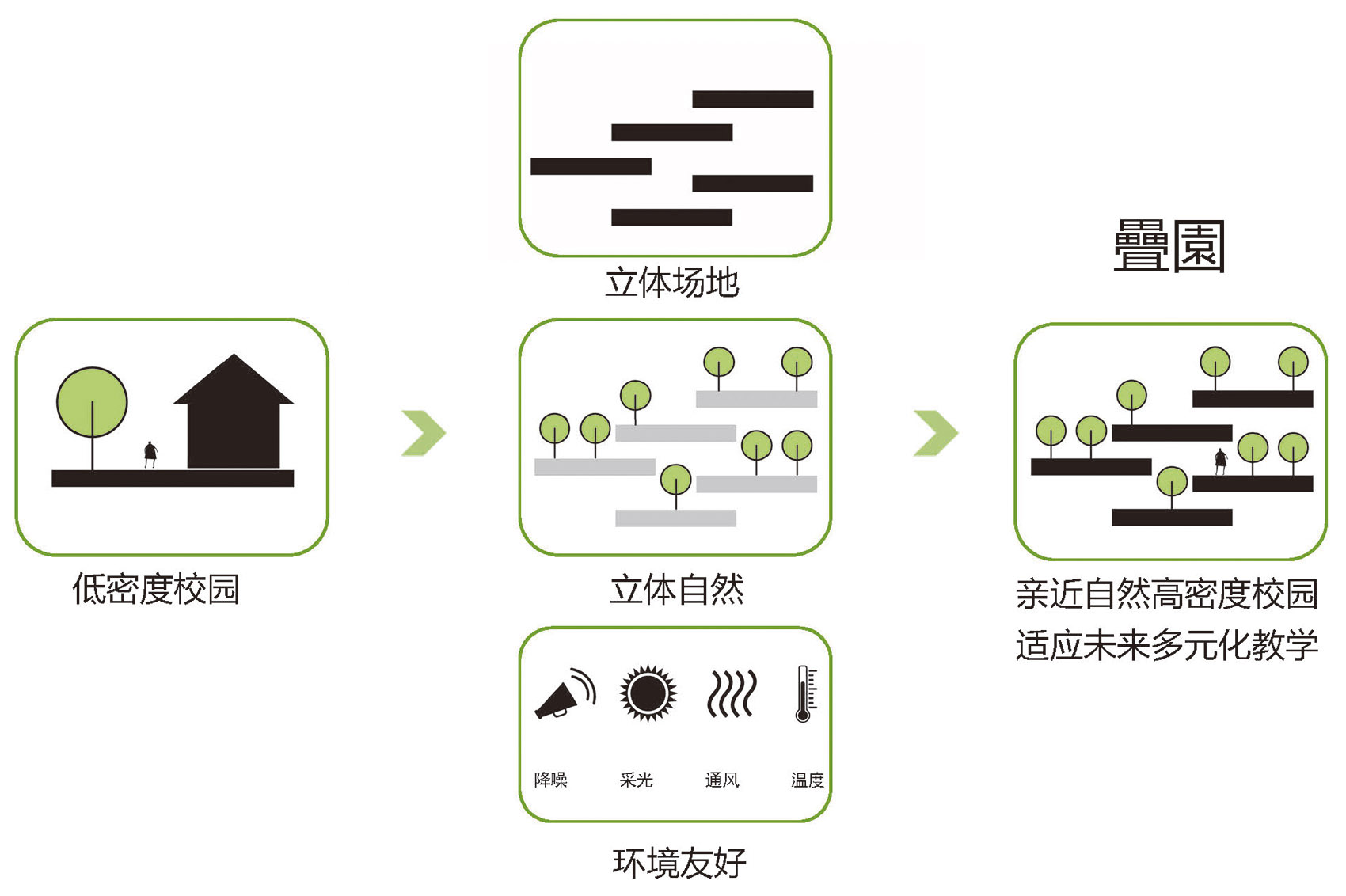
▼疉园校园方案设计效果图,Design rendering of a stacked campus ©东意建筑
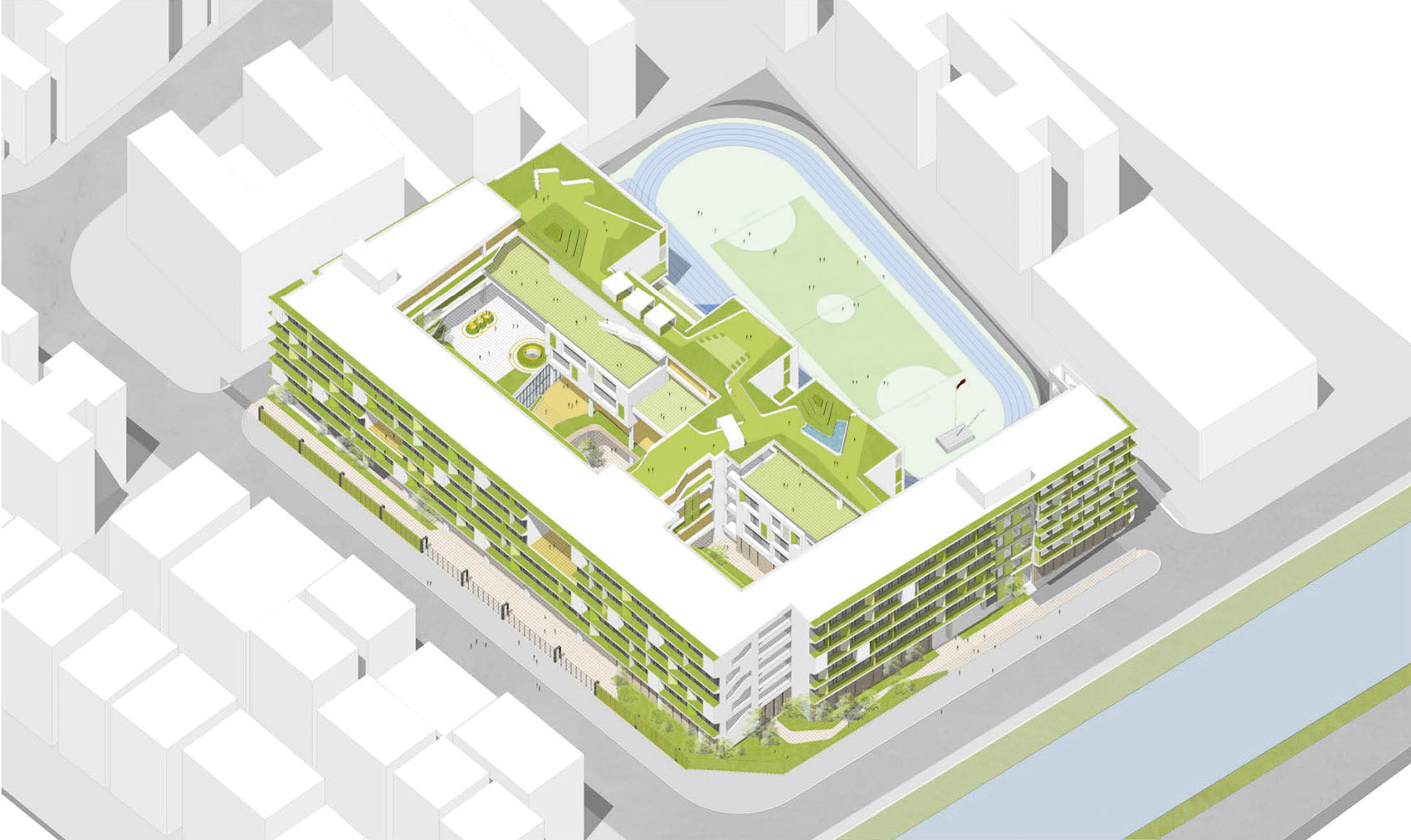
“曡园”的设计概念希望营造竖向叠加接触自然的平层活动空间,服务学生课间行为。二层有较大的架空层、连接运动场地,为低年级学生提供足够的戏耍空间;三层结合图书馆屋面、宽大连廊组织活动场地;四层在兴趣教室之间形成多个活动庭园,适应高年级活动及兴趣学习的多样化选择;南翼六层专业教室平层对应北翼的屋顶农场,有植物园地、户外教室、立体花架廊及农园小屋等丰富的课外学习场地。
The design concept of “stacked campus” aims to creating layers of planar activity space with nature affinity that are stacked vertically, allowing for better breaktime activities. Ample room in the open space of second floor, connected with sports venues, provides sufficient space of playing and games to junior students; the third floor offers activity space in connection with the library and the broad corridor; multiple activity courtyards are formed among classrooms on the fourth floor, well suited for senior students and diverse extra-curriculum programs; the academic classrooms on the sixth floor of the south wing are aligned with the rooftop farms on the north wing, with botanic garden, outdoor classroom, overhead flower corridors and farming huts to offer rich extra-curriculum experience.
▼层次丰富的活动平台,Multi-layered activity platforms ©陈维忠(绿风建筑摄影)
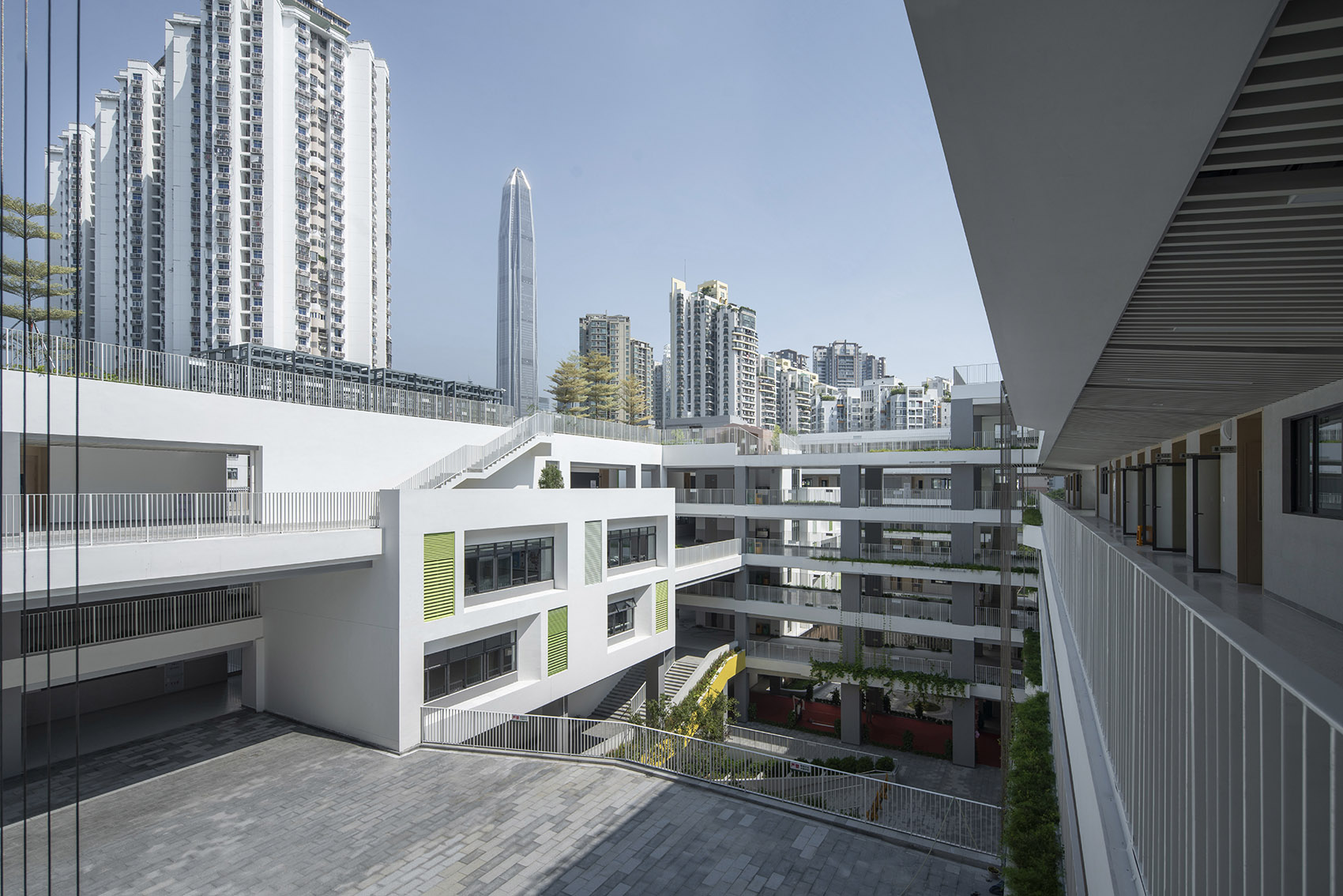
▼二层屋顶体育场与开放架空的活动空间,Rooftop stadium on second floor with open and vacated activity space ©陈维忠(绿风建筑摄影)
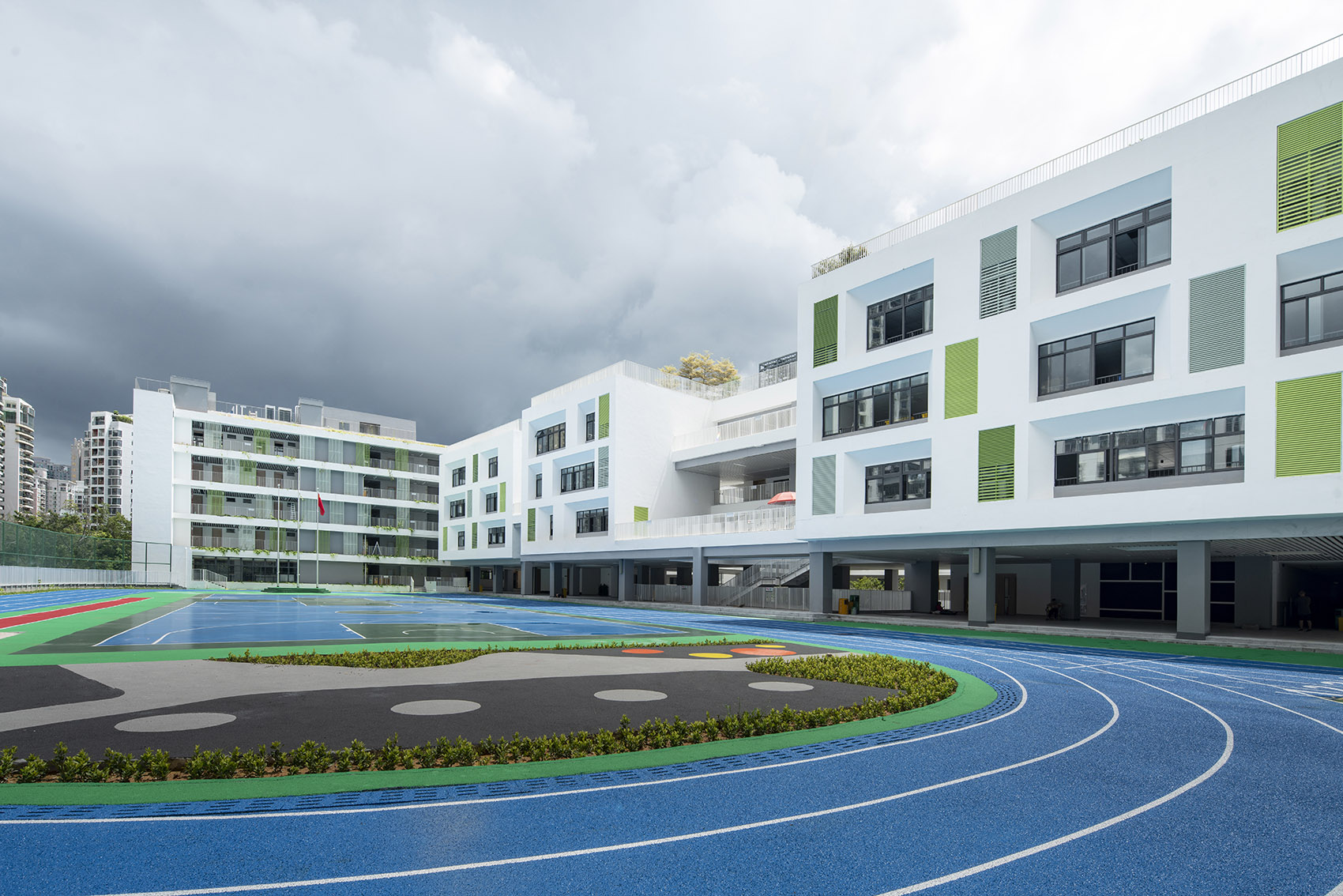
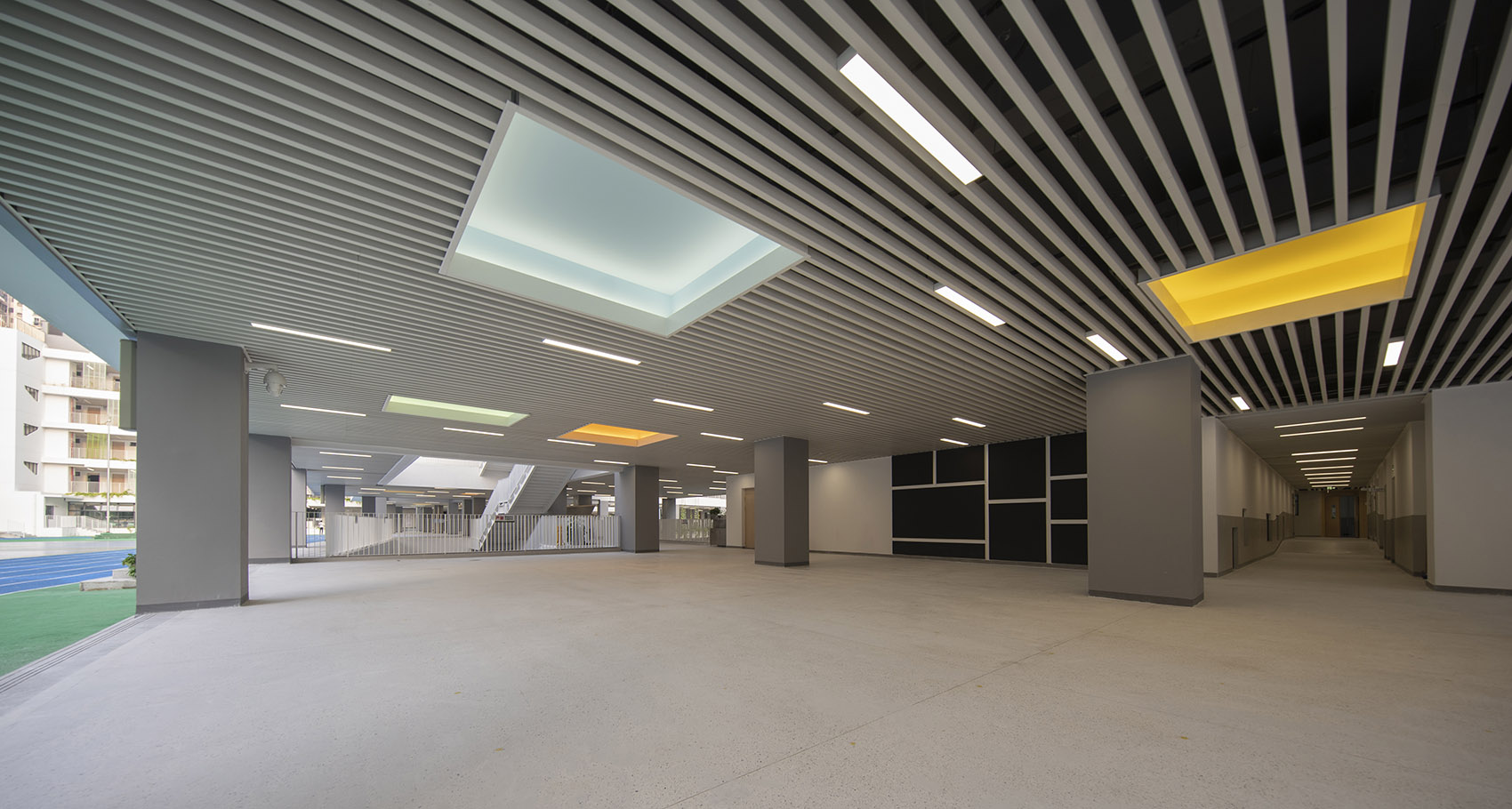
▼屋顶农场:种植园、自然教学平台、农园小屋等丰富的自然体验与学习场地 ©陈维忠(绿风建筑摄影) Rooftop farm: botanic garden, natural teaching platform, farming huts to offer rich natural experience and learning venue
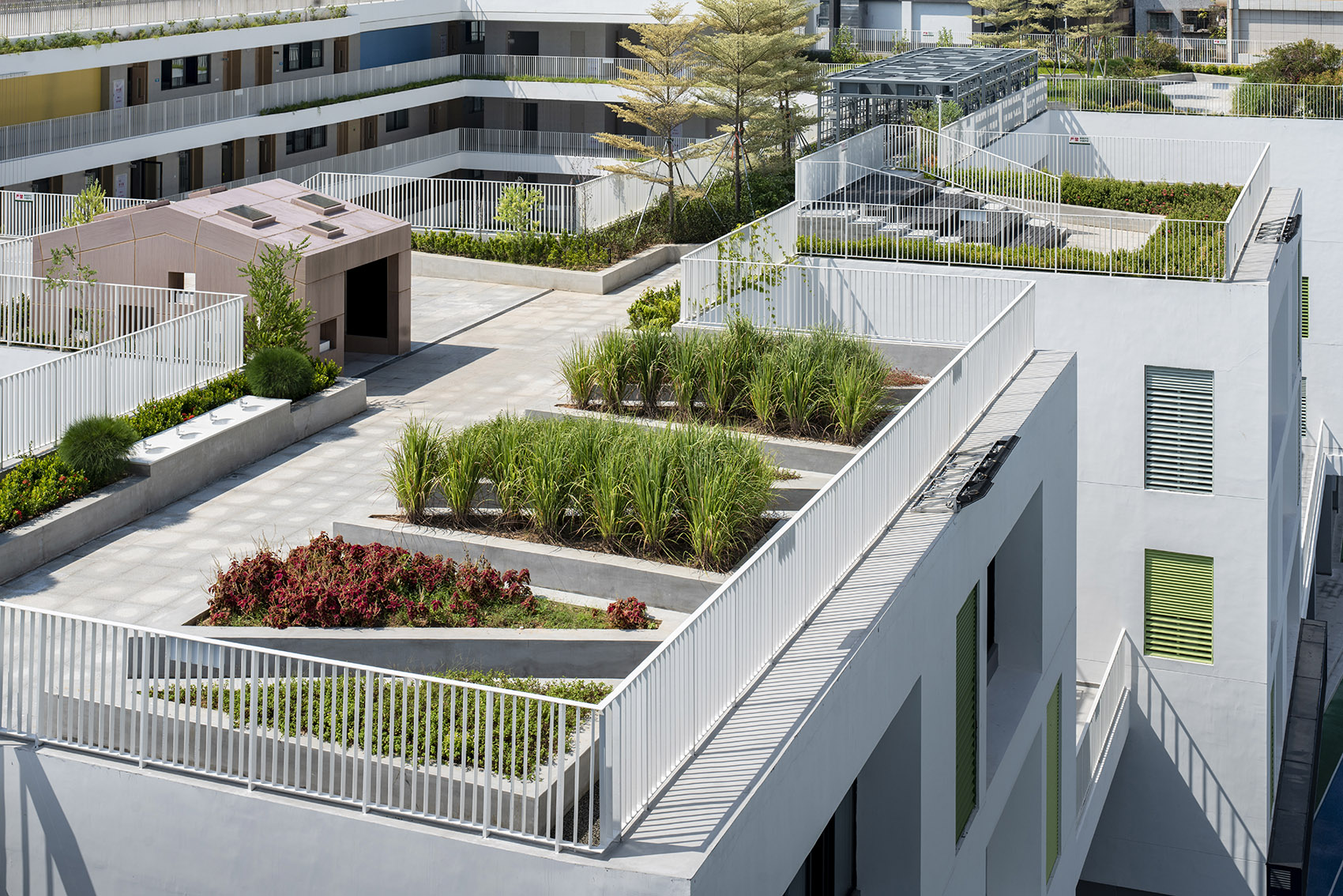
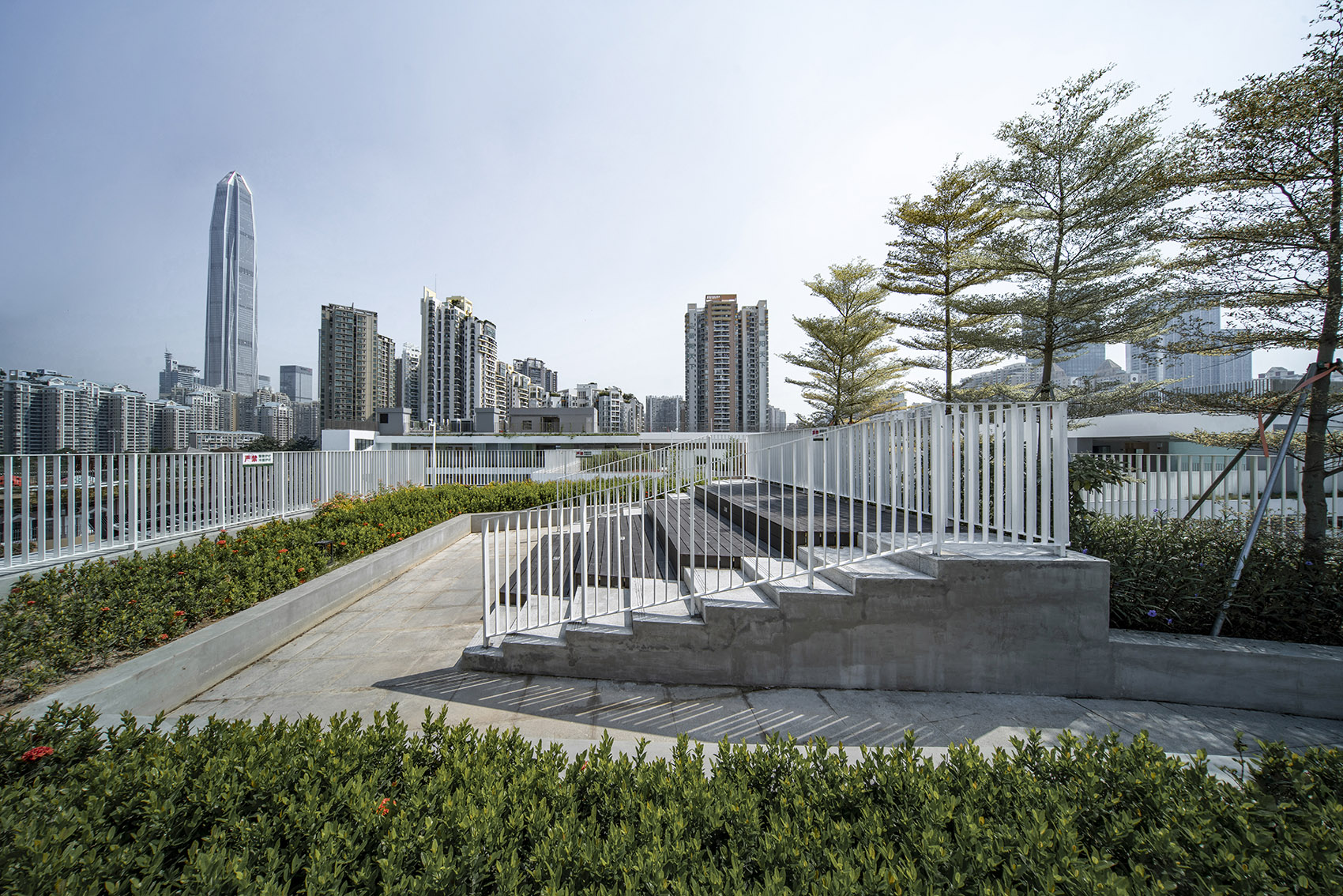
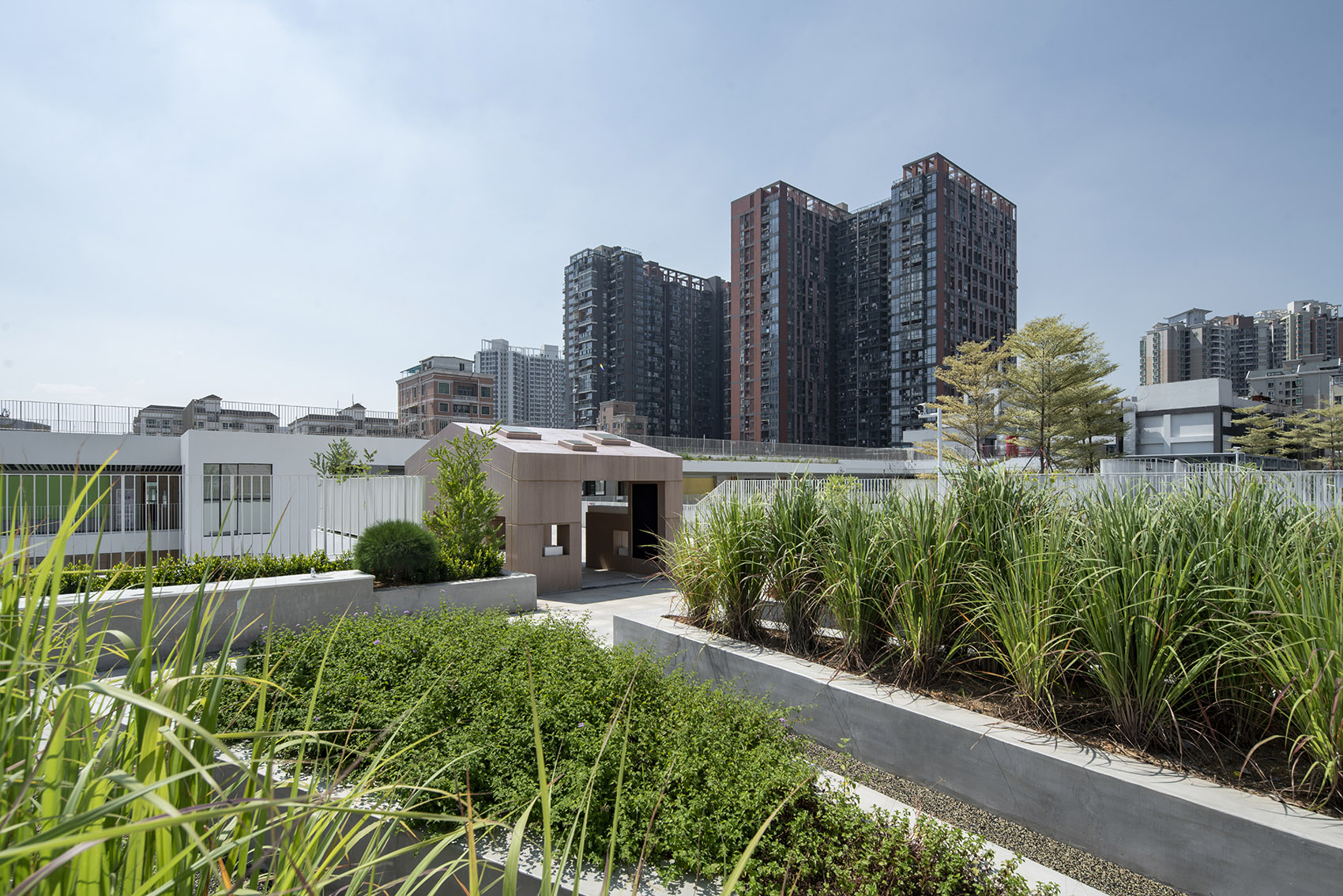
水平及竖向交通组织围绕两个庭院通过联廊形成平层环流式活动空间系统。各层廊道、平台及小庭院的“虚”,与功能体量的“实”形成对话,构成了尺度适宜、互动交融的庭院空间。
Surrounding the two courtyards, vertical and horizontal traffic structures form a planar and circular activity spatial system through corridor connections. The interplay of the “void” (corridors, platforms and mini-courtyards) and “solid” of functional mass creates an adequately sized, interactive and mingled courtyard space.
▼环绕庭院的廊道与体量“虚实”对话,风景交融 ©陈维忠(绿风建筑摄影) Interplay of “void and solid” of corridors and mass, a mingled scene
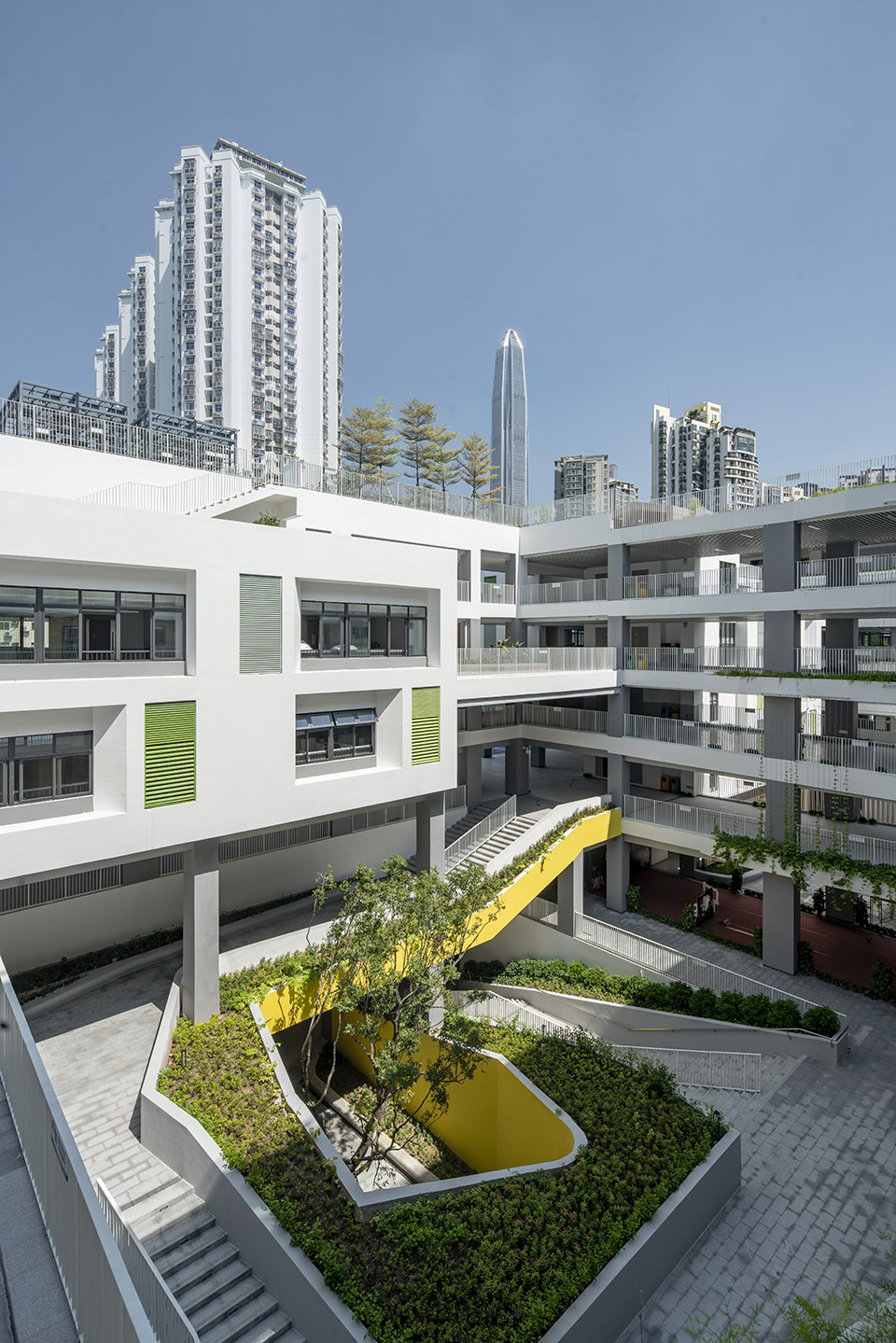
▼供爬藤植物生长的格栅,Grilles for vines ©陈维忠(绿风建筑摄影)
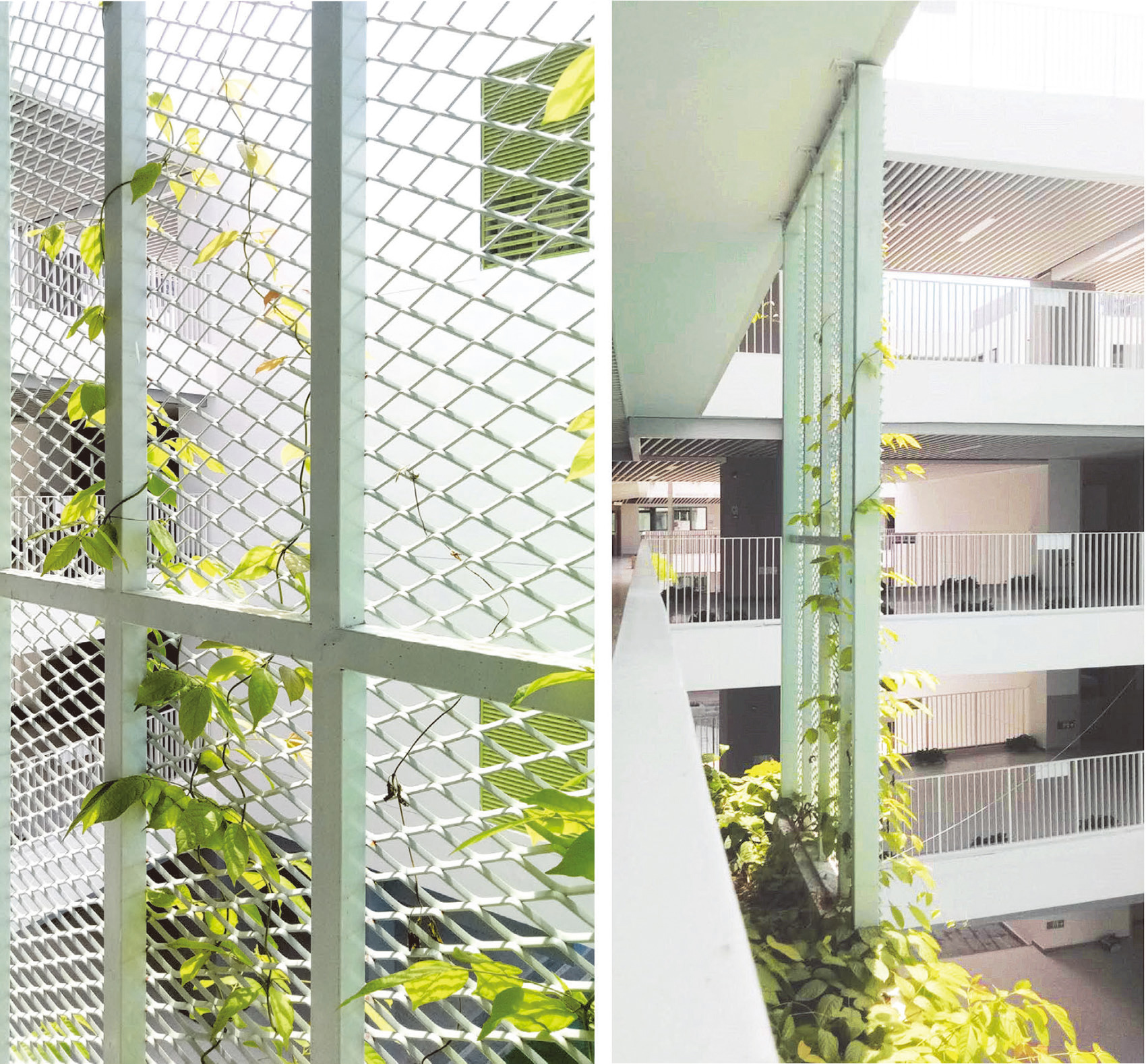
高密度的城市环境及周边繁忙的城市干道,导致校园东侧及南侧环境噪音较大,周边环境风热条件欠佳。建筑的气候舒适性设计以及降噪措施是建筑布局和形态设计的主要着力点。利用南翼与东翼交汇处为整个建筑群留出进风口;南侧主入口的架空层、长向南立面上对应各层活动平台打开的通风豁口,成为了立面上空间表达的“透明性”焦点。
▼气候空间通风示意,Diagram of spatial ventilation
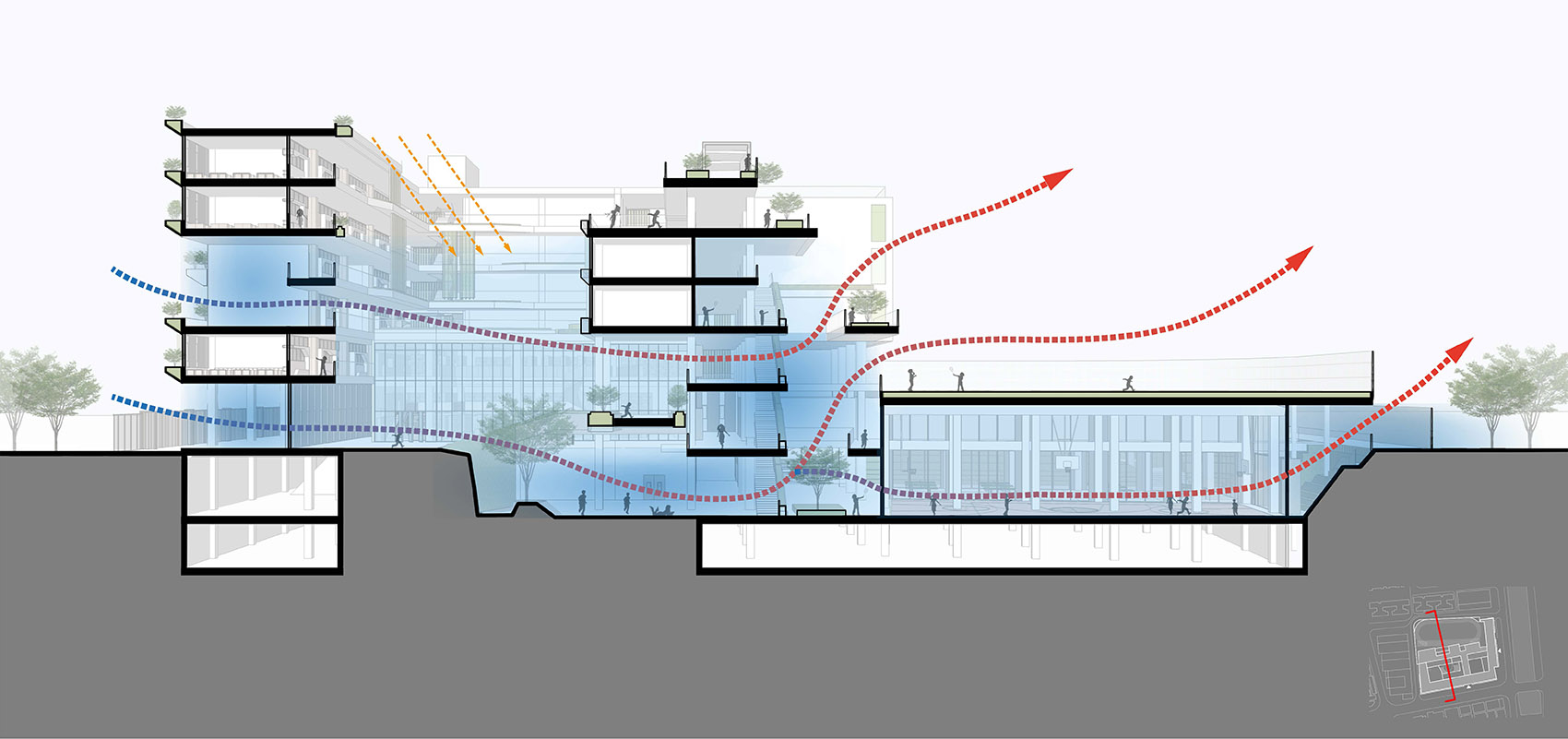
Due to the high-density urban environment and busy urban traffic, the campus is facing greater noise in the east and south sides, and the ambient ventilation and heat conditions are not optimal. Climatic comfort and noise reduction of buildings therefore become important considerations of the architectural layout and morphology design. Air inlet for the complex is created at the intersection of south wing and east wing; the open floor of south entrance and the ventilation openings of activity platforms at each floor on the south façade become the focus of “transparency” in façade spatial expression.
▼促进建筑通风的立面开口及其形成的立面语言与活动空间 ©陈维忠(绿风建筑摄影) Façade openings to promote building ventilation, and the façade language and activity space created
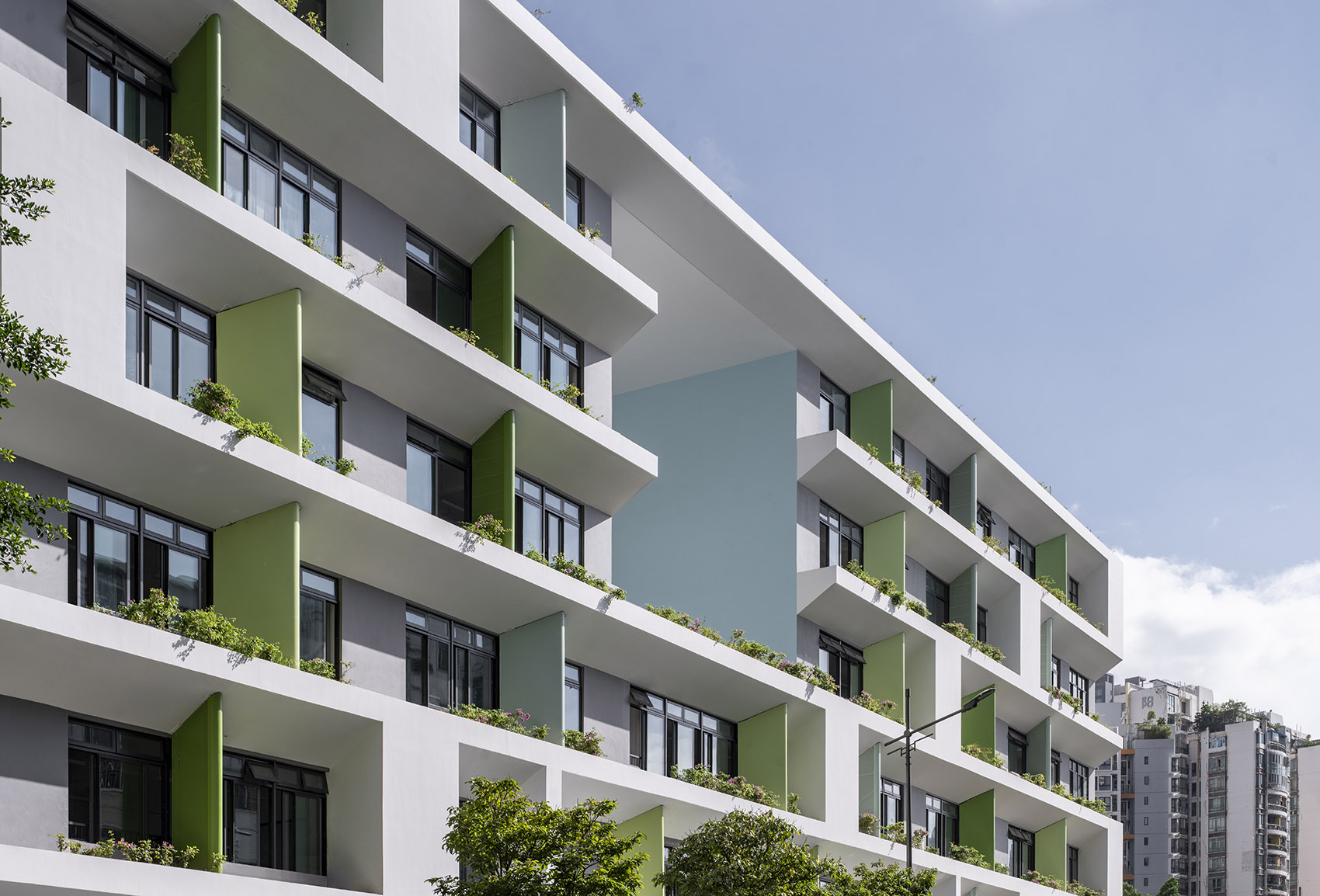
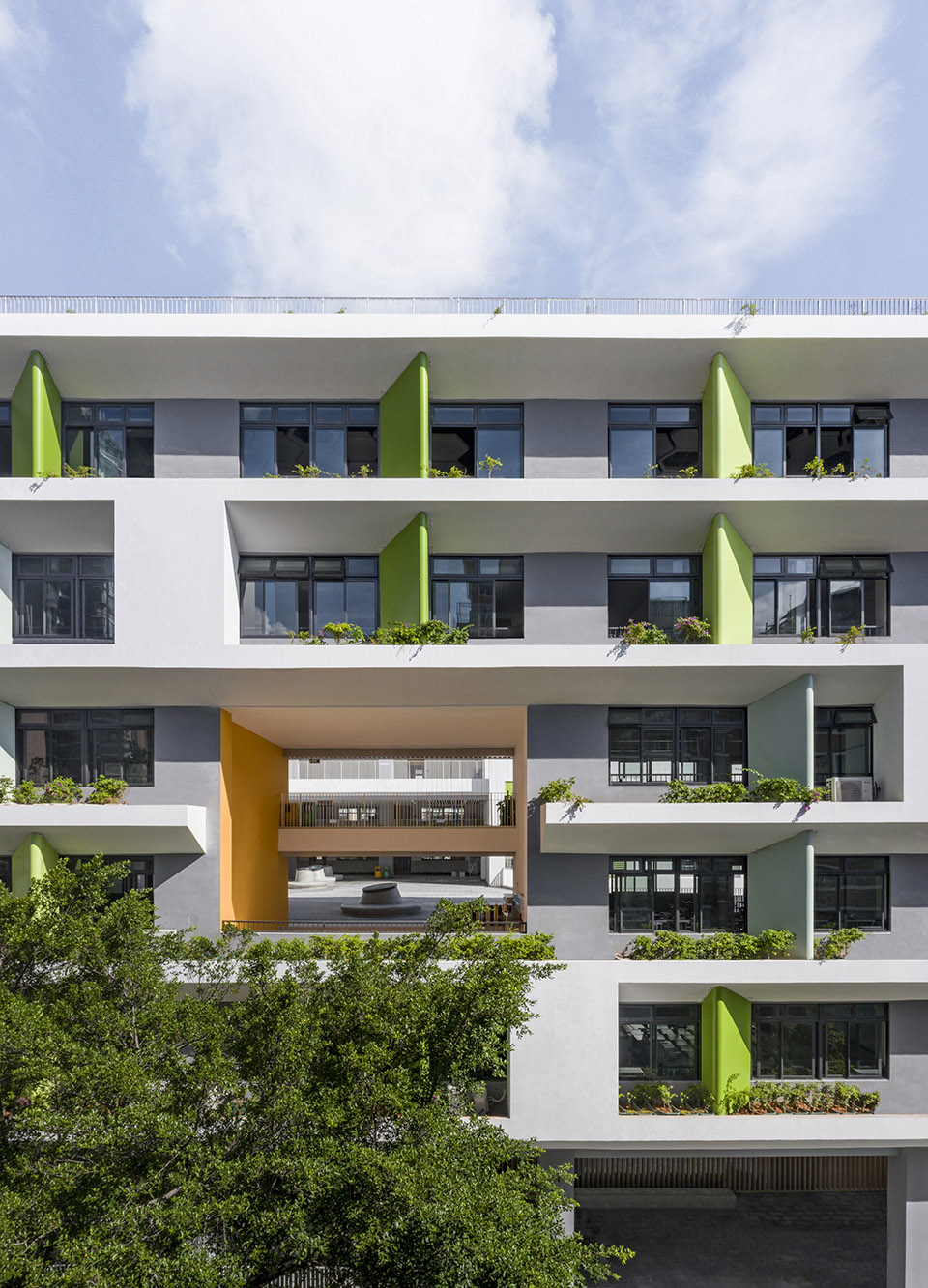
南翼和东翼课室直接面对周边道路,空调制冷工况下通过关闭外窗达到隔噪要求。过渡季开窗的情况下,降噪通风构件可实现自然通风与降噪相结合,减少空调制冷时长及能耗,提升课室健康环境品质。立面上设计了可以反射下部道路噪声的斜向悬挑板,也作为立体绿化和放置空调外机的部件。水平板与垂直降噪构件也成为南方建筑遮阳挡雨构件,并形成富于技术理性的立面形式。
Classrooms in the south and east wings are directly facing the neighboring streets. Noise reduction is achieved by closing the external windows under air-conditioning. When windows are open during transitional seasons, the noise-reduction and ventilation components deliver the benefits of natural ventilation and noise reduction, minimizing air-conditioning time and energy consumption, and improving health and environmental quality of classrooms. Slanting cantilevers are designed on the façade, which deflect noise from the streets below, and also serve as components for greening and for air-conditioners. Horizontal plates and vertical noise-reduction components become shading and rain sheltering components for south China climate, forming façades with technical rationality.
▼整合降噪通风构件与斜向悬挑板的立面系统 ©陈维忠(绿风建筑摄影) Façade system integrated with noise-reduction and ventilation components and slanting cantilevers
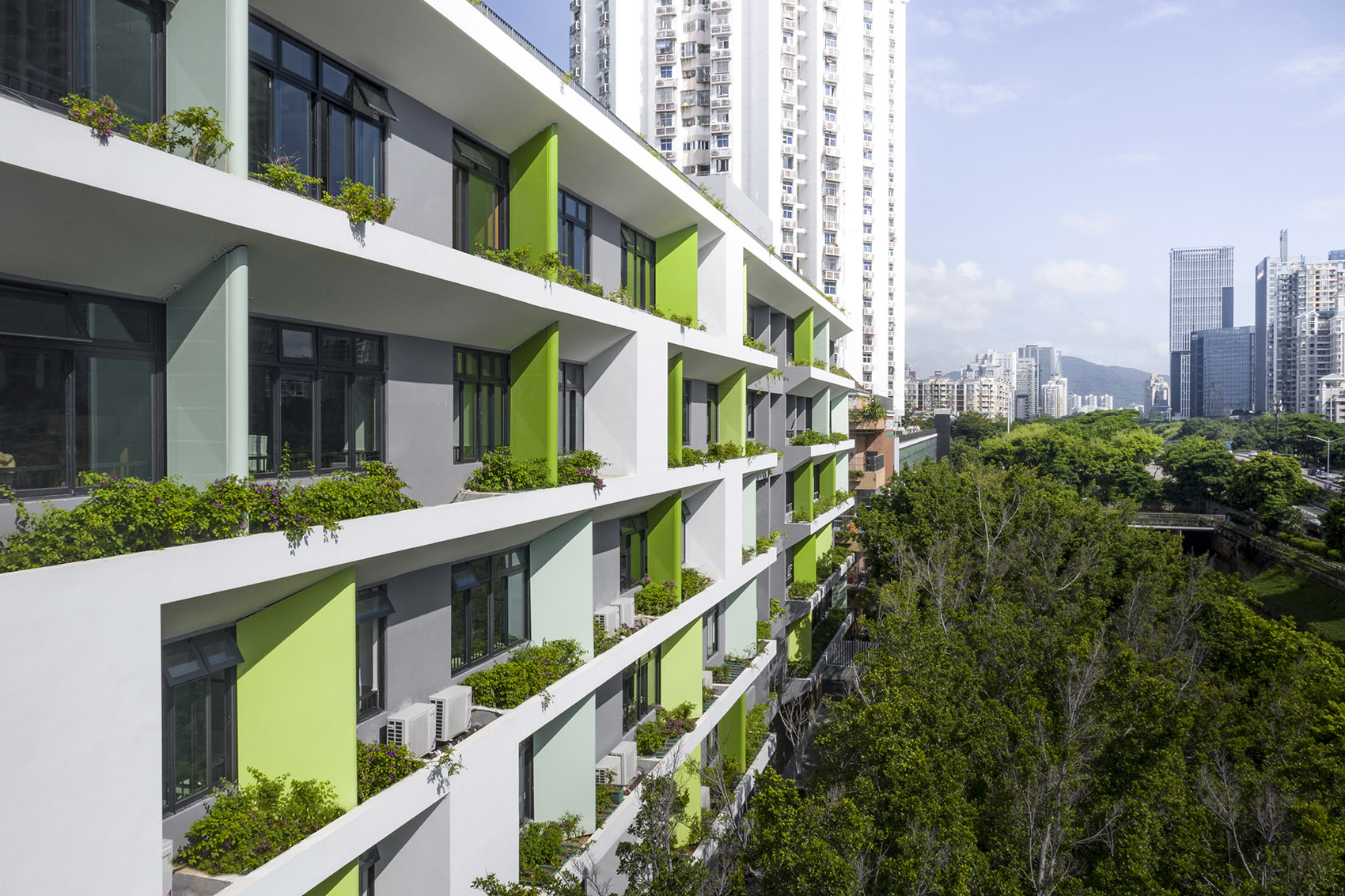
▼沿河立面,Façades along the river ©陈维忠(绿风建筑摄影)
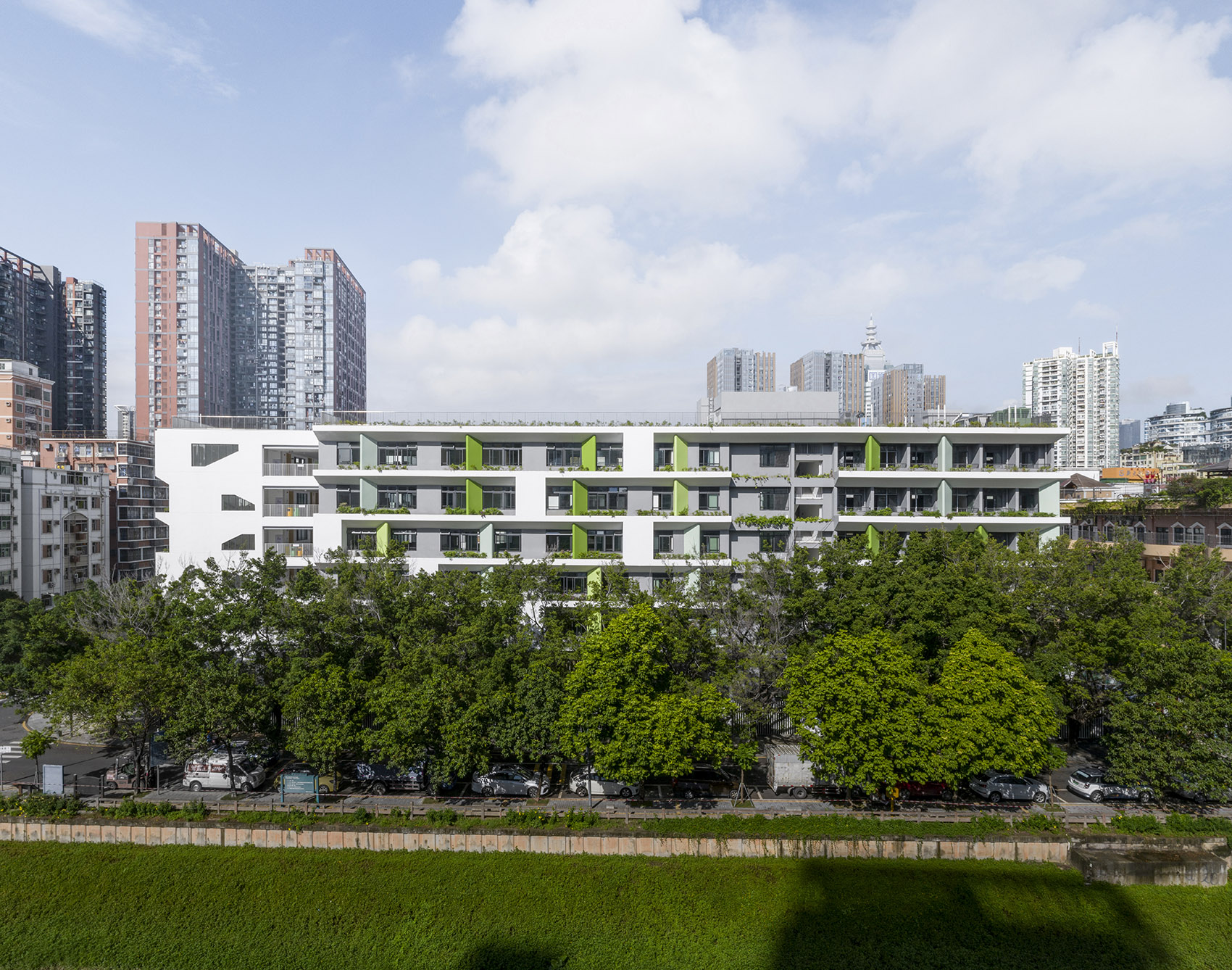
▼沿街立面夜景,Façade nightscape along the street ©陈维忠(绿风建筑摄影)
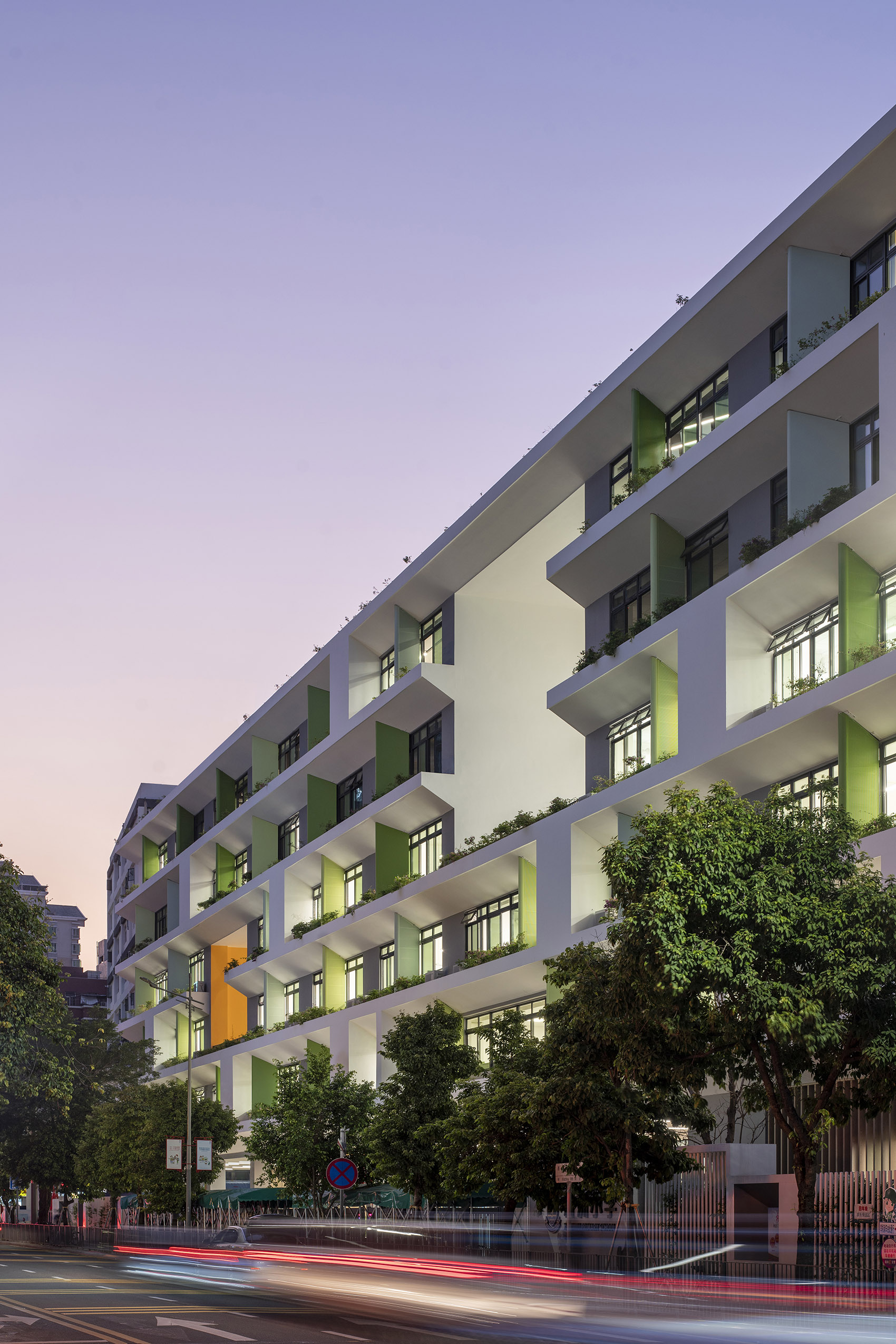
▼校园与城市肌理,Drawings and analysis ©东意建筑

▼总平面图,Site plan ©东意建筑

▼负一层平面图,basement floor ©东意建筑
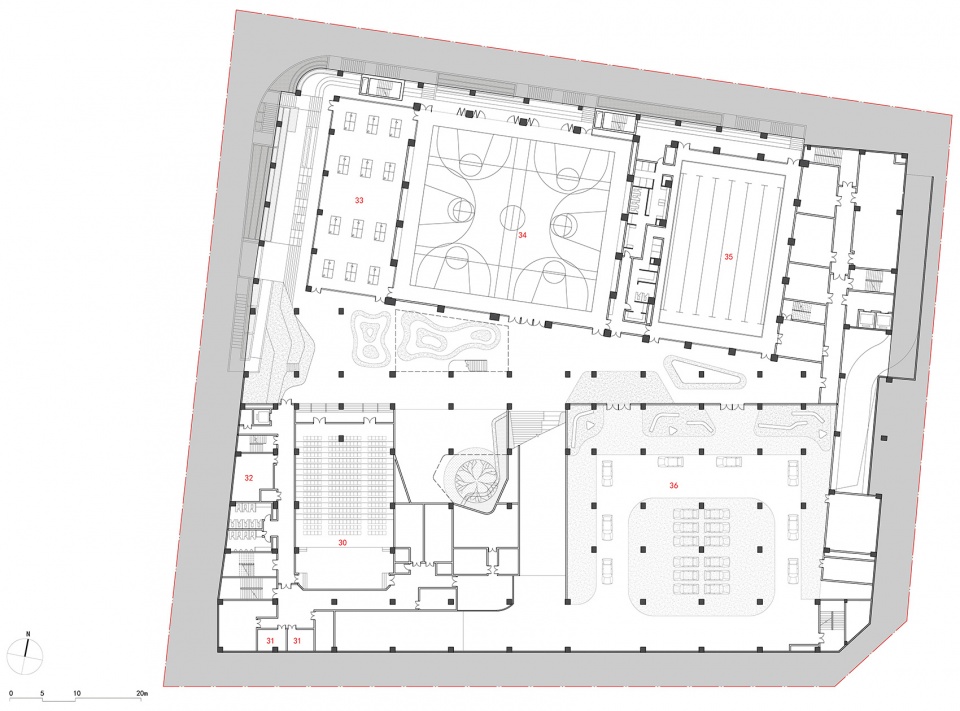
▼首层平面图,Ground floor plan ©东意建筑
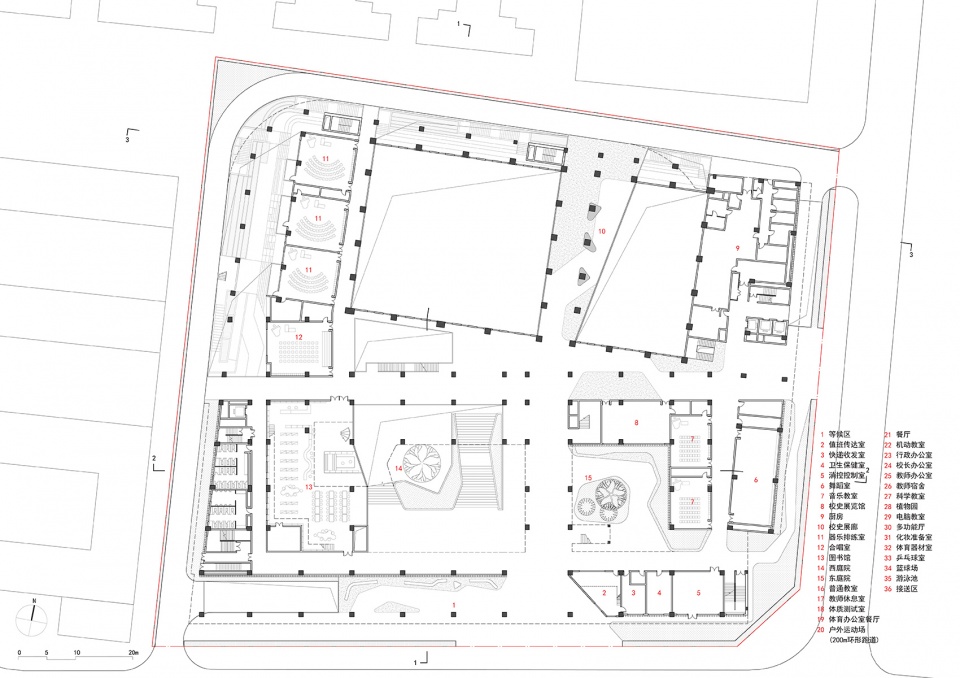
▼东西向剖面图,East to west section ©东意建筑
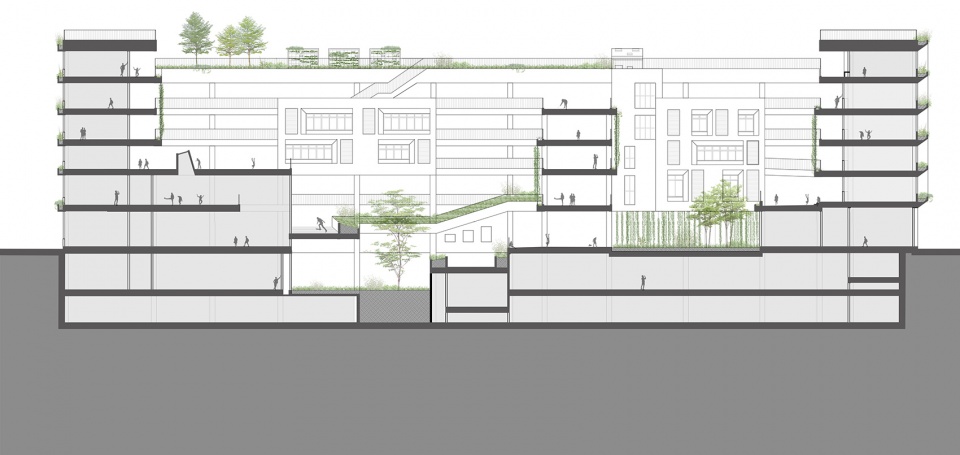
▼南北向剖面图,North to south section ©东意建筑
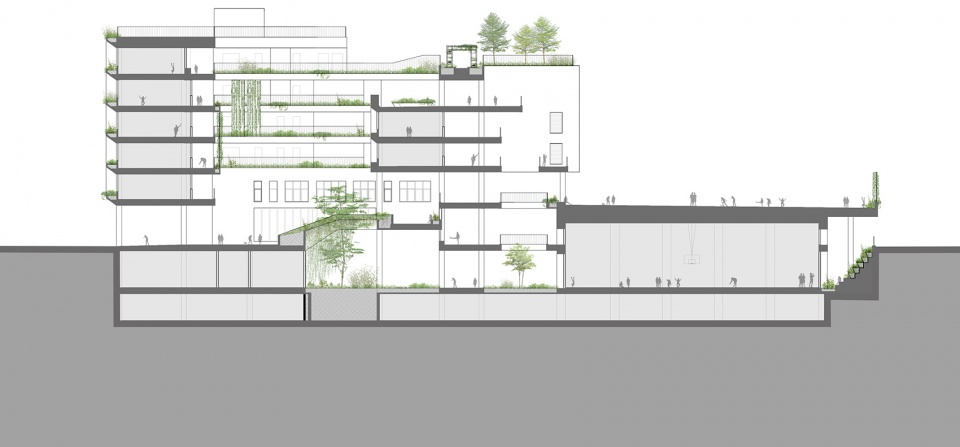
▼体育馆与游泳馆剖面图,Section of swimming pool and indoor stadium ©东意建筑
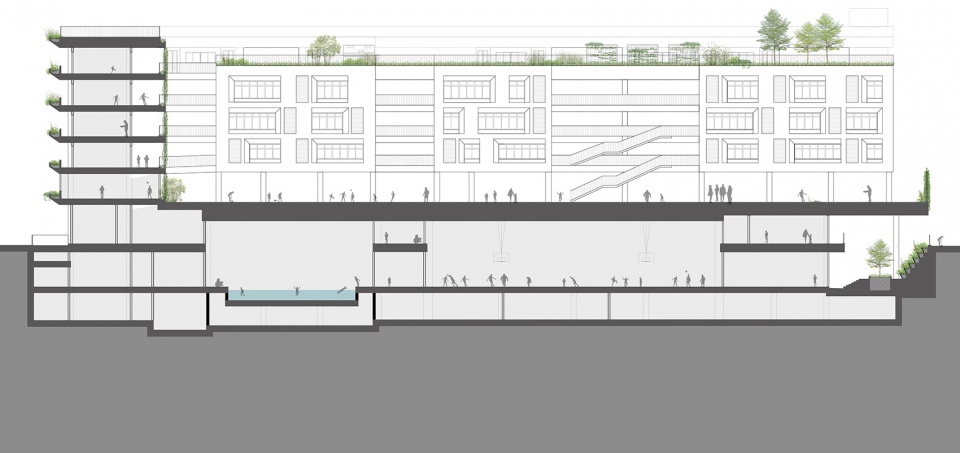
▼立面通风隔声绿化系统整合,Integration of facade ventilation and sound insulation in greening system ©东意建筑
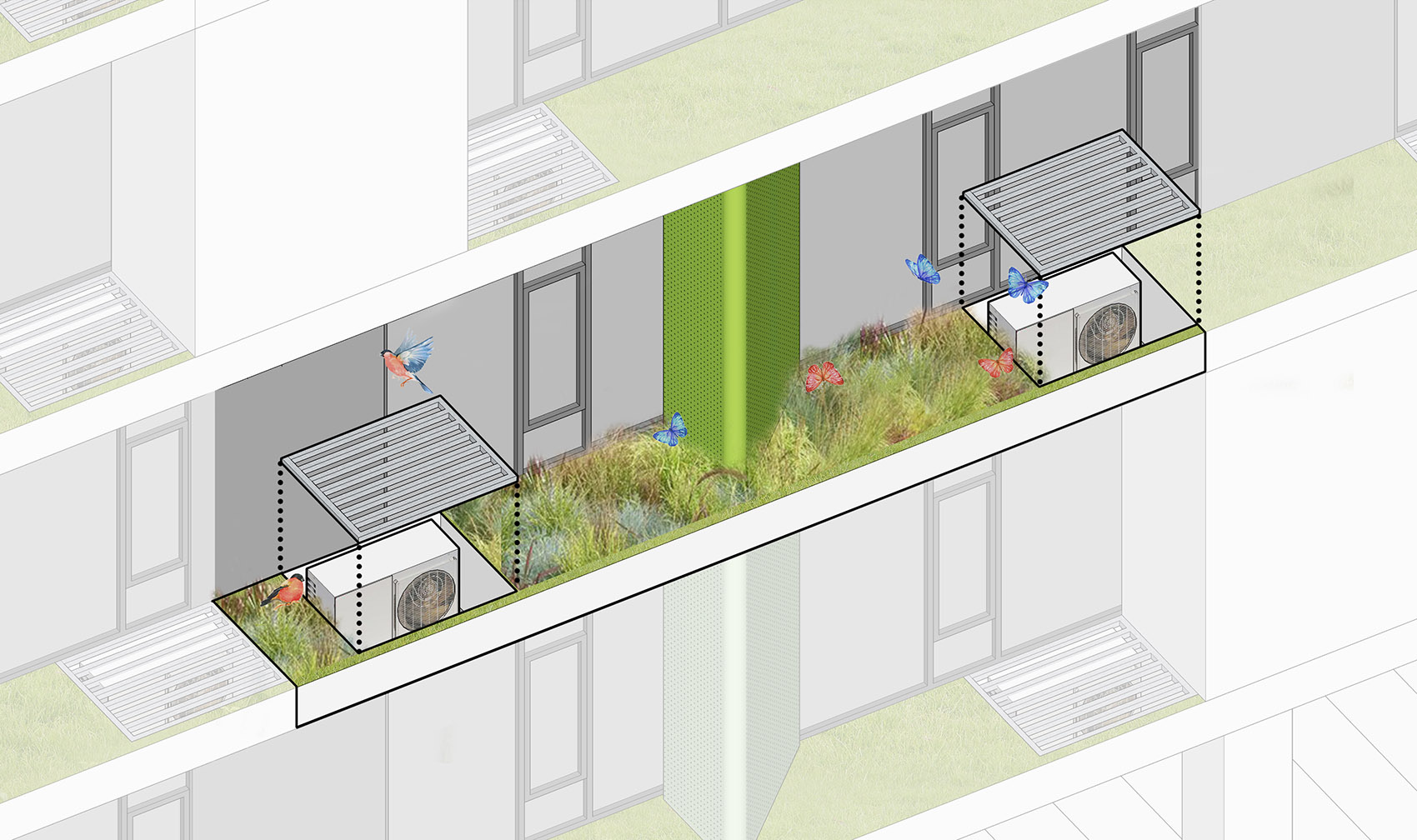
▼立面绿化与悬挑斜板降噪作用 ©东意建筑 The noise reduction effect of facade greening and cantilever inclined plate
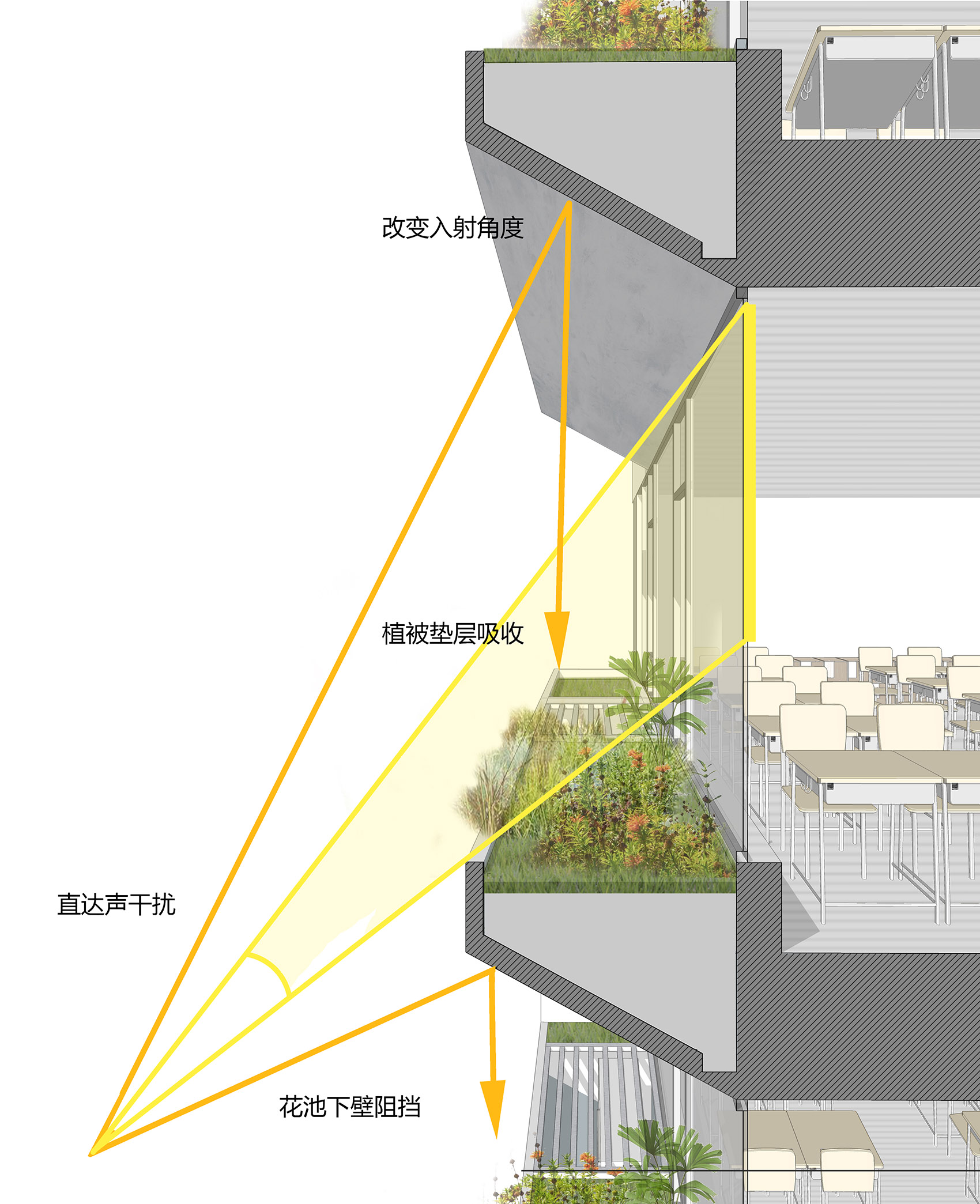
▼通风隔声构造,Ventilated sound insulation structure ©东意建筑
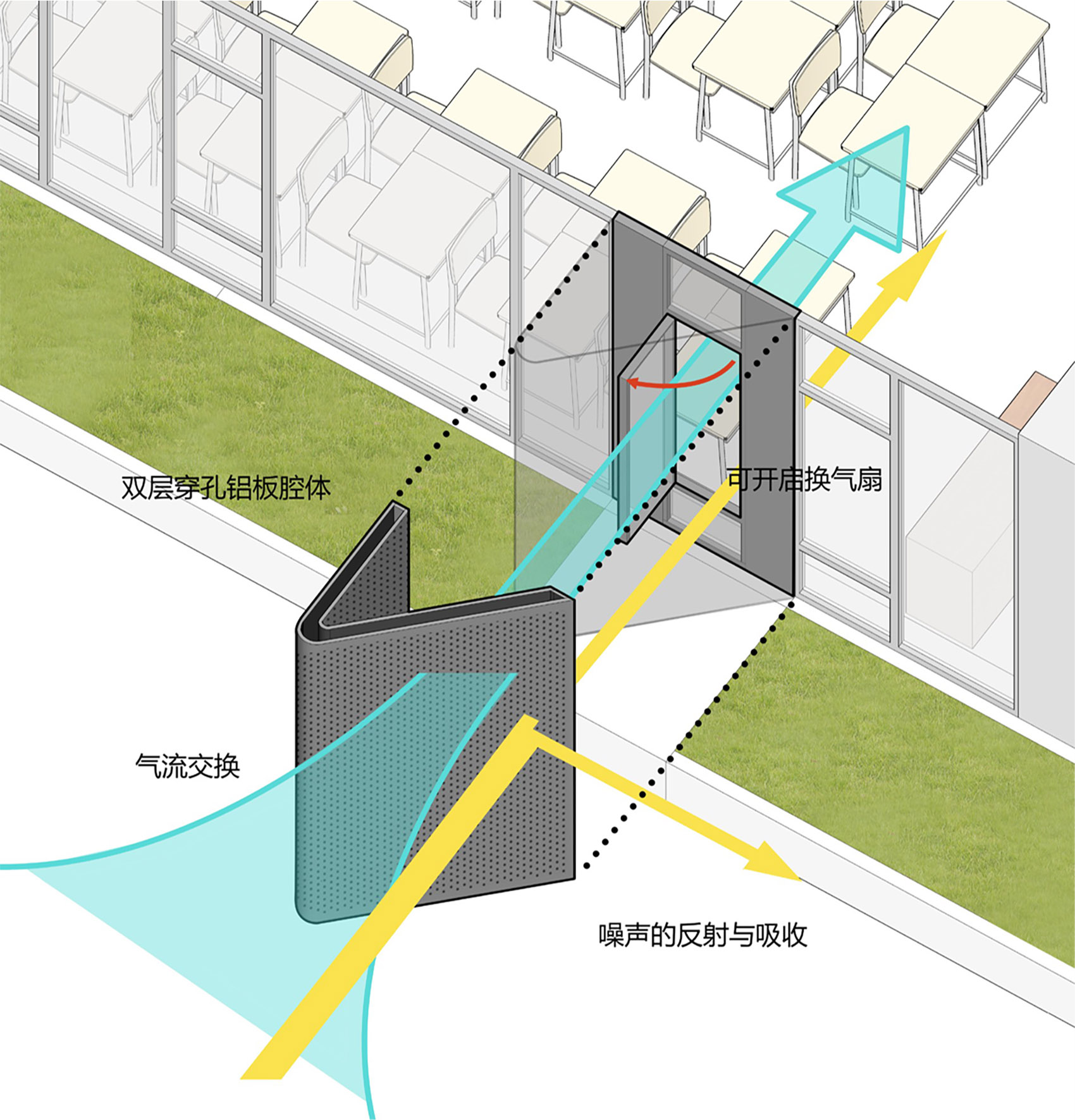
项目名称:新洲小学整体拆除重建工程 设计单位:东意建筑 项目地点:深圳市福田区新洲九街新洲南路 基地面积:10 633平方米 建筑面积:38 030平方米 设计时间:2018年3月 施工时间:;2018年8月动工 ,2020年9月交付
业主:深圳市福田区教育局 主持建筑师:肖毅强、肖毅志、邹艳婷 设计团队:杨远景、陈培笑、郑泽旭、洪宇东、隋佳音、杨宗祥、何亚洁、唐帅、马智超 代建单位:深圳市万科城市建设管理有限公司 施工单位:中建三局 施工图设计:深圳市天华建筑设计有限公司,GND设计集团,深圳界内界外设计有限公司 材料:白色涂料、铝合金穿孔板、现浇水磨石 结构:钢筋混凝土框架结构、局部钢结构
摄影师:陈维忠(绿风建筑摄影)
Project Name: Overall Demolition and Reconstruction Project of Xinzhou Primary School Design: Atelier Y location: Xinzhou South Road, Xinzhou 9th Street, Futian District, Shenzhen Base area: 10 633 m2 Building area: 38 030 m2 Design time: 2018.03 Construction time: 2018.08 to 2020.09
Owner: Shenzhen Futian District Education Bureau Chief architects: XIAO Yiqiang, XIAO Yizhi, ZOU Yanting Design team: YANG Yuanjing, CHEN Peixiao, ZHENG Zexu, HONG Yudong, SUI Jiayin, YANG Zongxiang, HE Yajie, TANG Shuai, MA Zhichao Agent construction unit: Shenzhen Vanke Urban Construction Management Co., Ltd. Construction unit: China Construction Third Engineering Bureau Co., LTD Construction drawing design: Shenzhen Tianhua Architectural Design Co., Ltd., GND Design Group, Shenzhen JNJW Design Studio.
Material: white paint, aluminum alloy perforated plate, cast-in-place terrazzo Structure: reinforced concrete frame structure, partial steel structure
Photo:CHEN Weizhong(Lvfeng Architecture Photography)

